INTERNATIONAL CHORAL MAGAZINE
FOCUS LIVING ROOTS THROUGH CHORAL MUSIC
NAGAMO CHOIR PROJECT IN CANADA: EXCHANGING MUSIC TRADITIONS FOR A RESPECTFUL FUTURE
FROM THE WAHA TO THE WAHAROA
LIVING ROOTS THROUGH CHORAL MUSIC IN BULGARIA
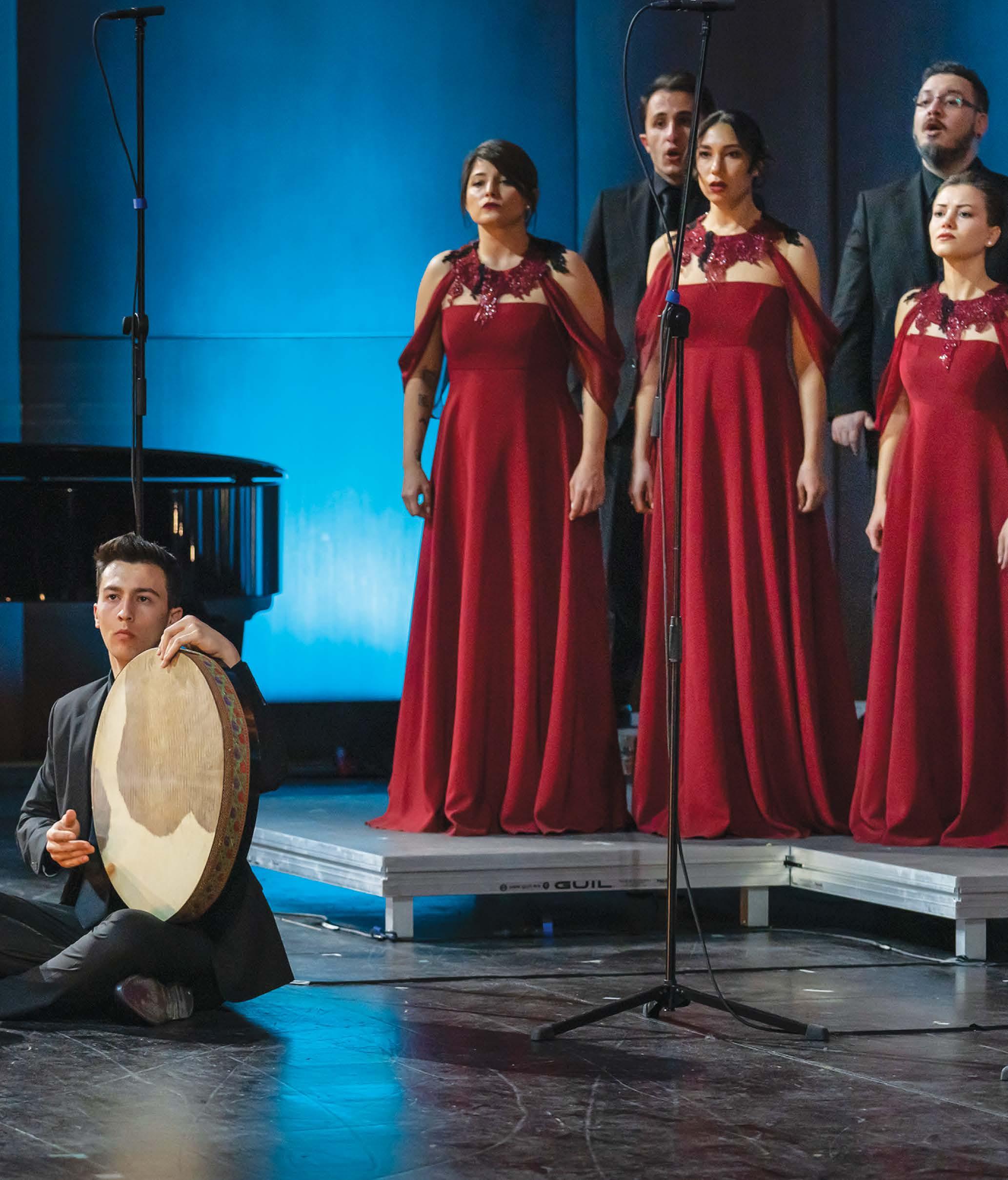
VOLUME XLII NUMBER 3 ISSN - 0896-0968
3rd Quarter, 2023
JULY 2023
DESIGN & CONTENT COPYRIGHT © International Federation for Choral Music
PRINTED BY PixartPrinting.it, Italy
SUBMITTING MATERIAL
When submitting documents to be considered for publication, please provide articles by Email or through http://icb.ifcm.net/en_US/ proposeanarticle/. The following electronic file formats are accepted: Text, RTF or Microsoft Word (version 97 or higher).
Images must be in GIF, EPS, TIFF or JPEG format and be at least 300dpi. Articles may be submitted in one or more of these languages: English, French, German, Spanish.
REPRINTS
Articles may be reproduced for non commercial purposes once permission has been granted by the managing editor and the author.
MEMBERSHIP FEES
Membership fees are calculated following the United Nations Human Development Index, and are payable in Euro or Dollars with credit card (VISA, MASTERCARD, AMERICAN EXPRESS, PAYPAL), or bank transfer, to IFCM. For more information, please consult the IFCM membership page at https://www.ifcm.net/
PRINTED COPIES
For Members (with basic membership): US$ 40.00 (36 Euros) per year. Included in other memberships. For Associates and non-Members: US$ 60.00 (53 Euros) per year. For a single copy, contact the office.
THE VIEWS EXPRESSED BY THE AUTHORS ARE NOT NECESSARILY THOSE OF IFCM
CONTENTS
3rd Quarter 2023 — Volume XLII, Number 3
EDITORIAL
Emily Kuo Vong
FOCUS: LIVING ROOTS THROUGH CHORAL MUSIC ROOTS AND TRADITIONS ALIVE THANKS TO CHORAL MUSIC
Isabela Sekeff
NAGAMO CHOIR PROJECT IN CANADA: EXCHANGING MUSIC TRADITIONS FOR A RESPECTFUL FUTURE
Interview by Isabelle Métrope FROM THE WAHA TO THE WAHAROA THE LESSONS WE’RE LEARNING IN AOTEAROA ABOUT THE CHALLENGES OF THE AESTHETICS OF SPACE
Robert W īremu
PHILIPPINE (CH)ORAL TRADITIONS: GROUP SINGING IN CULTURAL PRACTICES OF THE CORDILLERA REGIONS
Arjay Viray
LIVING ROOTS THROUGH CHORAL MUSIC IN BULGARIA
Theodora Pavlovitch
THE SÁMI MUSIC
Annukka Hirvasvuopio-Laiti HAS “WHITENESS” LIMITED THE IMAGINATION OF WESTERN CHORAL MUSIC?
Thomas Lloyd
IFCM NEWS
MESSAGE FROM THE PRESIDENT
Emily Kuo Vong
IFCM WELCOMES A NEW BOARD AND AN NEW EDITORIAL BOARD
Press Release
CHANGING HORIZONS OF THE CHORAL WORLD AT THE CROSSROADS OF WEST AND EAST
Tisa Mrhar
REFLECTION ON MY YOUNG PROGRAMME EXPERIENCE
Brydon Sundgren
TRIBUTE TO H. ROYCE SALTZMAN
WORLD CHORAL DAY: SCORE OF THE IFCM COMPOSITION COMPETITION 2022
CHORAL WORLD NEWS
SOARING NEW HEIGHTS: TRANSITIONING CHORAL PERFORMANCE FROM SCREEN TO STAGE
Maria Theresa Vizconde-Roldan
COMPOSER'S CORNER
INTERVIEW WITH TAKATOMI NOBUNAGA
by Isabelle Métrope
CHORAL TECHNIQUE
FROM THE THREE DIFFERENT MAJOR SECONDS TO THE HANDSIGNS – FOCUS ON PURE INTONATION
Ildikó Ferencziné Ács
SCORE REVIEW
MARTÍN PALMERI: NISI DOMINUS (PSALM 127)
Reijo Kekkonen
REPERTOIRE
CHORAL TREATMENT: 7 CHORAL WORKS FROM CORDILLERA, PHILIPPINES TO INCLUDE IN YOUR NEXT PROGRAMME
Arjay Viray SPONSORS INDEX
1 3 6 10 13 16 18 20 25 26 27 32 35 40 47 51 55 63 67 69
MAGAZINE
INTERNATIONAL CHORAL
Cover:
Nilüfer Polyphonic Choir, dir. Zeynep Göknur Yldiz (Türkiye) at the WSCM 2023 © Gülcan Acar
EDITORIAL
EMILY KUO VONG IFCM President

Choral music has always played a prominent role in people’s musical life, as it is the most popular way to access performances and arts for both adults and children. Choral singing and listening to music is intrinsic to all cultures and allows the soul to express the heart in perfect harmony. This is the kind of symbol that we need in today’s world. Therefore, beyond all doubts, choral music can help people in mutual understanding and living roots in a diverse social environment.
Research has shown for some time that singing in a choir not only brings tremendous benefits to individuals’ physical and mental wellbeing, but it also strengthens feelings of solidarity in the community. We all know that choral music can affect our moods and happiness and reduce stress levels and depression. That is because to create phrasing and musical expression, singers develop breathing techniques that produce many physical benefits, such as increased blood flow, improved
INTERNATIONAL CHORAL MAGAZINE
EDITORIAL BOARD
Roula Abou Baker, Jill Campbell, Ana Patricia Carbajal Córdova, Ulrika
Emanuelsson, Victoria Liedbergius, Lucien Mendy, Isabelle Métrope, Beatrice Bonfè, Rossana Paliaga, Tomoko Yokoyama
MANAGING EDITOR
Isabelle Métrope: choralmagazine@ifcm.net
EDITOR
EMERITA Jutta Tagger
sleeping, boosted immune system, and the release of positive hormones, including endorphins, dopamine and oxytocin.
Moreover, human beings are born with rhythm sensations and a need for togetherness. As an inclusive activity, everyone can be equal and connected by choral singing. We all realize that we bond best when we are singing in the choir with each other. Thus, compared to other social activities, people enjoy a greater feeling of solidarity in choral life and of being part of a collective endeavor. Meanwhile, choirs truly know what teamwork means. Preparing for concerts not only requires the discipline of attending weekly rehearsals, but it also develops the skills of listening, concentration, teamwork, and selfconfidence. Choirs bring people together with a sense of purpose.
As a result, choral music is helping to bridge social gaps. Choral groups and singers in a choir are diverse in the broadest sense: involving people from every region
REGULAR COLLABORATORS
ENGLISH TEAM Mirella Biagi, Laura Massey
FRENCH TEAM Barbara Pissane
GERMAN TEAM Lore Auerbach
SPANISH TEAM Vania Romero
LAYOUT Nadine Robin
MAGAZINE ONLINE EDITION AND TRANSLATIONS
https://www.ifcm.net/
of all ages, in numerous musical styles from classical to gospel. Choral singing makes people more aware of different people’s life experiences and improves our empathy and respect for each other.
Choral music is an art, entertainment, pleasure, and medicine for the body and soul. Choral singing increases selfesteem and confidence, reduces anger and depression, enhances mental awareness, and stimulates creativity thus improving overall wellbeing. But most of all it is fun and rewarding, bringing people deeper into the wider world. In this issue of the International Choral Magazine, you will read many articles that demonstrate how people live roots through choral music in different areas all over the world.
PUBLISHER
International Federation for Choral Music MEMBERSHIP AND SPONSORING

IFCM International Choral Magazine 9901 Brodie Lane, Suite 160 PMB1524, Austin, TX 78748
Email: office@ifcm.net
Website: https://www.ifcm.net/
1
FOCUS: LIVING ROOTS THROUGH CHORAL MUSIC
ROOTS AND TRADITIONS ALIVE THANKS TO CHORAL MUSIC
Isabela Sekeff
NAGAMO CHOIR PROJECT IN CANADA: EXCHANGING MUSIC TRADITIONS FOR A RESPECTFUL FUTURE
Interview by Isabelle Métrope
FROM THE WAHA TO THE WAHAROA
THE LESSONS WE’RE LEARNING IN AOTEAROA ABOUT THE CHALLENGES OF THE AESTHETICS OF SPACE
Robert Wīremu
PHILIPPINE (CH)ORAL TRADITIONS: GROUP SINGING IN CULTURAL PRACTICES OF THE CORDILLERA REGIONS
Arjay Viray
LIVING ROOTS THROUGH CHORAL MUSIC IN BULGARIA
Theodora Pavlovitch
THE SÁMI MUSIC
Annukka Hirvasvuopio-Laiti

HAS “WHITENESS” LIMITED THE IMAGINATION OF WESTERN CHORAL MUSIC?
Thomas Lloyd
2
FOCUS
© Chekat (iStock)
ROOTS AND TRADITIONS ALIVE THANKS TO CHORAL MUSIC
ISABELA SEKEFF
Music therapist, teacher and choral conductor, Brazil
CHORAL SINGING IS PRESENT IN MANY ETHNIC GROUPS AND CULTURES AROUND THE WORLD, REGARDLESS OF THE HISTORICAL PERIOD, STYLE, OR FUNCTION FOR WHICH IT IS INTENDED. ITS PRACTICE APPEARS FROM ANTIQUITY TO THE PRESENT DAY, RANGING FROM COLLECTIVE SINGING FOR RELIGIOUS CELEBRATIONS, TO FESTIVE AND WORK RITUALS, TO GROUPS OF ELABORATE ARTISTIC PERFORMANCE. DESPITE ITS OFTEN SPONTANEOUS AND INTUITIVE MANIFESTATION, WHEREVER IT OCCURS CHORAL SINGING BECOMES THE MATERIALIZATION OF ONE OF THE MOST EFFICIENT INSTRUMENTS OF MEMORY, MAINTENANCE, AND THE DISSEMINATION OF ROOTS, AND ALSO OF SOCIAL, CULTURAL, AND ARTISTIC TRADITIONS.
In the history of Western music, it is possible to identify clearly how the use of choral music presents the main characteristics and practices related to each artistic period. In ancient Greece we had the choros: groups of singers and dancers who wore masks and performed monophonic songs. These singers interpreted important parts of Greek drama, which, in turn, evolved from religious ceremonies. Jewish culture, another pre-Christian culture, has records of a structured choral practice accompanied by instruments, performed in both religious and festive ceremonies. Plainchant, the main musical reference of the Middle Ages, gives us a better understanding and perception of medieval man through its characteristic melodies and its free rhythm linked to the text. In the Renaissance, we see the beginning of different perspectives, through polyphony and its various layers, and we also see choral singing begin to be used in its secular manifestation through madrigals, chansons, and other secular musical forms. Vocal forms multiplied all around, giving rise to operas, cantatas, oratorios, choral song cycles, part-songs and so many different forms. In each
period of history, we have a living example of how choral singing both reflected and revealed societal values, patterns, and thoughts of the time.
However, it is not just within the broad lines of the history of Western music that choral singing becomes a reference for the context and understanding of human beings and their social, cultural, and human relationships. The practice of choral singing is deeply rooted within small cultures, in popular manifestations, in the infinite stories that are not fully told and in the realities that have not become generalized. It is the memory of popular songs, disseminated in various social activities, which carry relationships with life, ways of loving and living, the different faces of a society. There are folk songs which keep alive the fantastic legends and the collective imagination. There are work songs, celebratory songs, and ritualistic songs which put us in touch with the undercurrents of its culture and society. And it is through these artistic practices that different traditions are perpetuated, not only artistic and musical traditions, but also ethno-musicological, linguistic and historic traditions.
From the ethno-musicological point of view, choral singing is fundamental for understanding the traditions of a people: their identifying elements are organized, transmitted, and maintained through festivities and rites. Such elements include the meaning of the text, stories that are told, and historical records. Further, body performance characteristics such as dances, costumes, and even scenery are items that are internalized in each culture’s choral performances. It is necessary to abstract the concept of purely artistic performance in order to understand in depth the ethno-musicological value of this practice. The quality or technique of the performance is not in question here, but rather the traditions and customs that are perpetuated. It is the living culture present in that manifestation.
The linguistic issue is also a point to be analyzed in the maintenance of roots and traditions through choral singing. Since it is a sung practice, there is necessarily a record of its original languages. As a result, the practice of choral singing becomes valuable in the dissemination of different languages, regional dialects, and minority languages. In addition to the written record
3
Artikel auf Deutsch Article en français Artículo en español
of the language, the choir can also offer the sound reference of the language, its pronunciation and accent.
In Brazil, we have many examples of how the practice of choral singing can be an instrument for the conservation and dissemination of these roots and traditions.
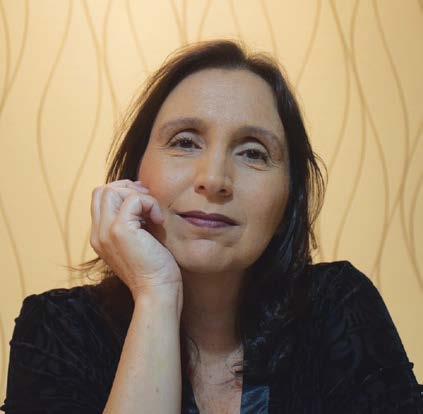
Composer Waldemar Henrique, born in northern Brazil in 1905, dedicated a large part of his work to themes linked to his native region: the Amazon. Among his works, there is a series of eleven songs called Lendas Amazônicas, which narrate the fantastic and imaginary folkloric figures that inhabit the forests in this region of the country. In 2016, André Vidal, a Brazilian composer and arranger, arranged nine of these songs for chorus. Folk themes such as these, which are often disseminated through oral tradition, became permanently recorded through this work.
Another practical example takes us to the research work of the singer and composer Renata Mattar. Renata, born in the city of São Paulo (1969), collects and records work songs in Brazil. These are centuries-old songs from rural communities in the interior of Brazil, passed down orally from one generation to another, sung with voices and performed during different work practices.
Brazil records, even today, more than two hundred indigenous dialects spoken by different ethnic groups. Several composers wrote works in these original languages that, somehow, are perpetuated and spread through these works. Composer Heitor Villa-Lobos gave us Duas Lendas Ameríndias em Nheengatu, written in this dialect derived from Tupinambá and spoken in the Amazon region. In addition to the marked indigenous influence, Brazil also has a notable record of African culture. There are countless choral songs that are written in Afro-Brazilian dialects and aesthetics.
Just like these examples, each culture preserves numerous records of compositions and arrangements (elaborated or spontaneous) that perpetuate our memories, legends, dances, rituals, poetry, stories, and all those unique and symbolic traditions that make each of us authentic peoples.

There is no doubt that choral singing is a great instrument for maintaining the traditions of a people. As conductors, we must recognize and understand this role. On the one hand we have a cultural universe at our disposal; on the other hand we also have an obligation to value and disseminate our own culture, promoting our roots and strengthening our own identities.
Edited by Gillian Forlivesi Heywood, Italy/UK
ISABELA SEKEFF is a PhD student in music at UNICAMP, Master in Choral Conducting at the University of Missouri, United States, Specialist in Music Therapy at the Brazilian Conservatory of Music in Rio de Janeiro and Licensed in Music Education at the University of Brasília. Sekeff is currently a Substitute Professor at the University of Brasilia in the Chair of Conducting and Musical Structuring since 2021. She worked at the Brasília Music School for thirty years, where she also served as Coordinator and Pedagogical Supervisor. She was principal conductor of Madrigal de Brasília from 2018 to 2021, a professional choir formed by teachers and students of the Brasília Music School. She is principal conductor of Coral Cantus Firmus, an independent group that she founded in 1992 and which is among the best groups in Brazil. isabelasekeff@gmail.com
4
FOCUS
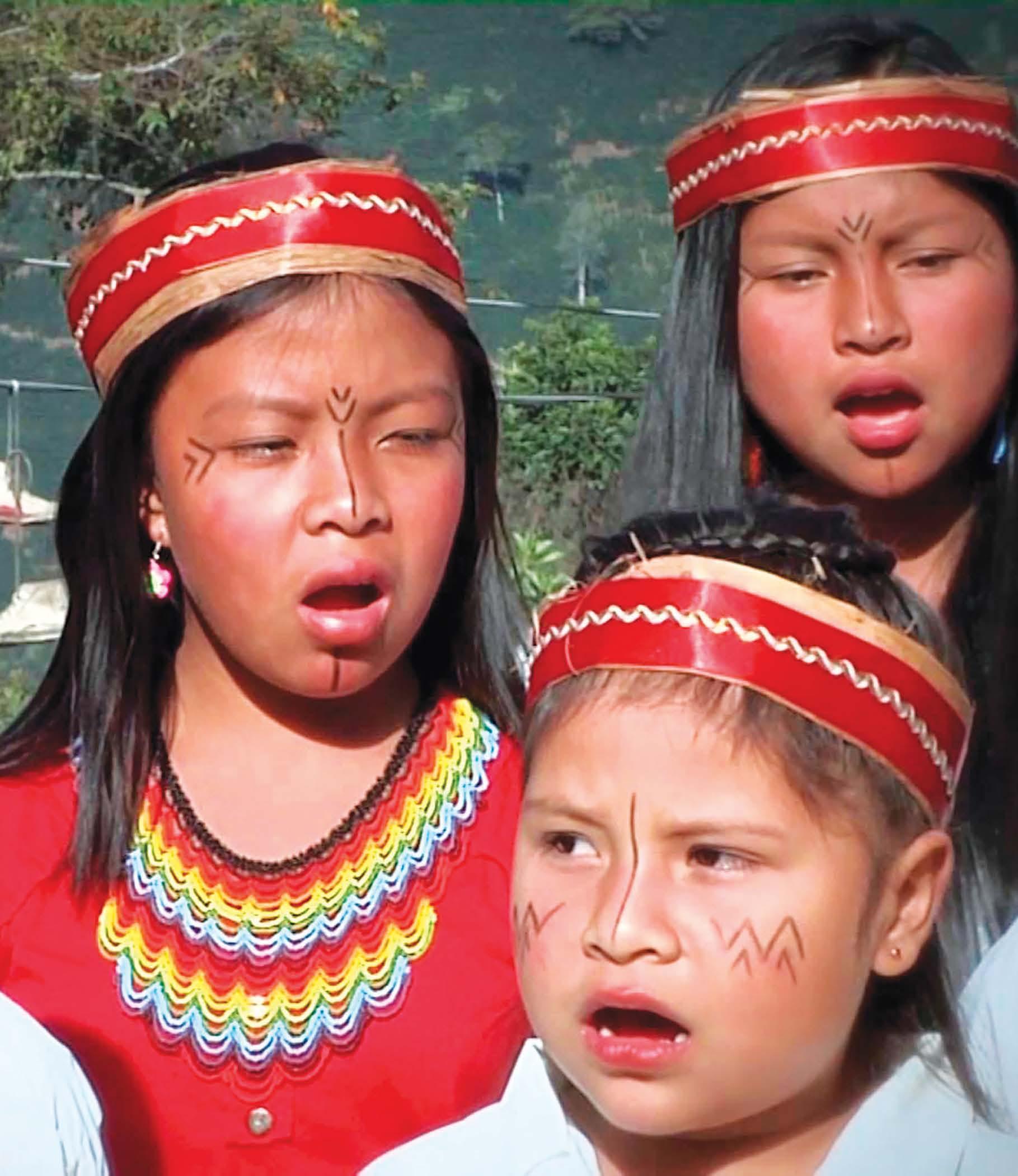

5
NAGAMO CHOIR PROJECT IN CANADA: EXCHANGING MUSIC TRADITIONS FOR A RESPECTFUL FUTURE
INTERVIEW BY ISABELLE MÉTROPE International Choral Magazine Managing Editor
NAGAMO IS A CHOIR COOPERATION PROJECT BETWEEN MUSICA INTIMA, SHALLAWAY YOUTH CHOIR, KORORA (PREVIOUSLY CALLED KOKOPELLI) CHOIRS AND SEVERAL SOLO SINGERS PERFORMING TOGETHER ANDREW BALFOUR’S NAGAMO, A ONE-OF-A-KIND PIECE OF MUSIC INCORPORATING ENGLISH RENAISSANCE AND CANADIAN INDIGENOUS CULTURES.
Can you describe the NAGAMO project in 3 lines?
Jacob Gramit (JG), musica intima: At its core, NAGAMO is an idea: Andrew’s fantastical imagining of how cultural sharing could have better unfolded between settlers and Indigenous peoples. This idea is represented in the music, in the concert structure, in the collaborations with other ensembles and artists; but essentially it is a step towards choral reconciliation.
Scott Leithead (SL), Korora choirs: Regarding the piece of music itself, NAGAMO is a reimagining of works of the English Renaissance choral canon as viewed through the lens of Indigenous spirituality.

Andrew Balfour considers it an exploration of an alternate version of History in which settlers and Indigenous people built upon early relations that were founded in mutual respect and honour.
What is the message of NAGAMO?
SL: NAGAMO shows us that there’s an opportunity in Canadian choral music to build a new choral canon that brings together Indigenous languages and voices with our pre-existing colonial choral traditions, to move forward together in a way that is reconciling.
JG: Over the course of the performances, we explore themes of welcoming, struggle, mourning, and ultimately hope. So I hope the audience leaves both challenged and fulfilled – but also asking what they can do in their own lives to decolonize, be it through art or business or anything.
What was the impulsion behind the birth of NAGAMO?
JG: Andrew shared an idea of translating music of William Byrd into Indigenous languages, and musica intima was thrilled by the idea. We basically told Andrew we wanted to do this project, whatever it
looked like – and he developed the concept, repertoire, and everything from that point. It began as a one-off concert in Vancouver, and we quickly realized how much it could grow, so we made the recording and we began planning the first cross-Canada tour.
What is the structure of the piece regarding the different actors – choirs, soloists, drummers group?
JG: Beyond just a concert, Andrew wanted to create a larger event – he introduced the concert as a ‘ceremony of healing and respect’ – and part of that was him suggesting we invite local song-keepers,
6 DOSSIER FOCUS
Nagamo poster by Sonny Assu
Artikel auf Deutsch
Article en français Artículo en español
from wherever we were, to be a thread throughout the evening. In Vancouver we were lucky to partner with Lexwst’í:lem, a local drum group, and across the country we worked with Cory Campbell, Rosary Spence, Sherryl Sewepagaham and Deantha Edmunds (presenting some of their own music as both soloists and in concert with our combined choirs). As we planned the tour, we wanted to ensure it wasn’t just musica intima parachuting in, so we worked to connect with youth-based institutions in each place, creating collaboration on another level. We worked with the Toronto Children’s Chorus and Youth Choir, ensembles at Western University, Shallaway Youth Choir, the University of Manitoba, and Korora Choirs, and in each place, we learned so much from the young singers and I know they learned so much from working with Andrew first-hand. The events that were created at the end of each period of workshops were all so special – these beautiful collaborations showcasing so many different artists, but all coming together to create the music and ideas at the heart of NAGAMO.
SL: Joining musica intima on a few of Andrew’s works, including some from NAGAMO, let us explore Andrew’s vision as well as experience singing in Ojibway while
performing music from the English Renaissance. We also opened each concert with a greeting, blessing and land acknowledgement provided by a local Indigenous elder.
What are the themes of the music pieces included in NAGAMO?
SL: Andrew Balfour describes the text as exploring and expressing Indigenous spirituality, while also acknowledging the resonance between the original texts of the pieces (most of which were in Latin, but some in English) and the text Andrew has set.
What were the expectations of musica intima / Korora / Shallaway before entering the cooperation?
JG: We didn’t really know what to expect, either from the beginning of the project or the beginning of the tour! But Andrew came and so seamlessly worked with musica intima. It didn’t feel like a ‘guest director’ as much as that was his role – it was really just like we had a thirteenth member in the room. We were

7
The CD NAGAMO, released 2022, is available at musicaintima.org, or on streaming services around the world.
musica intima
lucky enough by the end of the tour that Andrew was singing with us in performances, it really felt like we all belonged together in such a beautiful and organic way.
How did the choir singers – and their conductors! –experience the project?
SL: Our singers described their time with Andrew as breathing spirit into the music which felt, before we had the chance to work with him, a little unfamiliar and distant from their lived experience. Some of our singers were more familiar with the style and genre of English Renaissance polyphony, while some of our younger members were newer to it, but all agreed that they loved Andrew’s version of the works and felt a new and different connection to the music afterwards.
JG: I’ve heard from so many singers in musica intima that this was one of their favourite projects they’ve ever been part of. The work Andrew created was so wonderful to sing and share in, and coming back to the ideas and the repertoire again over such a long period was a unique opportunity in the professional choral world. One of our singers, Katherine Evans, talked about the texts Andrew chose: “The texts Andrew chose had a different specific meaning than the text of the original, but the universal meaning was really the same. And the fact that these texts were generally short and very evocative, and then I was able to sit with
them, and really sing them – I’m going to internalize that so much more easily… if you can sing them over a period of time and with music that is so beautiful and share it with other people… then it makes those words a part of me in a different way… I do think that once those words are in your heart, then they stay.”
SL: Most of the NAGAMO music was performed unconducted, which is intima’s tradition. This was a great challenge and opportunity for growth for our choirs, who are very accustomed to having one of us waving our arms! As conductors, we enjoyed watching our singers own their musicality and independence more thoroughly than they might usually need to do.
Which were the challenges for the choirs of singing this piece of music? Music-wise, language-wise?
SL: Prior to meeting with Andrew and musica intima, the challenges were twofold: firstly, that English Renaissance polyphony can be difficult, especially for younger and/or less experienced singers; secondly, we were working to understand the way in which Andrew’s Ojibway text would connect with the music of another age. Once we were working with musica intima and Andrew, we came to understand these connections and the focus turned to embodying the music in a joyful and grounded way.
JACOB GRAMIT is a Vancouver-based settler baritone, specialising in the music of the baroque and renaissance. After Early Music studies in the Netherlands, he returned to the stolen lands of the Musqueam, Squamish, and Tsleil-Waututh Nations, and to musica intima, with whom he has been the Artistic Manager since 2020. jacob@musicaintima.org (photo: Wendy D Photography)
Founded in 1992, musica intima is a collaborative and conductorless vocal ensemble which has championed Canadian music on stages around the world. Its shared leadership model allows twelve members to exchange ideas freely and explore individual musical creativity.
www.musicaintima.org
SCOTT LEITHEAD is the founder and Artistic Director of Edmonton's Kokopelli Choir Association. He has been invited to conduct provincial and state honour choirs on twenty-five occasions and he has presented workshops in North America and beyond. Notable appearances include adjudicating the Tampere International Festival in Finland; conducting the Ellison Canadian Honour Choir; and headlining the University of Toronto Summer Conducting Symposium. He has adjudicated both the Choral Canada Competition for Amateur Choirs and the Kathaumixw International Choir Festival.
Korora is the flagship ensemble of Edmonton’s Korora Choirs. Korora has received top rankings consistently on the Canadian national festival stage, but remains focused on training young singers while providing audiences with innovative musical performances. office@kororachoirs.ca

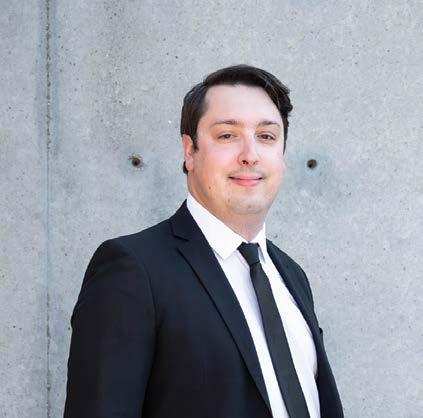
8 DOSSIER
In what manner can this project be setting a trend of reshaping the choral art?
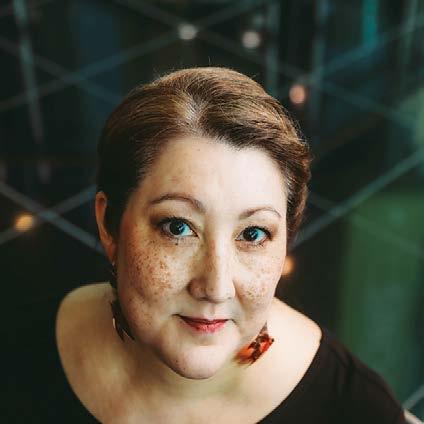
JG: It is my greatest hope that this project is permission for other ensembles to give away their control. We, musica intima, with our twelve artists, have always been afraid of outside curators. But that’s where the most exciting collaborations are; perspectives outside our own. For ensembles with one permanent Artistic Director, especially on Turtle Island (North America), we see this model: I challenge conductors to look outside their own ideas to create events with other artists. Of course, repertoire is a huge part of that – who isn’t represented on your programs? But collaboration with other artists is so fulfilling – I wish that joy on all choristers and artistic leaders.
Are there future concerts or cooperations planned?
JG: I hope the future holds many more collaborations between Andrew and musica intima – who knows what projects will crop up down the road. We’ve been talking about the close of this NAGAMO tour as only the end of the first chapter – but there’s still so many more places to take this project, which I know the future will hold.
Edited by Katie Maxfield, Canada
DEANTHA EDMUNDS
Soloist of NAGAMO
As for my part of the NAGAMO concert with musica intima, Shallaway Youth Choir and Ullugiagâtsuk, I sang a solo called Avani (meaning ‘up North’ in Inuttitut). I dedicated my performance to the youth of Ullugiagâtsuk who travelled from Nunatsiavut (the ancestral homelands of the Labrador Inuit) to join us in song. This song is about having courage, perseverance, and being proud of who you are and where you come from.
Reach to the ends of the earth!
trust.
Avani... Avani!
The song “Avani” is on Deantha’s recent award-winning album Connections
I also sang an original song called Legacy, as the soloist in a choral arrangement by Leslee Heys for string quartet and oboe accompaniment. I wrote this song to honor and uplift the voices of the Missing and Murdered Indigenous Women, Girls, and TwoSpirit + people. I wanted to let those lost and stolen sisters know that we will never forget them and we will carry on their love.
It was an honour and an incredible experience to perform this song as a soloist with the cooperation choirs, accompanied by the Atlantic String Quartet with oboist Annie Corrigan. We sang in English as well as the chorus in Inuttitut.
1 Inuttitut for ‘singing together forever... up North’
DEANTHA EDMUNDS is Canada’s first Inuk professional classical singer. Through performing, writing, and composing, she aims to empower Indigenous people and share their stories. Actively working on creating original works and mentoring young Indigenous artists, Deantha sings her heart out and turns heads across Canada & the world. deanthae@hotmail.com
(photo: Jennie Williams)
9
The concert we presented in St. John’s on March 11th was truly moving, for the performers as well as the audience.
The top of the mountain calls for you to rise above, dawn to dusk, with faith and
Tutsiak, IssoKangitumut, katinngak.1
The lessons we’re learning in Aotearoa about the challenges of the aesthetics of space
ROBERT W īREMU Conductor & Pedagogue, Auckland, New Zealand
IN 2020, I WAS HOPING TO HAVE WELCOMED YOU TO THE WORLD CHORAL SYMPOSIUM IN AUCKLAND, NEW ZEALAND WHERE I WAS PLANNING TO PRESENT TO YOU SOME IDEAS I’VE BEEN CONSIDERING
ABOUT SOUND, ABOUT SPACE. THE SYMPOSIUM WAS A HIGHLY ANTICIPATED OCCURRENCE THAT HAD NEVER BEEN HOSTED IN THE SOUTH PACIFIC BEFORE, AND HONESTLY A LOT OF DELEGATES WERE DRAWN BY – WHAT WE CALL – THE “LORD OF THE RINGS” FACTOR. UNFORTUNATELY, “SOMETHING” HAPPENED THAT FORCED ITS CANCELLATION… COVID! THE WORLD WENT ON A LONG SIESTA, SINGERS WERE AT A LOSS AND SINGING WAS SUDDENLY DEEMED DANGEROUS. CANCELLING THE SYMPOSIUM WAS A HEART-BREAKING DECISION, AND THESE IDEAS OF MINE WERE PUT ON HOLD… UNTIL NOW.
My talk would have been called
“From the waha to the waharoa” – “From the mouth to the gate”. It’s a reference to the phenomenon of the kaikāranga, the extraordinary callers whose voices “pierce” the divide between our world and that of our ancestors so that the protocols of the welcome ritual can be observed to be followed correctly. You would have witnessed these extraordinary sounds upon your arrival at the symposium. My choice to use the word “pierce” is not accidental. My hope is that “pierce” evokes an impression of the amazing sounds these people are capable of – how else do you invite the dead to witness the ceremony? Now, imagine what a sound like that would do to a venue like St Paul’s, London or San Marco, Venezia or Sagrada Familia, Barcelona?
That’s the cultural reference.
The musical reference of “From the waha to the waharoa” is less romantic, based on a series of provocations and some broad and blatant generalisations, none of
which I feel it necessary to apologise for. In an article of this length, details and rationalisations are a luxury, so generalisms abound.
Here goes…
If we assume that the basis for Western (European) choral music, the canon at the core of much of our musical activity, was designed for cathedrals, churches, and somewhat for stately houses, then perhaps we can also agree that – like the buildings – the sound aesthetic is tall, and contained, relying on reflective hard surfaces, in often cold climates. (I warned you about broad generalisations). Hard walls, tall spaces, cold climates clearly enable a particular sound. We know that sound. We often aim for that sound, whether we have the matching venues or not.
If we also assume that “choral” music aesthetics of other cultures, which were made for outdoor presentation in imperial courtyards, forecourts, and gardens, which often lack reflective walls, and are in warmer climates, that the sound is wider, less tall, warmer, and that the harmonic profile favours more reinforcement of the fundamental, then our imagination should easily conceive this. We know this sound in the Pacific, and in Asia, and in Africa, and in the Americas, even in Europe.
What do I mean when I describe sound as wide? I mean that the sound profile favours twang rather than head voice. I don’t mean folksy because that sends us in another direction completely. I’m referring to classical musics.
An interesting phenomenon has been unveiling in New Zealand over the past two decades, which has parallels in other parts of the world: these two things are coming together – outdoor sound with indoor choir! Under the bold and radical leadership of two of our leading choral conductors, Dr Karen Grylls and Elise Bradley, traditional Māori music is becoming an everyday aspect of our choral vernacular. Lead mostly by Grylls’ work with the NZ Youth Choir, the inclusion of authentic Māori music has completely changed the
10 FOCUS FROM THE WAHA TO THE WAHAROA
–
Artikel auf Deutsch Article en français Artículo en español
perspective of our choirs internationally. It’s almost expected – required – for touring NZ choirs to include Māori (and Pacific) music in their programmes. Audiences are somewhat disappointed when this doesn’t happen.
In earlier generations, composers “choralised” Māori songs – essentially using the source material of one culture and embedding it into the sound aesthetic of the other – the music was ‘walking to meet the choir’. Through Grylls and Bradley (in association with Wehi1, Cassidy-Nanai, Munro, Kaa, Cooper, Hoffmann, and Tata), the choir ‘walked to meet the music’. Paradigm flipped!
What do I mean by this? The music was learnt and presented authentically. Cassidy-Nanai2 trained the singers to haka3 and pukana4, to poi5 and parry6, and to sing with a sound aesthetic based on her modelling and her preferences: wider, and more of the fundamental, less use of head voice, as she had been taught.
If I can explain the problem from the opposite perspective: when choirs have occasion to sing on the ātea (the forecourt of the marae is a place for rhetoric, the domain of the God of War), the sound is often described as pretty but very quiet, and ghostlike –quite disembodied. The head-voice colour is lost in the open, without the assistance of tall, narrow spaces and hard, reflective surfaces. The problem for the NZ Youth
1 Ngāpō (Bub) and Pīmia (Nen) Wehi were the founders and leaders of Te Waka Huia, one of the premiere ensembles of its kind.
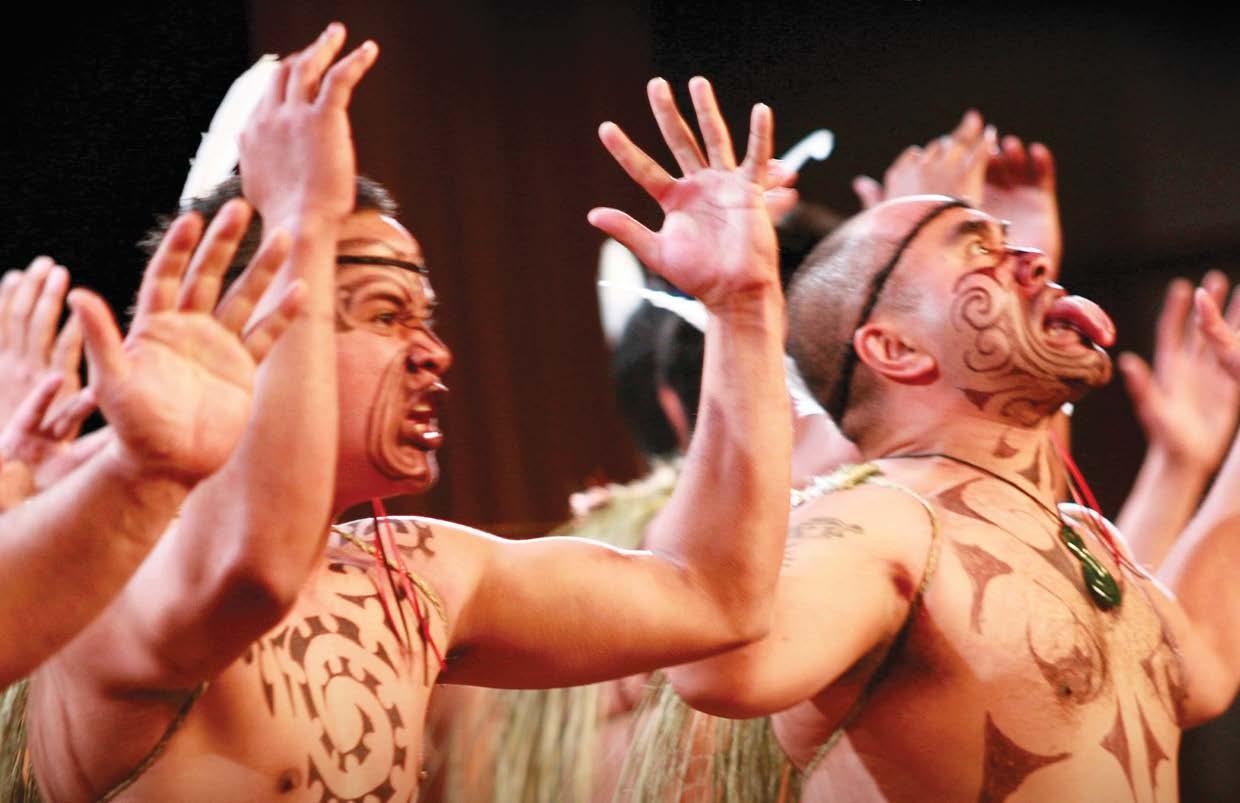
2 Aroha Cassidy-Nanai was a long-time member of the elite kapa haka, Te Waka Huia. She was a front-row performer, and due to this status was often recognisable by followers of the art form. She had been a teacher at secondary level and in that capacity, at Westlake Girls’ High School, met and collaborated with Elise Bradley. Through this connection, she became the Cultural Adviser for Choirs Aotearoa NZ under which the NZ Youth Choir is administered. Those of us that worked and learned with Aroha mourned her passing in 2022.
3 Haka is a genre of posed dances used for a variety of reasons. The most well-known variety of haka is war haka, illustrated by vigorous movements, as opposed to haka for flirting or haka for entertainment,
4 Pūkana are facial expressions used to illustrate and emphasise lyrics of songs in a variety of styles. These usually take quite distorted forms.
5 Poi are light weight balls that are attached to woven cords and swung as an element of certain types of song.
6 To parry, for Māori, is to wield a taiaha – a sort of carved spear.
Choir (the flipside of this paradigm) was that the wide, outside-ness, fundamental-oriented Māori sound often clashed with the containment of the tall, narrow venues where they often performed (on tours of the northern hemisphere: the cathedrals, the churches, the stately houses). Haka and kāranga qs et al, in ‘walking the choir all the way to the music’ perhaps we ‘took a few steps sideways’, resulting in a new aesthetic, a hybrid – with the genetic imprint of both parent artforms, yet an adolescent still, seeking its independence in a safe, new space in which to assert its own identity: some verticality, some use of head voice, a negotiation.
Do your choirs engage with indigenous music?
When your choirs engage with indigenous music, what do you do to maintain cultural integrity, authenticity? Do you ‘walk to where the music is’, or are you passive in your engagement? Did you also ‘take sideways steps’? Is it possible to go so far towards the music that we lose track of our own choral identity? Probably. But how do we find the middle ground unless we step out and test boundaries? Do we risk working directly against the acoustic of the space for the sake of the music? Sure, let the room work for you, until it works against you. What price do we pay for either?
In terms of sound, how do you manage a space when the repertoire has such varied requirements? A Bach chorale has different needs to a Wehi haka. Obviously? Are versatile venues the answer? No, I don’t think so. Versatile venues are good at everything by not being excellent at anything. We seek excellence, don’t we? (Apologies for offending acoustical engineers everywhere!)
Likewise, are half-measures good enough for choirs, or does that too risk authenticity?
11
WSCM 2020 Promotional Picture
I was so looking forward to sharing these ideas with you in Auckland, and the ensuing conversations afterwards. I was especially looking forward to the conversations afterwards because I know that many of these issues have already been considered by my colleagues globally. Your solutions would have been fascinating. We certainly haven’t found all the answers… Yet!
ROBERT WĪREMU (Ngāti Kahungunu, Ngāti Porou, Ngāti Tūwharetoa) has become an established classical singing advocate in Aotearoa – teaching, coaching, arranging, conducting, collaborating and composing. He serves in governance roles (including the Kiri Te Kanawa Foundation, Auckland Chamber Choir Trust, and SOUNZ Music Centre), in advisory capacities (New Zealand Opera, Choirs Aotearoa New Zealand, and the new NZ Children’s Choral Academy) and as a professional teaching fellow at the School of Music, The University of Auckland. He is a former director for the NZ Secondary Students Choir, and Opera in the Pā, deputy director of the NZ National Singing School, and the NZ Youth Choir, and vocal coach of the national chamber choir, Voices NZ. Recently, his music has been featured by Voices New Zealand Chamber Choir, New Zealand Youth Choir, Auckland Opera Studio, Auckland Chamber Choir and Indian Ink Theatre. Robert’s arrangements of waiata have appeared at the Leeds Lieder Festival, Opera in the Pā, Auckland Arts Festival, the renaming of the Kiri Te Kanawa Theatre, and the Whānau concert at the Royal Albert Hall, and at St Paul’s Cathedral, Wellington, for the State Memorial for Queen Elizabeth II.
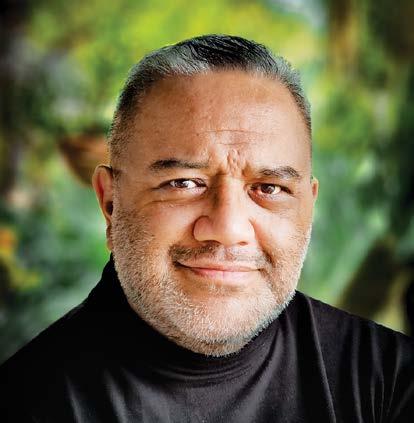

12 New Zealand Vineyard © WSCM 2020 Promotional picture
FOCUS
PHILIPPINE (CH)ORAL TRADITIONS

Group Singing in Cultural Practices of the Cordillera Regions
ARJAY VIRAY Choral conductor and researcher, the Philippines
IT HAS BEEN WELL DOCUMENTED THAT THE PHILIPPINES IS A SINGING COUNTRY. FROM INTERNATIONAL SINGING CONTESTS AND TALENT SEARCHES TO SINGER-SONGWRITERS FOR HOLLYWOOD FILM SCORES AND SOUNDTRACKS, FILIPINOS ARE LITERALLY EVERYWHERE.
On the other hand, of course, there is the plethora of choirs from the Philippines that have consistently excelled in numerous choral competitions abroad during the past decades. The Ateneo Chamber Singers, the University of Santo Tomas Singers, the University of the Philippines Singing Ambassadors, the De La Salle University Chorale, the Ateneo College Glee Club, the Philippine Normal University Chorale, Imusicapella, and the Philippine Madrigal Singers – to name but a few – are all internationally acclaimed Filipino choirs. I have been asked countless times by peers from different parts of the world whether there is a secret ingredient behind these exceptional singing groups, something I have never really thought about and responded to until recently. Certainly, formal music education has played a major role, but I truly believe that there is something bigger and deeper – something more innate and cultural.
Oral transmission in cultural and artistic expression is still common practice for many areas in the Philippines. It is loosely defined as the mode of preservation and promotion of culture not in the formal context of courses and
learning areas, but through informal and non-formal apprenticeship and experiential learning. This article examines some of these practices and traditions in one of the most revisited and referenced indigenous cultures among Filipinos – the Cordillerans.
HISTORY OF MUSICAL HERITAGE
The Cordilleras – formally listed as the Cordillera Administrative Region (CAR) – is one of the seventeen regions of the Philippines. Located in the northern part of Luzon, it comprises six provinces: Abra, Apayao, Benguet, Ifugao, Kalinga, and Mountain Province. The inhabitants speak several different languages, such as Tinguian/Itneg, Ifugao, Kalinga, Ibaloi and Kankana-ey; the majority also speak and understand Iloko/Ilocano – the language of the lowland areas of Northern Luzon (Ilocos, Region 1) as well as of Cagayan (Region 2) and a small part of Central Luzon (Region 3).
Various ethnomusicological research initiatives have been conducted in the Cordillera region over the past decades, and it has been well documented that Cordillerans have many musical traditions ingrained in different aspects of their lives, including agriculture, economics, socio-political matters, and belief systems. For example, oral narratives, including literary epics like the
13
Map of the Philippines and the Cordillera Administrative Region
Artikel auf Deutsch Article en français Artículo en español
Ifugao Hudhud and the Kalinga Ullalim, are believed to have been chanted during rice sowing, harvest, and, at times, at funeral wakes. Complete recitation of these takes several days – sometimes weeks – depending on the function for which the chant is used. Function also affects the varying configurations: chants recited during wakes are oftentimes unaccompanied and solemn, while recitations for harvest are more festive and likely to include the Gangsa (flat gongs) and bamboo percussion instruments. Another example is the Cañao, among the Kankanaey and Ibaloi groups of Benguet. It is a festival for the purpose of seeking approval, appeasing the spirits, or simply thanksgiving and involves a great deal of community singing, bamboo and gong playing, and dancing. But is there evidence to corroborate the idea that these traditions actually contribute to the development and propagation of choral singing?
to more complex, embellished ones. Their consistency in pitch – though perceived as informal, subjective, and, in essence, ephemeral – is actually based on soundscapes present in the environment that, in turn, become a sonic constant. With lots of instrument playing and dancing, Cordillerans have a very strong sense of rhythm. Sophisticated individual rhythmic patterns that interlock with one another – usually in sets of six and graduated in size – produce intricate melodies that are oftentimes used to accompany the singing and dancing. Examining vocal resonance through a scientific lens is worthy of an entire career in research, but what is important to note is that Cordillerans, being from the highlands, have the obvious benefits of altitude and atmospheric pressure on their side. Strong rhythmic skills, excellent ensemble musicianship, exceptional sense of melody and harmony, and vocal resonance – put these together and you have the perfect combination for an ideal prospective chorister. More importantly, these are all natural traits of Cordillerans prior to receiving any formal music education and training.
SETTING AND SETTLING THE TONE
UNWRITTEN TRADITIONS OF POLYPHONY, HETEROPHONY, AND POLYRHYTHM
These Cordilleran cultural traditions are passed on from generation to generation. The songs, the dances, and the rhythmic patterns of the instruments are taught quite differently from the way centuries-old art songs and sonatas have been handed down to the present time. Instead, they are acquired by younger generations directly from the community, by observing the elders. Since most of the traditions and practices involve community singing, music-making, and dancing, the art and practice of singing in a group is innate among Cordillerans, who have been exposed to themes and motifs ranging from simple stepwise and pentatonic melodies
It is no coincidence that the musical principles of tone, tune, and intonation, and the philosophical concepts of attunement, and even atonement, came from the same etymological origins. The Latin tonus is the obvious origin of several derivatives, such as the Spanish and Italian tono and French ton, which are all musical in nature. On the other hand, the older Greek tonos also included in its meanings “tightening” – which in essence is the act of decreasing the distance or lessening the separation between two objects – the tie, so to speak. Singing among the Cordillerans is not the be-all and
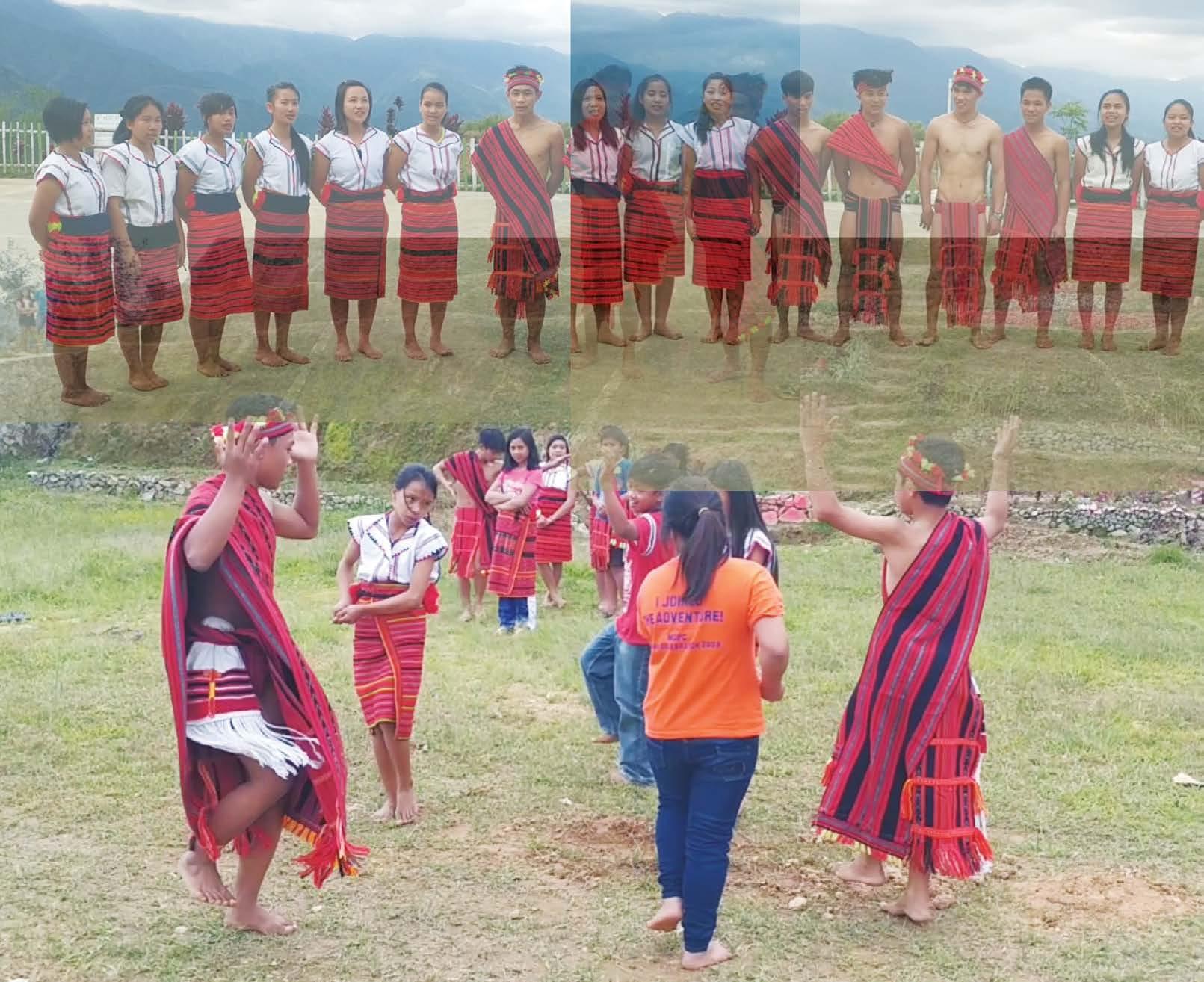
14
FOCUS
A photo-collage of high school students from Bangbang National High School in Hungduan, Ifugao singing and dancing
end-all; it is just one of the many components of a greater and grander scheme that characterises their heritage and identity. Following Gardner’s Multiple Intelligences, the musicianship and musicality exemplified by the Cordillerans are not just simple artistic and musical intelligences but are rather manifestations of the intersections among several Intelligence types, including VisualSpatial, Interpersonal, Intrapersonal, and even the more recently added Naturalistic Intelligence. One of the many things that the COVID-19 pandemic made us do is reflect and introspect. For the Cordillerans, singing in a group is not just an art form; it is their tight bond to their environment and their tie to the world. Given all the documented observations and the vast corpus of research already written about these cultural and musical practices among Cordillerans, we can finally put to rest the myth of the “secret ingredient”. There’s no secret ingredient in something natural and organic. Just look at some of the excellent choirs coming from this region, such as the University of Baguio Voices, the Saint Louis University Glee Club, the Cordillera Chamber Singers, and the University of the Cordilleras. They have become home to many amazing Cordilleran singers over the past few years – some of whom have made waves in international competitions as well.
It is good that some of these cultural practices have made their way into the classroom music curriculum among Philippine schools. Singing, just like other forms of artistic expression, is always better when rooted in one’s local culture. It would be good to use the same lens to examine the folk choral singing traditions of Philippine groups from other geographical settings (coastal areas, lowlands, etc.), but we will save that for another article.
 Edited by Richard Kutner, USA
Edited by Richard Kutner, USA
ARJAY VIRAY graduated with a master’s degree in Choral Conducting from the Philippine Women’s University School of Music and is currently pursuing his Doctorate in Curriculum and Teaching at the Miriam College Graduate School. He has sung with choirs such as the Philippine Madrigal Singers, the Philippine Normal University Chorale, and the Ateneo Glee Club, where he also served as Assistant Conductor for Choral Development. He sang with the World Youth Choir from 2008 to 2011 and the Time Ensemble from 2014 to 2019. He currently sings with the Ateneo Chamber Singers under the tutelage of Dr Jonathan Velasco. At the present time, Arjay is affiliated with the Philippine Choral Directors Association, the Philippine Center for Gifted Education, the Kodály Society of the Philippines, and the International Federation for Choral Music. He is a full-time faculty member in Music and Performing Arts at Guang Ming College. teacherarjayviray@gmail.com

15
Master musician from Kalinga – Dr. Benicio Sokkong sharing his expertise to an audience composed of students and teachers
LIVING ROOTS THROUGH CHORAL MUSIC IN BULGARIA
THEODORA PAVLOVITCH Conductor and Professor, Bulgaria
The Bulgarian State was established in AD681 and an event of great importance for the young state was the adoption of Christianity in 865. In the field of music, between Bulgaria and Byzantium in particular, there were bilateral relations that influenced in both directions, maintained by the Athos monasteries. Strongly related to the Empire’s tradition, Bulgarian religious singing in the 9-11th century was marked by all the characteristics of the Byzantian style. In turn, old Slav-Bulgarian folk music influenced the Byzantian chant repertoire. At the same time, two remarkable characters brought a change to European history. The brothers Cyrill and Methodius, monks and missionaries, invented the Slavonic alphabet and translated the main religious books from Greek into the spoken old Slavonic language that is even now in use for the liturgy in most Orthodox countries.
A remarkable personality appeared at the end of the 13th century –Yoan Koukouzeles (1280?-1360) –also known as Yoannis Koukouzelis or John Joukouzeles. Bulgarian on his mother side, he lived in a time of cultural cooperation
between the Balkan Orthodox states. His contribution to Orthodox music is considerable: he devised a new neumatic notation, introduced modulation as a system of music, composed a number of liturgical pieces, among them “Polyeleos of Bulgarian Woman”, dedicated to his mother. “Being a product of Bulgarian-Byzantine symbiosis, Yoan Koukouzeles was at the same time one of its most brilliant symbols. The musical heritage of Yoan Koukouzeles is part of the Byzantine civilization, but at the same time it is part of the Bulgarian contribution to the creation, development and dissemination of this phenomenon.” (Dr.Ph. Ivan Bozhilov).

Hundreds of Koukouzeles’ works have survived to this day and his music is still being performed in Bulgarian churches and by some choirs.
At the end of the 14th century the Turkish armies attacked Bulgarian territories and in 1396 the country was completely taken under Ottoman domination. The subsequent almost 500 years of history caused terrible damage to Bulgarian culture. The Bulgarians were forced to change their religion and to turn to Moslemism. Thousands of people were killed until the Ottoman rulers realized that Bulgarians preferred to die rather than lose their Christian faith. Already at the beginning of the Ottoman domination, many people departed from Bulgaria and, as a result, the Bulgarian Orthodox chants were spread to many different places. One of the most important consequences of that movement was the so-called Bolgarskii rozpev (Bulgarian chant) in Russia, Ukraine and Moldova. It presents an all-year-round liturgical repertoire, notated under this title in the South-Western Russian lithurgical anthologies of the 16th-17th century.
One of the most important factors that preserved Bulgarian spirit throughout the years of domination was music – rich folk traditions and the old orthodox chants were sang in monasteries and nunneries. Due to the specific historical conditions, the influence between the orthodox religion and folk songs was very intensive and a great number of anonymous orthodox chants with folk elements can be found in the liturgy even today.
In the 19th century a generation of well-educated people became leaders of the new movement fighting for church independence and national liberation. As a result, on 28 February 1870, the Bulgarian church was proclaimed independent, and the liturgy was once again recited in the old Slavonic and Bulgarian languages. It was not by chance that about that time the first polyphonic choirs were founded in various Bulgarian towns. The RussianTurkish war (1877-1878) freed the Bulgarian state. It also introduced a great development in the field of music.
After the liberation, many Bulgarian teachers founded and led choirs and some Bulgarian composers started their first attempts to write sacred music – Nikolai Nikolaev (1852-1938), Atanas Badev (1860- 1908), Emanuil Manolov
16 FOCUS
Artikel auf Deutsch Article en français Artículo en español
(1858-1902) among others. At the end of the 19th century, an amazing character appeared on the stage – Dobri Christov (1875-1941). Originally a teacher and conductor in Varna, he went to study in Prague with Antonín Dvořák and three years after returning, in 1906, he wrote the first of his church pieces in a totally new style that was incomparable with any earlier church composition. Later, Dobri Christov wrote 2 complete liturgies (the first of them dedicated to the sanctification of the “St. Alexander Nevski” Cathedral in Sofia in 1924), All Night Vigil and many additional chants. All of them belong to the most valuable Bulgarian musical heritage. Besides his creativity as composer, Dobri Christov founded
and conducted the best church choirs in Varna and Sofia. He was also one of the leading Bulgarian musicologists, director of the Music School in Sofia, Professor in Theory of Music at Sofia State Academy of Music and one of the founders of the Union of Bulgarian Choirs (1926).
In the first half of the 20th century, many composers followed Christov’s work and wrote orthodox music in the new national style strongly connected to the European traditions in melody and harmony – Apostol N. Strumski (18861971), Anastas Nikolov (1876-1924), Alexander Krastev (1879 – 1945), Christo Manolov (1900-1953) and many others. Among them was Petar Dinev (18891980) who carried out scientific research on the Bulgarian Chant, translated a lot of works by John Koukouzeles from neumatic to modern notation, composed a liturgy and several collections of church chants.
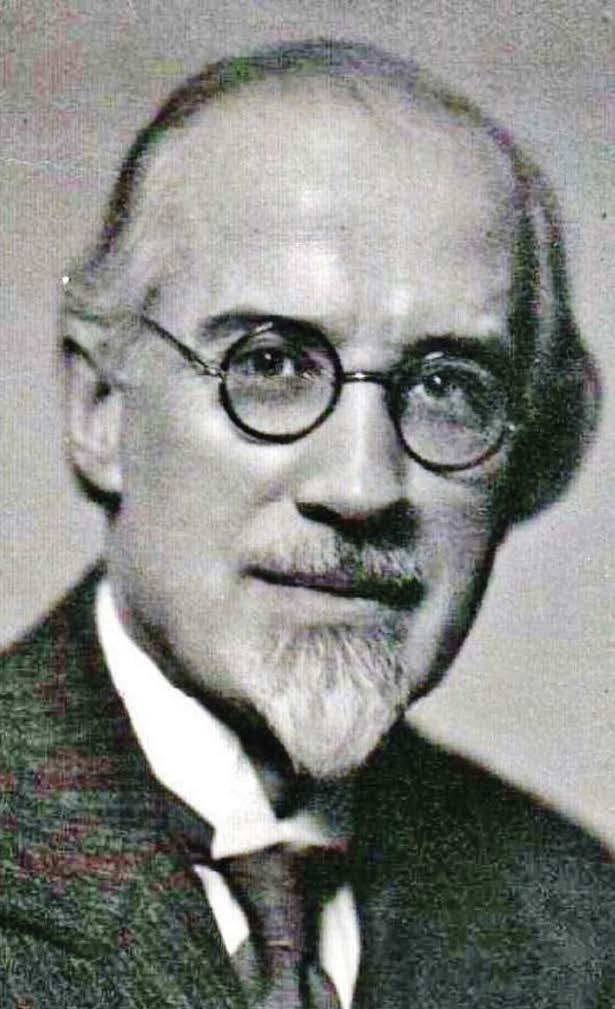
The communist regime stopped this development for almost 50 years. From 1944 until 1989, Orthodox music was banned in Bulgaria and only very few church choirs were allowed to perform in their own churches.


The political changes in the last decade of the 20th century brought a new movement and after 1989 many church choirs were founded and restored. Today, the liturgy and choral repertoire in Bulgaria is composed of pieces by Bulgarian and Slavonic authors. Out with the church, the Bulgarian professional and amateur choirs perform orthodox music quite often in parallel with music by European composers of various styles.
Prof. THEODORA PAVLOVITCH, PhD, is Head of the Department of Conducting and Composition at the National Academy of Music in Sofia. She is the conductor of the Vassil Arnaoudov Sofia Chamber Choir and Classic FM Radio Choir. She is has also been guestconductor, lecturer and member of the jury at a number of prestigious events in 28 European countries, USA, Japan, China, Hong Kong, Taiwan, Korea, Russia, Israel. In 2007/2008, she conducted the World Youth Choir, honoured by UNESCO with the title Artist for Peace. Since 2012, Prof. Pavlovitch is the Bulgarian representative in the World Choral Council and since 2021, she is an Honorary member of the Council. For her achievements in music and international choral life she has been awarded many special prizes by the Ministry of Culture of Bulgaria, the International Federation for Choral Music, the European Council of Scientific and Cultural societies and Classic FM Radio, among many other professional institutions. theodora.pavlovitch@gmail.com

17
Dobri Chistov (1875-1941) Sofia Cathedral, inside and outside
THE SÁMI MUSIC
ANNUKKA HIRVASVUOPIO-LAITI
THE SÁMI (SÁPMELAŠ, PL. SÁPMELAČČAT ) ARE AN INDIGENOUS PEOPLE WITH THEIR OWN HISTORY, LANGUAGE, CULTURE, WAY OF LIFE AND IDENTITY. THE WORD “SÁMI” COMES FROM THE SÁMI WORD SÁPMI , WHICH MEANS BOTH THE GEOGRAPHICAL AREA TRADITIONALLY INHABITED BY THE SÁMI AND THE ACTUAL SÁMI ETHNIC GROUP. THE SÁMI ARE ONE NATION THAT HAS BEEN RECOGNIZED AS AN INDIGENOUS PEOPLE AND LIVES IN SCANDINAVIA IN FINLAND, NORWAY, RUSSIA AND SWEDEN. THE AREA INHABITED BY THE SÁMI EXTENDS FROM CENTRAL NORWAY AND SWEDEN OVER THE NORTHERN PART OF FINLAND TO THE KOLA PENINSULA. THERE ARE A TOTAL OF BETWEEN 60,000 AND 100,000 SÁMI LIVING TODAY, DEPENDING ON WHICH INCLUSION CRITERIA ARE EMPLOYED.
Sápmi is often divided on maps according to language areas. There are several Sámi languages and three of them (Inari Sámi, Skolt Sámi and North Sámi) are spoken in Finland. Skolt Sámi is also spoken in Russia as well as Kildin Sámi and Ter Sámi. North Sámi can be considered the dominant language with the most speakers. In addition to Finland, North Sámi is also spoken in Sweden and Norway. The Sámi languages spoken in Norway and Sweden are also Jule Sámi, Bite Sámi, Ume Sámi and South Sámi.
In addition to the common language, the Sámi of different countries are united by, for example, traditional livelihoods (such as reindeer herding, fishing, hunting) the same/similar traditions of costumes and handicrafts, and the tradition of music. Traditional music genres often follow language groups, although in addition to the different dialects of the languages, local features are also strongly present in the musical traditions. In Finland there are livđe chanting tradition of the Inari Sámi and leu’dd chanting tradition of the Skolt Sámi. Leu´dd and luv´tt are also present in Russia. In Norway and in Sweden, there are vuolle and vuelie traditions among the Lule, Ume and South Sámis.

The traditional vocal music style of the North Sámi is yoik. Luohti is a Sámi word describing one particular yoik. The verb juoigat means to yoik someone or something, not yoik about someone or something. It can’t be equated with a pair of concepts “sing a song” or “yoik a luohti”. In the Sámi language, yoiking is distinguished from singing, which uses the verb lávlut, and they are two entirely different things. Characteristic features of the North Sámi yoik are the distinctive chanting style and rhythms, improvisation, unaccompanied, juoiganstávvalat use of ‘yoik syllables’ (hey-yo, lo-

18 DOSSIER
Musician, ethnomusicologist, reindeer herder, assistant professor in Sámi language, Finland
Annukka and Gabba © Annukka Hirvasvuopio Yoik lives among the reindeer herders © Annukka Hirvasvuopio
Artikel auf Deutsch Article en français Artículo en español
laa, naa-naa) and the close relationship of this musical tradition with the rest of the culture.
One can yoik a person (personal yoik), an animal, even some natural site. A Sámi yoiker and teacher Ánte Mihkkal Gaup states that a personal yoik is like a name for a Sámi. It is called by the concept of luohtenamma. The personal yoik is so personal and descriptive of its object that, according to Gaup, it can be seen as an equally integral part of the Sámi’s personal identity as the first and last name. Luohtenamma is an important part of Sámi identity. I would say that a personal yoik is like a “musical photograph” of a person.
North Sámi music tradition is strongly related to reindeer husbandry culture. In addition to work related to reindeer husbandry, the reindeer herders have often yoiked. Yoiking was a pastime when moving from place to place and, among other things, during long winters, when the reindeer herder on duty stayed awake guarding his flock. In addition to the burning campfire, the human voice has also been said to have served to frighten predators away.
One may wonder if the preservation of the entire Northern Sámi music tradition or even the preservation of Sámi culture and language to this day on a whole is a sort of miracle, as there has been so much pressure to quash it over the years. The practice of witchcraft was banned in SwedenFinland in the 17th century, as well as the use of the witch drum which was used by Sámi shamans during rituals. Those who broke these laws faced execution. As late as 1734, the Swedish-Finnish Penal Code stipulated the death penalty for witchcraft. In addition to practicing witchcraft, yoiking was also prohibited during rituals. During the spiritual rituals the Sámi shaman used drumming as a means of falling into a trance and the drum was also used in a divination. The priests did not understand the function of the yoik in Sámi society but only saw the connection to the shamanism. This led the entire Sámi music culture to being condemned as a sin. Although the death penalty as punishment for yoiking was eventually abandoned, it was replaced in the 19th century by the religious movement of Lars Levi Laestadius and the very negative attitude towards the yoik in Finland, Norway and Sweden.
A Sámi researcher Veli-Pekka Lehtola describes the era from the 1960s onwards as a “Sámi Renaissance”. According to him, the movement at the turn of the 1970s was characterized by a breakthrough in Sámi culture on a very broad front: in politics, the media, culture, education, and society activities. Also, as professor Vuokko Hirvonen states, the yoik has experienced a renaissance in the last decades: more and more traditional
yoiks have been published, new yoiks have been made and a new kind of yoik tradition has emerged. Nils-Aslak Valkeapää, or Áillohaš, (1948–2000) as he was known by his people, was a Sámi multi-artist born in a reindeer herding family in the Finnish side of Sápmi. His debut album Joikuja (OTLP-50) in 1968 made history because traditional yoiks had never before been recorded with musical accompaniment. The Joikuja album started a whole new era in Sámi music and was the basis for Sámi popular music. Today, Sámi modern music is very versatile and Sámi music can be found in almost every genre of music. You can find Sámi rap, dance music, children’s music, spiritual music... The appreciation of traditional yoik is still high among the Sámi people, and for example various educational projects have been developed to preserve it. This is evidenced, for example, by the fact that the annual Sámi music festival in Kautokeino, Norway, includes a music competition, which has its own series for traditional unaccompanied music and modern music. Traditions are valued, space is given to modernity.
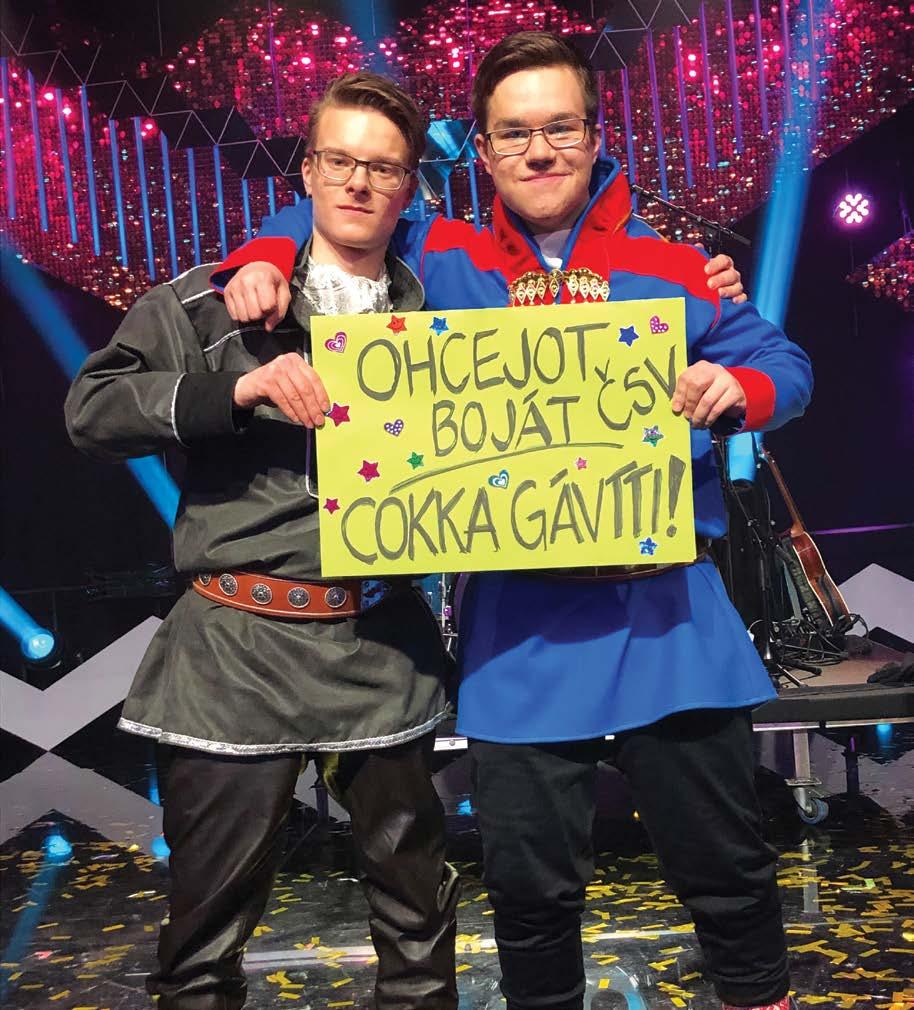
ANNUKKA HIRVASVUOPIO-LAITI, Hirvas-Niillasa
Heaikka Annukka, born 1973, living in Ohcejohka, Finland. Musician, ethnomusicologist, reindeer herder, mother of three, assistant professor in Sámi language and literature at Sámi University of Applied Sciences, Guovdageaidnu, Norway.
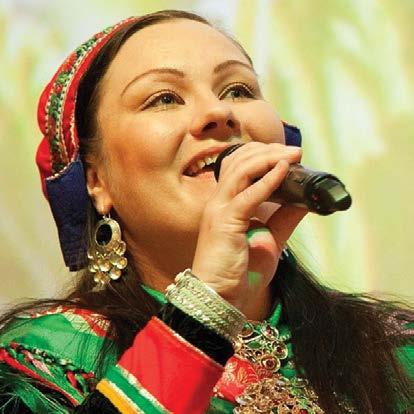
19
Mihkku Laiti and Jesse Ruokolainen at the Sami Grand Prix song contest April 2023 © Annukka Hirvasvuopio
HAS “WHITENESS” LIMITED THE IMAGINATION OF WESTERN CHORAL MUSIC?
THOMAS LLOYD Conductor, composer and singer, Philadelphia, USA
IN RECENT YEARS, SEVERAL FACTORS HAVE CALLED INTO QUESTION THE ASSUMED POSITION OF “CLASSICAL” MUSIC IN THE EUROPEAN TRADITION AS THE INTERNATIONAL STANDARD OF EXCELLENCE. IN THE UNITED STATES, THE RESURGENCE OF THE BLACK LIVES MATTER MOVEMENT FOLLOWING THE MURDER OF GEORGE FLOYD IN 2020 AND DISPARITIES IN THE AVAILABILITY OF HEALTH CARE IN COMMUNITIES OF COLOR REVEALED BY THE COVID-19 PANDEMIC LED TO A LONGOVERDUE NATIONAL RECKONING ABOUT SYSTEMIC RACISM. ALL FACETS OF AMERICAN SOCIETY, INCLUDING OUR CHORAL COMMUNITY, WERE CHALLENGED TO TAKE A SERIOUS, FRESH LOOK AT THE WAY RACIAL AND GENDER BIAS HAVE DISTORTED OUR LIVES AND CREATED INJUSTICES THAT COULD NO LONGER BE SWEPT ASIDE.
However, looking back three years later, what appeared at first to be a rare moment of national unity has unfortunately devolved into intensified rancor and division, reminding us of why racial injustice has been seen as our nation’s “original sin” for so long. Yet some of us have also feared that a way of life and long-accepted standards of excellence (e.g. “classical” music) are under threat or, at the least, are changing “too fast.” Is the “classical” tradition on its way out, considered irrelevant at best or oppressive at worst? Orchestras and choirs on all levels are facing diminished post-pandemic audiences that pose a challenge to long-term survival.
What we have called “classical” music doesn’t have an isolated, lofty, universal origin, but comes from a distinct tradition rooted in a particular place and time: the European city of Vienna, during a pivotal forty-year period at the turn of the nineteenth century. That period was dominated by three transcendent composers – Haydn, Mozart and Beethoven – who defined the classical style. The diatonic harmonic and melodic structure that crystallized during this short span became the durable foundation not only of the music of court, church and later, the concert hall, but of most Western popular music even to this day.
In the nineteenth century, the dominance of the Viennese classical style soon inspired composers in non-Germanic European countries to seek ways to establish independent stylistic identities for their own national traditions. This reaction even reached American shores through the Czech composer Antonin Dvořák, who came to New York in 1892 to teach at the American Conservatory in New York City. His recommendation that American composers look to the music of Indigenous people and AfricanAmericans for inspiration largely fell upon deaf ears, except for a slowly growing number of African-American composers who began composing choral and symphonic music drawing in part on the Spirituals.
In retrospect, the world may have proved Dvořák right in unexpected ways through the overwhelming international success and influence of music from Black and Jewish American traditions, though outside the more elite concert halls of “classical” music. With the dawn of sound recording in the early twentieth century, the world developed an immediate enthusiasm for one new American popular style after another.
Choral music probably benefited more than most other musical genres from the arrival of digital recording and the compact disc in the 1980s. These recordings made possible a clarity of sound that not only surpassed previous analog methods of recording choirs, but created an aural “magnifying glass” that revealed far more than the naked ear could hear in a typical concert setting.
The choirs that sounded best on CD were those with the most homogeneity of vocal timbre. Professional choirs generated an
20 DOSSIER
Artikel auf Deutsch Article en français Artículo en español
abundance of excellent recordings of music both old and new, though the pristine “wall of sound” style may have had more to do with the available technology (and the reductionist “modernism” of that age) than with scholarly attention to how older music may have sounded in its own time. A combination of tonal refinement and expressive uniformity became the unquestioned standard by which all choral performance should be judged. How could one argue with perfection?
Two experiences stand out in my mind related to these issues. In 1999, I attended the IFCM international conference in Rotterdam, The Netherlands. Immersed in an incredible variety of choral sound and style, I couldn’t escape one striking impression: Every choir I heard from western Europe and the United States was dressed in black and stood absolutely still while singing, while every choir I heard from everywhere else in the world dressed in brilliant colors distinctive to their cultural identity and moved in equally distinctive ways while singing. In retrospect, I wonder if this was an
unintentional manifestation of the social construct of “Whiteness” in choral performance.


The other experience was more recent. I attended a performance last year of Sun & Sea, a meticulously prepared “opera-performance” work presented at the Philly Fringe Festival by a Lithuanian troupe of singers and actors at an abandoned factory warehouse on the edge of the city1. The setting was a beach created by bringing in tons of sand to the floor of an abandoned warehouse, with elaborate scaffolding constructed above the “beach” from which the audience would listen while staring down at the performers. The music consisted of a recorded, minimalist soundscape played while thirteen singers, solo and together, sang impassively while lying on their backs, surrounded by three times as many non-singing beachgoers. Listeners in the audience had fun looking around to see where the sound of the next singer was coming from – it often took a while to figure out, as the singers barely moved their mouths while lying motionless on their backs.
This reminded me of a number of new choral works created during the pandemic for singers to perform outdoors safely, with social distancing from each other and their audiences. Whether in the woods or on elevated urban pathways like New York’s “High Line,” singers were asked to stand impassively, sometimes cued through an elaborate audio network, to sing words representing the boredom and isolation of the pandemic.
I couldn’t help wondering again, is this what “classical” choral music has come to? What will we do next after draining all the blood out of our singing? Is the resulting banality of such performances that much better than the stain of musical sentimentality that we have so studiously (and understandably) avoided? Can we find our way forward again in music that reflects or at least connects to the style and substance of the quite particular cultures of the times and places we are given to live in?
1 See https://en.wikipedia.org/wiki/Sun_%26_Sea_(Marina)
21
Bucks County Choral Society
Mzanzi Youth Choir
Perhaps if we abandon our need to be seen as representing an abstract, lofty “world” standard of artistic value to be held over all musical genres and styles rather than just our own, we might find authentic artistic identities again. Can we find ways to express our individual and communal passions and contradictions, without sentimentality, but also with life, color, and individuality?
I hope so. Our colleagues -- no longer looking from the outside at what had become an exclusive club of white, male performance style -- are showing the way for us.
Edited by Anita Shaperd, USA

THOMAS LLOYD is a conductor, composer, and singer who has served as Canon for Music and the Arts at the Philadelphia Episcopal Cathedral since 2010 and Artistic Director of the Bucks County (PA) Choral Society since 2000. He is also an Emeritus Professor of Music at Haverford College. The premiere recording of his 70-minute choral-theater work Bonhoeffer by The Crossing was nominated for a 2017 GRAMMY award in the Best Choral Performance category. Major foci of his scholarly research have been developing cross-cultural collaborations, the AfricanAmerican Spiritual, sacred choral jazz in the tradition of Ellington, and music of Edward Elgar and Hans Gàl. Lloyd’s writing appeared previously in the ICB (Volume XXXVI, Number 2, pp. 30-34) related to a collaboration in 2017 with the Begegnungschor Berlin: "Singen, nicht hassen – Let's sing, not hate.” For complete lists of his articles and compositions, see www.thomaslloydmusic.com
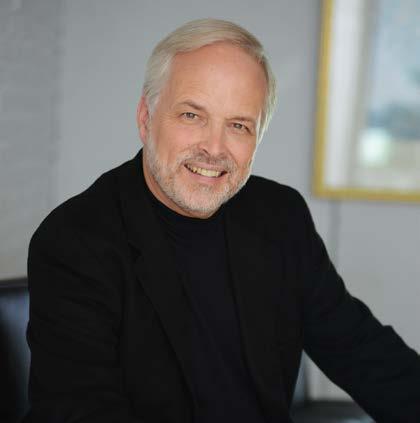
22
Sun & Sea Opera at the Philly Fringe Festival 2019 photo Andrej Vasilenko
DOSSIER
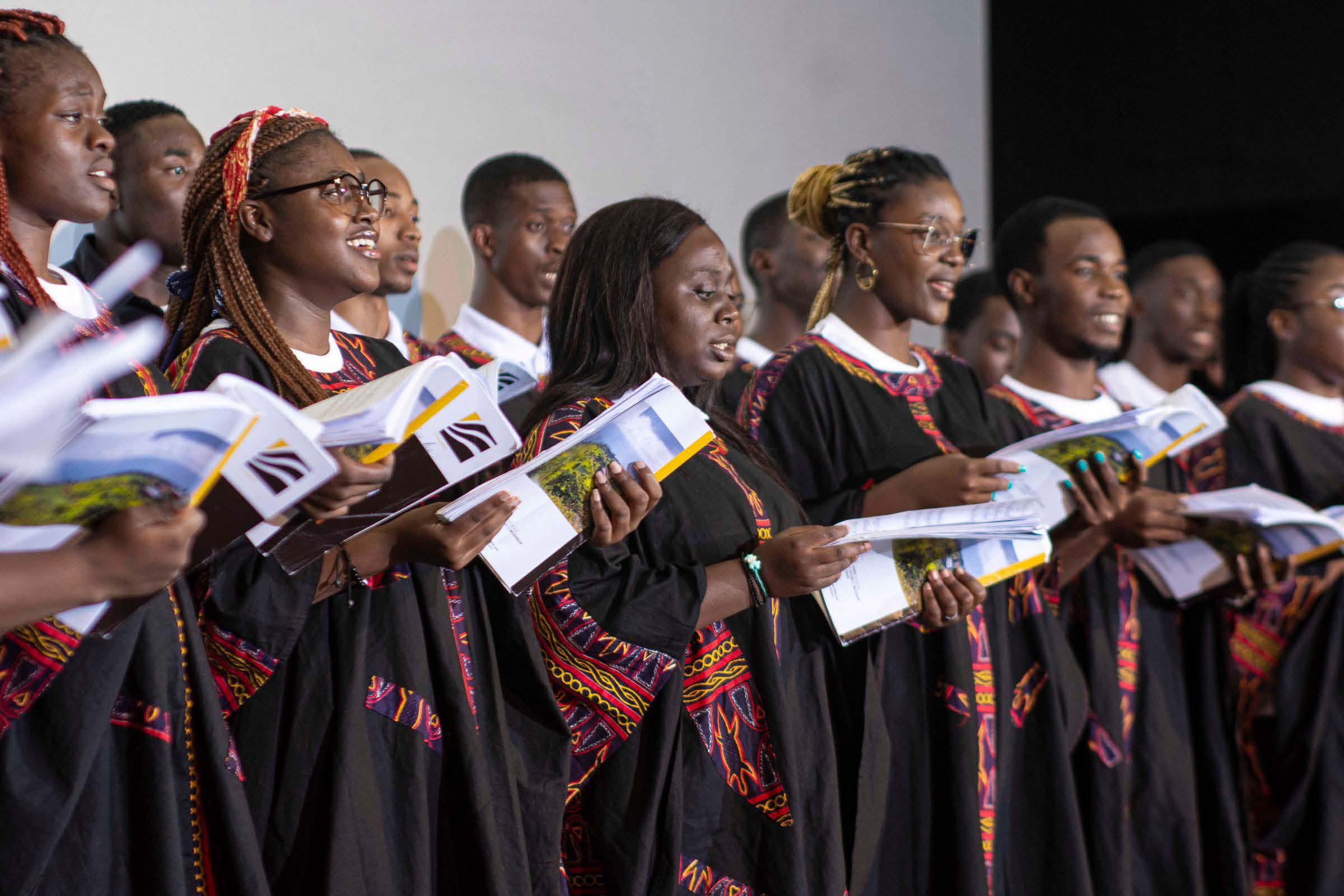


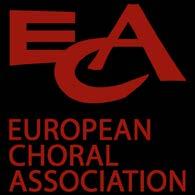
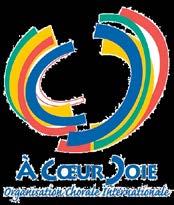


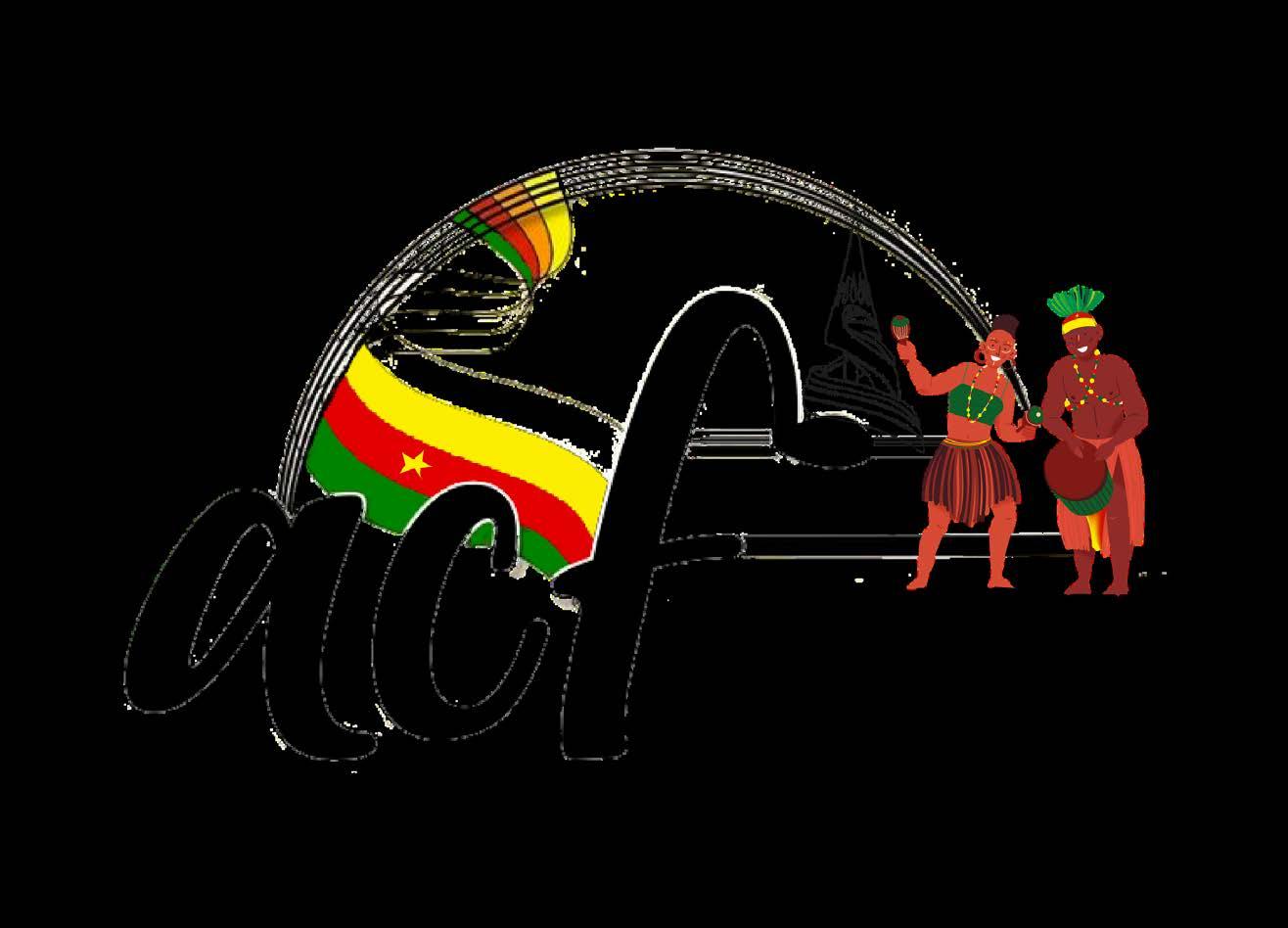
23 AUGUST 1 > 6 2023 Yaounde | CAMEROON Sing with choirs in the heart of Africa ! International choral festival Further informations https://africacantat.org This project is implemented by In partnership with
INTERNATIONAL FEDERATION FOR CHORAL MUSIC
MESSAGE FROM THE PRESIDENT
Emily
IFCM WELCOMES A NEW BOARD AND A NEW EDITORIAL BOARD Press Release
CHANGING HORIZONS OF THE CHORAL WORLD AT THE CROSSROADS OF WEST AND EAST

Tisa Mrhar
REFLECTION ON MY YOUNG PROGRAM EXPERIENCE
Brydon Sundgren
WORLD CHORAL DAY: SCORES OF THE IFCM COMPOSITION COMPETITION 2022
TRIBUTE TO H. ROYCE SALTZMAN
24
IFCM NEWS
Kuo Vong
Le Chant sur la Lowé, dir. Pierre-Roger Diel Mouity (Gabon) at the WSCM 2023, Istanbul, Türkiye © Gülcan Acar
MESSAGE FROM THE PRESIDENT
EMILY KUO VONG IFCM President

Dear all,
When I was writing these words to you, I had just come back home from the World Symposium on Choral Music (WSCM) 2023. As you already know, we brought this, one of the most significant events of IFCM, to Istanbul, Türkiye, from 25 to 30 April this year.

It was not the first time I had visited this picturesque city on the bridge between Asia and Europe. However, a rush of excitement coursed through me when I got together with many old friends during the WSCM and met many new friends there. The WSCM 2023 was the first big event of IFCM after the three-year pandemic. I believe everyone’s heart swelled with joy at the sight of the passion and enthusiasm visible at the WSCM in Istanbul. Meanwhile, the global choral community was filled with hope for the future by the success of this international event as it is universally acknowledged that choral events are indispensable for the development of choral music.
As the president of IFCM, I was filled with pride before such a marvelous WSCM. Firstly I would like to express my gratitude to the Ministry of Culture and Tourism of Türkiye, whose great support made this WSCM come to life. Then I would like to thank all the outstanding

choirs as well as the brilliant conductors, composers, and musicians from different countries for participating in the WSCM. Moreover, I appreciate the contribution made by the Administrative Committee, the Artistic Committee, the Local Committee, and volunteers to the WSCM 2023. They were brave to take on the challenge and accomplished the objective in only 9 months; it generally takes 3 years to prepare for a symposium.
Moreover, we successfully held the IFCM General Assembly during the WSCM 2023 and selected the new Board of our federation. I am glad that we have experienced board members and fresh experts at the same time. In the coming three years, I am confident in this new team and a feeling of responsibility weighs heavily on our shoulders. We are extremely grateful to the outgoing IFCM Board and will strive to accelerate IFCM’s growth to make it stronger and more integrated with more members joining our big family. We sincerely thank you all for your combined dedication in reaching this goal!
Best wishes,
25
Third from the right, IFCM President Emily Kuo Vong with, on her right, Turkish Deputy Minister of Culture, Mrs. Özgül Özkan Yavuz.
On the far left, IFCM Vice-President, Burak Onur Erdem, director of the WSCM 2023
IFCM WELCOMES A NEW BOARD
IFCM PRESS RELEASE
The International Federation for Choral Music (IFCM) held its General Assembly on 25 April 2023. Prior to the General Assembly, the Election of the new Board of Directors was fully organized online (1 March – 1 April 2023). We can proudly say that this event has a historical significance in our association since this was the first time ALL INDIVIDUALS had the opportunity to vote individually thanks to a change of in the Bylaws voted at the General Assembly in Lisbon in September 2022. Other changes include more votes for the following categories: choirs (2 votes), Local organizations (3 votes), national and regional organizations (10 votes), and international organizations (20 votes).
The Election of the new Board of Directors was organized through an online voting system. An Election Committee was appointed to overlook and ensure fair and democratic results. The results were announced during the General Assembly and, on April 28, the new Board named their VicePresidents, Treasurer, and Governance Advisor.
THE BOARD OF DIRECTORS 2023-2026
• Emily Kuo Vong, President
• Jan Schumacher (Germany), Vice-President
• Burak Onur Erdem (Türkiye), Vice-President
• Roula Abou Baker (Lebanon), Vice-President
• María Guinand (Venezuela), Vice-President
• Yoshihiro Egawa (Japan), Vice-President
• Dominique Lecheval (France), Treasurer
• Ki Adams (Canada), Board Member
• Ana Patricia Carbajal (Mexico), Board Member
• Yveline Damas (Gabon), Board Member
• Niels Graesholm (Denmark), Board Member
• Darius Lim (Singapore), Board Member
• Gábor Móczár (Hungary), Board Member
• John Rosser (New Zealand), Board Member
• Kaie Tanner (Estonia), Board Member
• Anthony Trecek-King (USA), Board Member
• Cameron LaBarr (USA), co-opted Board Member
INTERNAL AUDITORS
• Montserrat Cadevall (Catalonia, Spain)
• Ingrid Meka (Burundi)
GOVERNANCE ADVISOR
• Sonja Greiner (Germany)
Congratulations to the new Board members and thank you to all the candidates who applied.
A big thank you also to the members who left the Board after their mandates: Saeko Hasegawa, Jinsheng Li (China) Victoria Liedbergius, Tim Sharp, JoMichael Scheibe and Thierry Thiébaut.
THE IFCM BOARD ELECTED A NEW EDITORIAL BOARD FOR THE INTERNATIONAL CHORAL MAGAZINE (IMC)
The call for the Editorial Board of the International Choral Magazine was launched in the beginning of April. IFCM received 24 applications from 19 countries around the world. The IFCM Board selected eight of the applicants according to the specifications in the call and the regions they represented.
Congratulations and welcome to:
• Debra Ann Shearer-Dirié (Brisbane, Australia)
• Godfred Edusei Derkyi (Tema, Ghana)
• Brett Scott (Cincinnati, OH, USA)
• Sinem Taşseven Erentürk (London, UK / Bodrum, Türkiye)
• Tomoko Yokoyama (Tateshina, Japan)
• Ana María Raga (Caracas, Venezuela)
• Arjay Viray (Cavite, Philippines)
• Aksel Dalmo Tollåli (Oslo, Norway)
Together with ICM Managing Editor, Isabelle Métrope, IFCM Board members Ana Patricia Carbajal and Yveline Damas, and Honorary Member and Editor Emerita Jutta Tagger, they will work on the International Choral Magazine's content for the next three years.
26
IFCM NEWS
Artikel auf Deutsch Article en français Artículo en español
CHANGING HORIZONS OF THE CHORAL WORLD AT THE CROSSROADS OF WEST AND EAST
TISA MRHAR
THE WORLD SYMPOSIUM ON CHORAL MUSIC TOOK PLACE IN ISTANBUL FROM 25 TO 30 APRIL AND WAS ATTENDED BY MORE THAN 2500 SINGERS FROM ALL OVER THE WORLD.

The World Symposium on Choral Music is a project of the International Federation of Choral Music. It has been held every three years since 1987, when it was first launched in Vienna. In 2020, choral music lovers were due to meet again in Auckland, New Zealand, but the Symposium was cancelled due to the pandemic. In 2023, the Symposium was then planned to be held in Qatar, only to be moved to Istanbul with the support of the Turkish Ministry of Culture and Tourism less than a year before the event was due to take place. This year’s gathering of experts from all over the world was thus held in a city of more than 15 million people, a multicultural crossroads of East and West. In this respect, the central theme of the Symposium “Changing Horizons” was an invitation to explore all the world’s musical cultures, to look for new developments and directions in choral music and, above all, to question all the existing (re)creative practices.
A LIVELY FESTIVAL FROM MORNING TO EVENING
The festival’s rich programme consisted mainly of morning keynote presentations, lectures, workshops, meet-the-composer sessions, reading sessions, panels, roundtables, lounges, and the Expo during the first half of the day, while the afternoons and evenings were dedicated to concerts. The morning educational sessions offered a concise insight into a wide range of new developments in the field of choral music, but above all they provided an opportunity to learn about foreign musical
27
WSCM 2023 Gala Concert © Gülcan Acar
Artikel auf Deutsch Article en français Artículo en español
cultures and their choral literature, and this is where the greatest charm of this year’s international gathering lay. The participants were particularly attracted by the diverse presentations of choral works from the Middle East and other lesserknown cultures, characterised by non-tempered systems and varied musical-theoretical frameworks.
first professional choirs were then established in the 1970s and 1980s, and at the turn of the 21st century, there was a full-scale expansion of choral singing, particularly in the context of amateur cultural societies established in all the major cities of Türkiye. This year’s Symposium thus brought together more than 30 Turkish choirs of different genres.
In total, more than 55 choirs performed at the festival, during the afternoon concerts, while eleven selected ensembles also performed at the evening gala concerts in the newly renovated Atatürk Cultural Centre. The organisers made sure that the participating choirs represented all continents as equally as possible, making this year’s line-up was truly vibrant.

TWO MASTERCLASSES LED BY RENOWNED MENTORS


In parallel to the regular programme, two masterclasses were organised – a conducting masterclass with Ragnar Rasmussen and Lorenzo Donati, and a composition masterclass with Ko Matsushita. The first was also attended by Slovenian conductor Klara Maljuga, winner of last year’s 2nd National Competition for Slovenian Choir Conductors: “Spending several days under the watchful eye of excellent mentors and with sensitive choirs that respond to your every shortcoming is really the ideal scenario for conducting training. The seminar itself was so intense, my head was full of impressions. The days were really long and the nights too short. My free time I mostly used to
MORE THAN 55 CHOIRS FROM ALL OVER THE WORLD
In Türkiye, host of the World Symposium on Choral Music, choral singing was only established during the early years of the Republic, founded in 1923 by Mustafa Kemal Atatürk. The first organised forms of choral singing thus emerged in the 1920s and 1930s, with music schools and conservatoires certainly playing a major role in the development of choral singing. The
28 DOSSIER IFCM NEWS
Rengim Gökmen, Türkiye
Merzi Rajala & Kirsi Kaunismäki Suhonen, Finland
Borusan Çocuk Korosu © Gülcan Acar
get to know composers and their philosophies – especially since we, the conductors sometimes struggle with their contemporary pieces. I should not forget to mention the new friendships made, the exchange of scores, interpretation practices, didactic approaches, as well as life principles and the opportunity to refresh relationships with distant acquaintances.”
In addition, the fruitful discussions and newly forged friendships between composers and conductors were also highlighted by Zuzanna Koziej, Polish composer and arranger, living in Italy, who took part in the composition masterclass: “The Masterclass was a great opportunity to hear our own and our colleagues‘ pieces
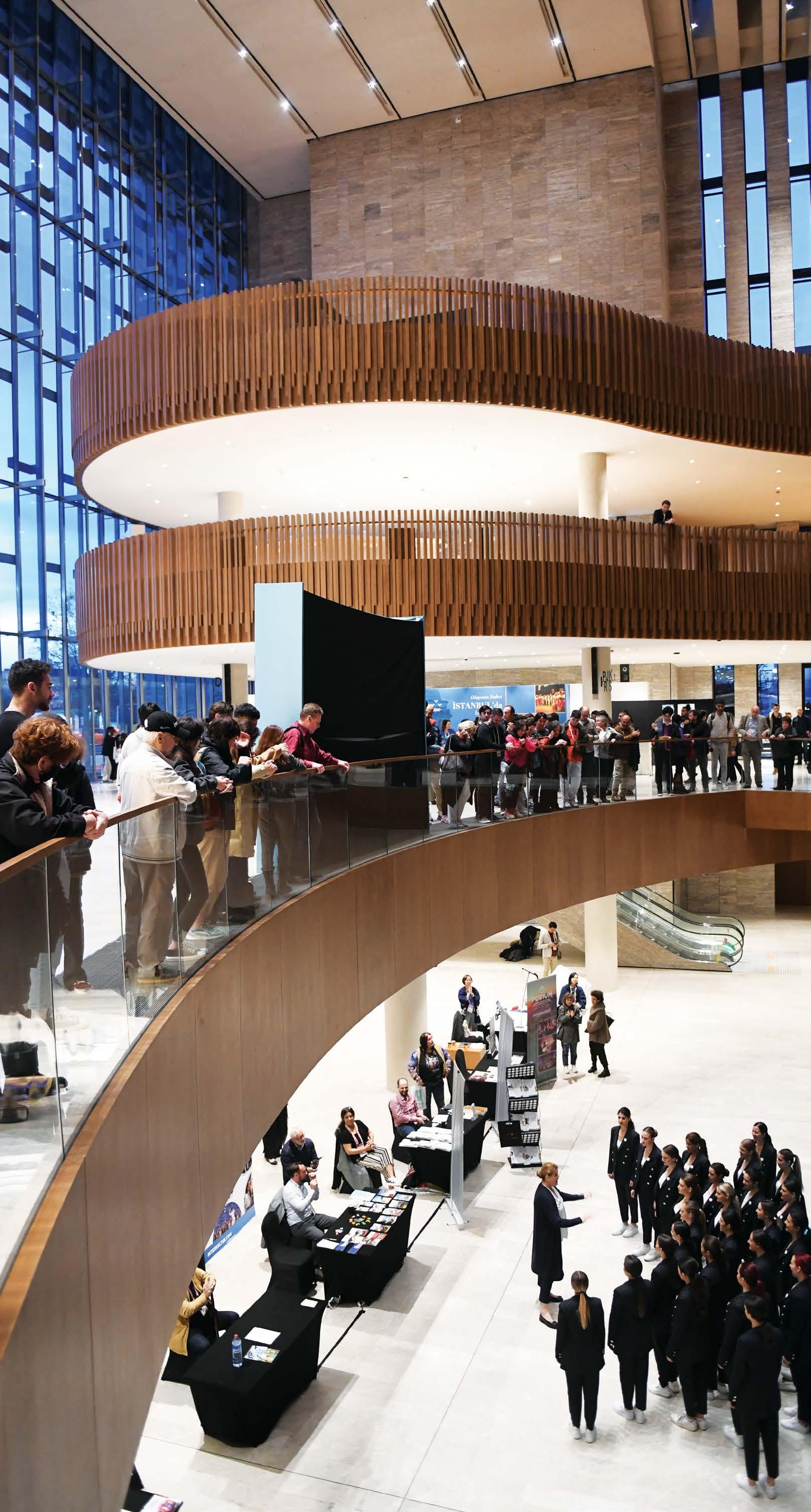

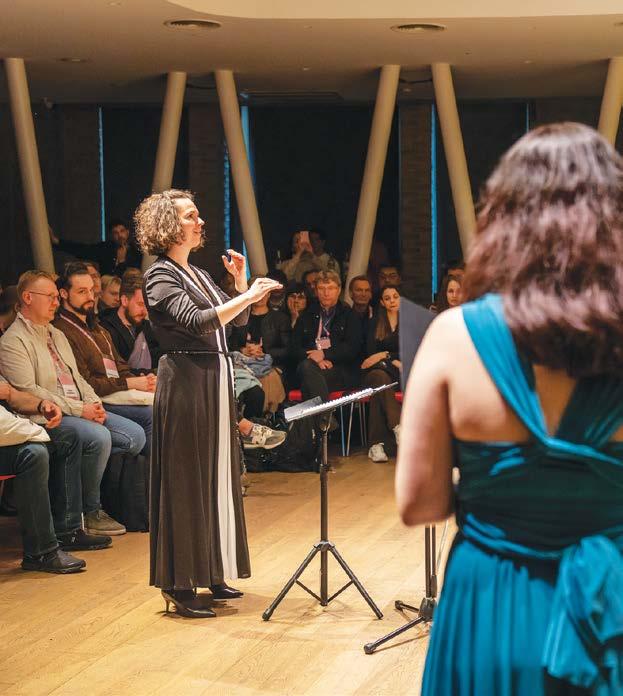
29
Klara Maljuga, one of the conducting masterclass participants © Gülcan Acar
Zuzanna Koziej, one of the composition masterclass participants
was a great experience, offering possibilities for future projects and collaborations. The part I enjoyed the most was the discussion with conductors participating in the Conducting Masterclass. We talked about the composer-conductor relationship and realized how little we know, but also how much we can learn from each other.”
TRAINING YOUNG MANAGERS
A new addition to the international festivals under the auspices of the International Federation for Choral Music is YOUNG, the Young International Cultural Management Programme. Organised for the second time in a row, this year it once again welcomed ten young individuals from all over the world. Upon arrival, they first attended an introductory two-day training course, where they learned about
the organisation of the festival and each other, while acquiring additional management skills. They then joined the festival’s organising team, within which they were each assigned a specific task. This year, Jaime João, a student of choral conducting from Portugal, took part in the programme: “Being part of the YOUNG team in Istanbul was an unforgettable experience. Such a luck to be able to work with this many seasoned event organizers and musicians for more than two weeks, in a seemingly short window of time that more than allowed me to learn so many things about this world, making me feel like I can’t stop now, as if all the energy in the world was made available to me in order to find a way to bring home every part of this experience and everything I have learnt – and hopefully will keep on learning”.

UNTIL NEXT TIME?
“I hugged many friends I had not seen in a while, met new inspiring people, learned a lot in keynotes and sessions and enjoyed wonderful concerts where I could not only hear the best choirs from different regions of the world but also very good Turkish choirs which were partly new discoveries for me. I look forward to hearing more of them, meeting them and Turkish conductors in international events across the globe and coming back to Türkiye where I now have many more friends who made our stay a great experience!” This is how Sonja Greiner, Secretary General of the European Choral Association, summed up her impressions of the symposium. Many more satisfied visitors came back home from Istanbul and the event will certainly have a positive impact on the
30
IFCM NEWS
Turkish choirs getting ready for the stage © Gülcan Acar
development of the Turkish choral landscape and its surroundings, as Burak Onur Erdem, Festival Director, also pointed out: “From this moment on, Türkiye is one of the prominent centres of choral music. This festival has changed our horizons. Now we see the world with new eyes, we listen to it with new ears.”

Unfortunately, the future of similar meetings is rather uncertain, as hardly any country is financially ready to commit to organising such large cultural projects in the current uncertain situation. Besides that, these also require the work of a well-coordinated organising team over several years and many other inputs, but their positive short- and long-term effects make them indispensable in the current globalised choral world. Various platforms, festivals, symposia, and expos foster the development of the entire choral landscape, both locally and globally, and above all they enable all those who create it to maintain old and make new contacts, besides encouraging an open exchange of opinions and views, thus creating the harmony of our beautiful (musical) world.
TISA MRHAR is currently completing her Master’s degree in law and musicology at the University of Ljubljana. She is actively involved in the national and international choral scene. Since 2016 she has been singing in the Academic Choir Tone Tomšič, which she also led for two seasons as its president.
In July 2021, she participated in the Young Event Management Programme (YEMP) at the Europa Cantat Festival in Ljubljana, and in 2022 she took part in YOUNG, Youth International Cultural Management Programme, at the World Choral Expo in Lisbon. As part of her studies she is currently doing an internship at the Public Fund of the Republic of Slovenia for Cultural Activities under the mentorship of Mihela Jagodic, while also writing about (choral) music for the magazines of the Jeunesses Musicales Slovenia and Public fund for cultural activities, as well as creating broadcasts for Slovenian national radio programmes.
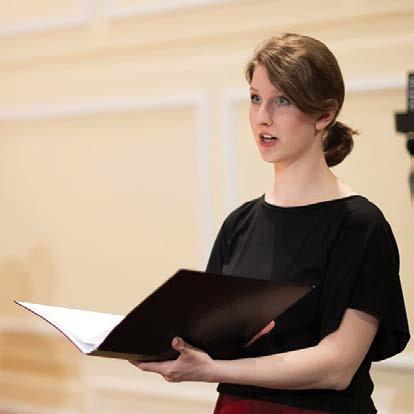
31
Among the Turkish choristers who performed at the Closing concert, Pelin Küçükerdoğan, WSCM Music Officer and Aslıhan Sapas Aşçı, WSCM Coordinator. Center: Burak Onur Erdem, Festival Director © Gülcan Acar
REFLECTION ON MY YOUNG PROGRAM EXPERIENCE
BRYDON SUNDGREN Civil Engineer and Project Manager, New Zealand
Artikel auf Deutsch Article en français Artículo en español
IT ALL STARTED IN THE LEADUP TO CHRISTMAS 2022. A CHANCE SCROLLING OF FACEBOOK LED ME TO A POST FROM THE NEW ZEALAND CHORAL FEDERATION. THIS POST ADVERTISED APPLICATIONS FOR THE YOUNG PROGRAM AT THE WORLD SYMPOSIUM ON CHORAL MUSIC 2023 (WSCM). A CHANCE TO TRAVEL TO TÜRKIYE, TO HEAR SOME OF THE WORLD’S PREMIER CHOIRS, TO LEARN AND WORK BEHIND-THE-SCENES OF THIS GLOBAL EVENT – IT SOUNDED LIKE A DREAM OPPORTUNITY TO APPLY FOR! I QUICKLY SENT OFF MY APPLICATION.

Fast forward to the end of January, an email landed in my inbox informing me that my application had been successful. What a surprise – I’d be off to Istanbul in mid-April! I spent the next couple of months dreaming and sorting logistics for my trip.
On the morning of Thursday April 13, I boarded the first of three flights to get me from New Zealand to Istanbul. Nearly 36 hours later I checked into my room, my home for the following 2.5 weeks. I remember feeling both excited and a little apprehensive for what those next few weeks would hold.
After a long sleep, the next morning I met all the others on the YOUNG Program. Everyone was very welcoming. Over breakfast we started to learn names, where each other was from and what had motivated us to apply for the YOUNG Program. That morning, we made the first of many walks from our hotel, across Taksim Square, to the impressive AKM (Atatürk Kültür Merkezi / Atatürk Cultural Centre) where the majority of WSCM was to be held.
Our first weekend in Istanbul was spent in workshops. We met key members of the Turkish organising team and began learning and immersing ourselves within
WSCM. Icebreakers helped us to quickly build connections. In small teams, we were tasked to come up with an Arts Event. We then had to workshop bringing this to reality – developing timelines, budgets, communication plans, funding, liaising with artists etc. This was an
32
YOUNG at the Atatürk Cultural Center
IFCM NEWS
immersive experience showing what organising a cultural event entails.

Being shown around AKM was a highlight of that first weekend, particularly when we got to sing on the stage of the Opera Hall and try out the hall’s acoustics. At the end of the first weekend, each of the YOUNG Participants (YOUNGs) was assigned to an ‘Office’ which we would assist through to the end of WSCM. We were assigned across a wide range of roles, looking after communications, production, ticketing, VIPs, festival expo, information desks and logistics.
I was assigned to the Music Office. Under the amazing Pelin Küçükerdoğan (Music Officer for WSCM), we were tasked with organising and communicating with all the presenters and choirs attending WSCM. We also helped with some
of the logistics for the Reading Sessions and Beyoğlu concerts.
Once WSCM started, the Music Office was involved with welcoming and assisting the festival’s presenters, as well as checking that all sessions were able to proceed without any major logistical challenges.
As well as volunteering throughout WSCM, some other noteworthy memories for me included:
• The welcoming atmosphere, felt from the very first concert through to after the final gala concert;
• Being brought to tears by Vancouver Youth Choir’s Gala Concert performance;
• Hearing choirs from all around the globe. The symposium truly showcased the diversity of collective singing soundscapes that exist around the world.

Looking back, it was a real privilege to have been involved with an event of this magnitude and prestige. From the Turkish hospitality to the diversity of music and sound, the new ideas I’d heard to the new friends and people I’d connected with, being involved the YOUNG program has been a truly inspirational and once-in-a-lifetime opportunity.
It is not often that younger people are given such opportunities to attend these global events and understand their inner workings. I think the YOUNG programme is an important opportunity for bringing through the next generations, those that will be promoting collective singing and the arts around the globe for years to come.
For those involved with organising events, my challenge to you is to think about how you can include the involvement and voice of us younger generations. Several workshops and speakers at WSCM touched on “who’s not in the room.” What voices are not currently represented in collective singing?
YOUNG at the Atatürk Cultural Center with their Program Leader, IFCM Communication Manager, Irvinne Redor
One challenge going forward is how, collectively, we can be more inclusive of those who are missing or underrepresented. Thank you to my fellow YOUNGs –Jaime, Kwankaew, Monika, Sizwe, Sofía, Urša, Reece, Anne and Viktória – for making this such a special experience. I can’t wait to share more experiences with you in future years when music allows us to all connect again. Thank you also to IFCM and the WSCM 2023 organising committee, who facilitated this program and allowed us to be part of such an incredible event.

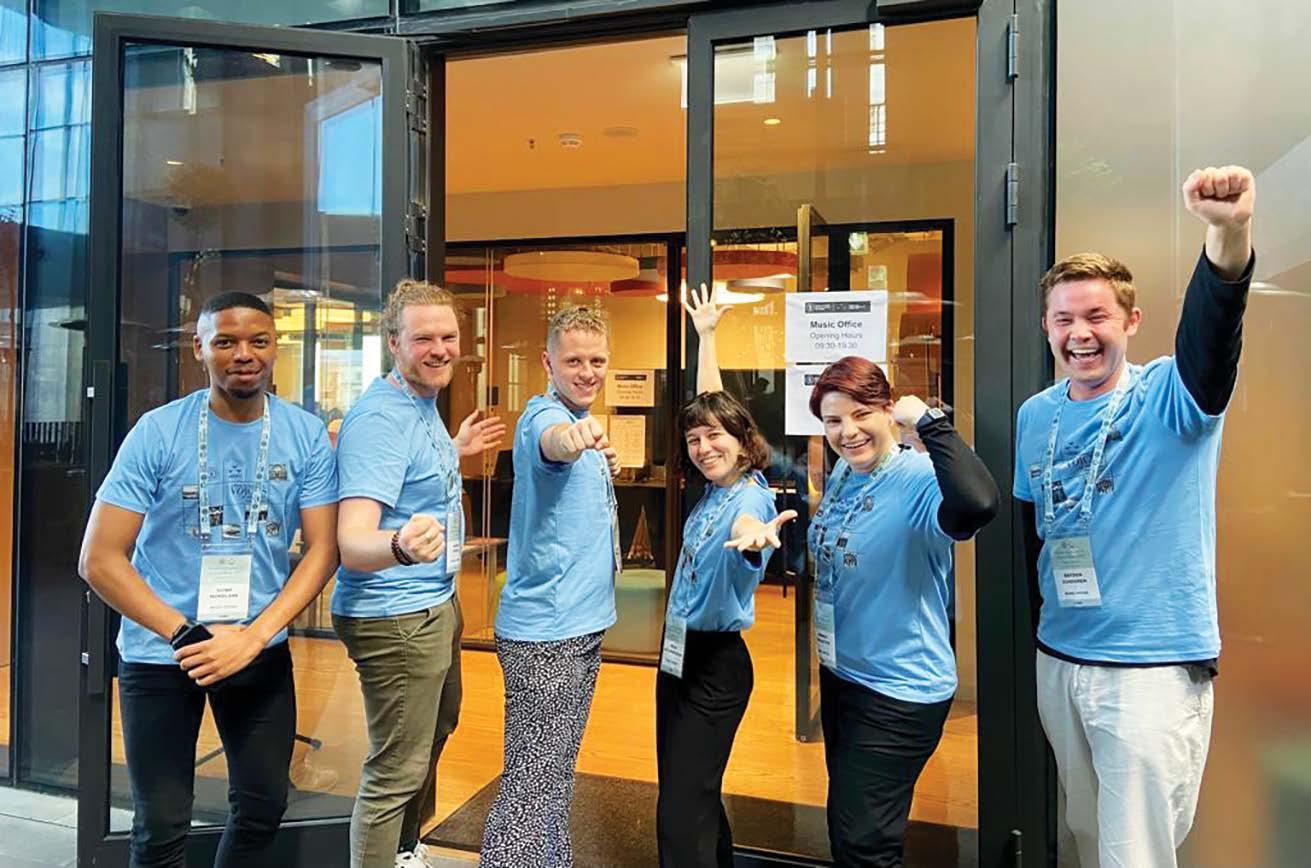
BRYDON SUNDGREN is a Civil Engineer and Project Manager based in Hamilton, New Zealand. He currently sings in the Hamilton Civic Choir, under the direction of Elise Bradley, and has been involved in choral singing since childhood. Brydon can also play the piano and cello and has completed an AMusTCL. Outside of music, Brydon enjoys spending time with his wife, hiking, organising events, playing boardgames, baking and being involved with his local church.
YOUNG 2023 were: Monika Grigaitytė (Lithuania), Sizwe Mondlane (South Africa), Anne Charlotte Parchaso Copiaco (Philippines), Jaime João Reis Casal (Portugal), Kwankaew Ruangtrakool (Thailand), Urša Šega (Slovenia), Brydon Sundgren (New Zealand), Viktória Széchy (Hungary), Sofía Torres Valenzuela (Chile), and Reece Windjack (USA).
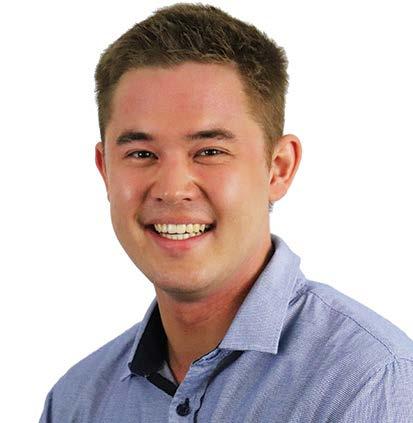
34 IFCM NEWS
From left to right: Sizwe Mondlane, Ruben Timmer, Reece Windjack, Pelin Küçükerdoğan, Monika Grigaitytė and Brydon Sundgren
The Turkish choirs that performed at the closing concert include many volunteers who helped make this symposium unique. A big thank you to them!
TRIBUTE TO H. ROYCE SALTZMAN, FORMER IFCM PRESIDENT


IFCM is deeply saddened about the passing of our dear friend and Honorary Member, Royce Saltzman, in Eugene, Oregon, USA, on April 3, 2023, in his 95th year.
Royce was a conductor, educator, co-founder and executive director of the Oregon Bach Festival, national president of ACDA (1979-1981), and founding member and president of the International Federation for Choral Music (1985-1993). He was a generous, creative and enthusiastic choral leader, a man of long-term vision and positive action whose diplomacy and wisdom, networks and exchange spaces have resulted in a very important legacy for the universal choral family and the future generations.
“Royce’s commitment to IFCM started in 1979 when he met a group of choral leaders determined to create an international organization that would facilitate cooperation and exchange between choirs, educational institutions, and national organizations. In 1981, at the national ACDA Convention in New Orleans, Royce initiated a choral summit, attended by leaders from thirteen countries. The group addressed issues such as touring, education, the sharing of information and materials, but foremost, the possibility of establishing an international organization that would facilitate cooperation and exchange. Royce then chaired an interim committee that met in Loughborough, England, to establish statutes, choose a name that would represent its global outreach, and determine Founding Organizations, which would provide support and validity to this fledging alliance. Thus, in 1982 the child IFCM was born.”1

This child is now 41 years old. Thank you, Royce! May your life and legacy inspire many choral leaders around the world.
Ms. Emily Kuo Vong and the IFCM Board members are sending their deepest condolences to Phyllis, daughters Kathy, Lisa, Jody and Marta and their children.
You can read the full obituary by the family on https://bit.ly/RoyceSaltzmanObituary
1 Extract of the article published in the International Choral Bulletin in January 2011, From Father to Daughter.... by Kathy
35
Saltzman Romey, one of Royce’s daughters.
1982 Europa Cantat, Namur, Belgium, Founding of IFCM
1989 Royce Saltzman, the IFCM Board during a meeting with the USSR Ministry of Culture, Moscow
1998, Eugene, Oregon Bach Festival, from left to right: Royce Saltzman, Krzysztof Penderecki, Helmuth Rilling, Elżbieta Penderecka © Archiv Bachakademie
Artikel auf Deutsch Article en français Artículo en español
Royce Saltzman was a wonderful friend with a decades-long influence on my life. He was one of the most insightful mentors anyone could ask for. He demonstrated the importance of becoming acquainted with others’ cultural values. He used international choral music to support and celebrate both the similarities and the wonderful differences between cultures throughout the world. He was the true ambassador for the world’s choral musicians. He opened my eyes to what a peaceful world there could be if we genuinely understood each other. The result has been profoundly rewarding. Royce dedicated his life to such endeavors and swept me up in his vision. I will miss him so.
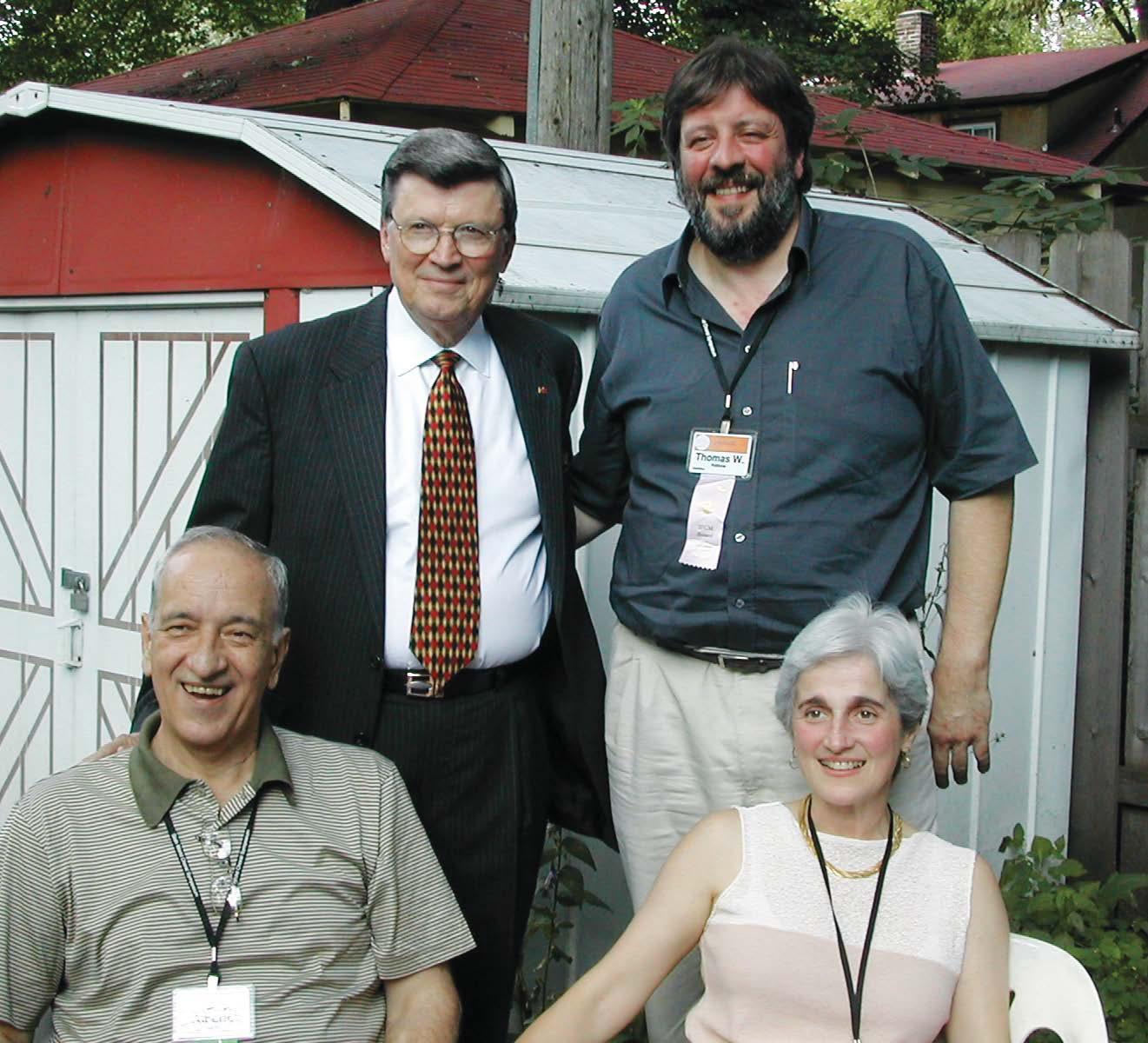 Michael J Anderson, IFCM Former President
Michael J Anderson, IFCM Former President

Royce Saltzman has been my friend and music colleague since 1979, when I met him while he was ACDA National President. At the numerous IFCM World Symposia on Choral Music I attended, I witnessed Royce addressing international gatherings very articulately and diplomatically. He was a consummate gentleman and musician, and will forever be my role model. Royce was always
gracious, very compassionate, a great listener, an excellent leader and educator, and a man of deep faith. One could always count on his positive and nurturing spirit. I will miss you, Royce. Soli Deo Gloria!
Diana J. Leland
Royce (and his wife Phyllis and their daughters) have been an important part of my life for many years, for which I am very grateful. This friendship and esteem had grown over the years since I first met him in 1981, in New Orleans. His vision and action were essential to the creation and development of the IFCM (which also became an essential part of my life). Together with my husband Claude, we had many mutual personal and choral visits and exchanges. The friendship with Royce’s family continues to this day. The last time I “saw” him was on FaceTime just a few weeks before his passing. He was in good spirits, even though his health had visibly worsened. Royce will live on in my heart and memories; he will not be forgotten.
Jutta Tagger, Editor Emerita of the International Choral Magazine
36 IFCM NEWS
ACDA National President (1989-91) Former member of the IFCM Board
WSCM 2002, Minneapolis USA, Royce Saltzman, Thomas Rabbow, Alberto Grau and Maria Guinand
Michael J Anderson, Walter Collins and Royce Saltzman on a trip to Paris, Namur and Israel in 1987
I met Royce Saltzman in 1980 in Vaison-la-Romaine. I was a young student of choral conducting, and he was a choral director who taught a workshop on negro spirituals. I found him to be a very kind and musical man. I met him again in Namur in 1982 at the founding of the IFCM. I admired his leadership and his enthusiasm for this fledgling international choral association, and I found his commitment captivating. I have worked for the IFCM ever since. For me, he exemplified leadership and future vision. A few years later, Royce invited me to attend the Oregon Bach Festival as a part of Helmuth Rilling’s conducting class, and from that moment on, my artistic and institutional life changed completely. I discovered a wonderful world of musical performance, youth education and creativity within new repertoires. Royce was the person who, with much generosity and trust, opened many artistic doors for me in my professional life and encouraged me to pursue a life in international choral music. It has been my fortune to have coincided in time and space with such a special, generous, assertive, enthusiastic, and committed man like Royce.
I was lucky to have him as a friend and mentor alongside Phyllis for so many years.

 María Guinand IFCM Vice-President
María Guinand IFCM Vice-President
We all know what a significant contribution Dr. Saltzman made to the choral community worldwide. I loved that he always had a gracious smile and dignity at the same time, and admired him whole-heartedly. Thirtynine years ago, in July 1984, I conducted a seminar for children at the “World Chorus Festival – Asia Cantat” in Nagano. Dr. Saltzman came to observe our session when we were rehearsing Bach works I had selected. He gave us a word of compliment, and I am here today because his remark encouraged me and gave me a
sense of pride. I think this event was the first step for Japan to become part of the international choral music world. I have countless memories, but wanted to share this story from the past. I am full of gratitude for Dr. Saltzman, for his visit to our country and for guiding us to the international community. Dr. Saltzman, please keep watching IFCM, which you and others founded.
Saeko Hasegawa, President, Japan Choral Association
I’d just turned 30 and was applying for the position of director of the International Center for Choral Music in Namur, Belgium. Royce was interviewing each of the candidates. I recall a long walk, just the two of us, and a fascinating conversation during which we shared our vision of the needs of the choral world on a global scale. Our collaboration and discussions continued for over 20 years, while he headed the IFCM. I will never forget the humility and greatness of spirit of this man who was one of my mentors. Rest in peace, Royce.
Jean-Claude Wilkens Former IFCM Secretary General

37
María Guinand's tribute translated by Joel Hageman, USA
Royce Saltzman and Helmuth Rilling at the Oregon Bach Festival in 2004
Royce at the IFCM Youth Forum — Voice, Youth and Arts Management, in Caen, Normandy, France, in 2008
IFCM Presidents, Eskil Hemberg, Paul Wehrle and Royce in 2002
I met Royce Saltzman for the first time when I was volunteering at the Europa Cantat Festival in Namur in 1982. I happened to be invited to take notes during the founding board meeting of IFCM. When I started working in the choral field 10 years later, I began attending World Symposia and met Royce again, both at the end of his presidency (Vancouver, 1993) and later as past president. From the first moment, Royce impressed me with his gentle and diplomatic character, which made him an ideal president of an international federation such as IFCM. It was always a pleasure to meet him.
Sonja Greiner, Secretary General of the European Choral Association
Royce Saltzman was a visionary for the international development of choral singing. He was always interested in and eager to know more about choral life both within and outside his country. His great humanity and natural communicative friendliness drove his awesome dynamic character that he imprinted on the choral world in the late 70s, leading to the creation of IFCM in 1982. He can be considered as one of the founding fathers of IFCM. The choral world has lost one of its greats.
Jean Sturm Executive Director of Musica International
Royce Saltzman had a knack for bringing people together in common purpose. That talent was the foundation of the Oregon Bach Festival, which he created with Helmuth Rilling in 1970, and one of the many stones upon which IFCM was built. He was a gentleman of the first order, a man of kindness who could set anyone at ease and defuse conflict in short order— and with a smile. He also had a keen nose for talent in others, nurturing young performers on the verge of stellar careers. Many returned to the OBF year after year, becoming like family to the community. Royce’s
generosity was widespread and usually unknown except to its recipients, who treasured the man behind it. I knew Royce for nearly 50 years and would have had a completely different life had we not met. I will always be grateful that we did.
Gordon Paine
Professor of Music and Chair emeritus California State University, Fullerton OBF singer & seasonal staff, 1974–1999
I met Royce in 2007. He had been invited to serve as workshop leader at the Choralies in Vaison-laRomaine, and his presence energized the singers. Soon after creating an all-amateur choir, I asked him to come to Paris to lead a working weekend on a repertoire of his choosing. This man, who worked at such an exceptional artistic level, also had an empathy, a pedagogy, a gentleness that immediately won everyone’s support. Language presented no barrier; the music said everything better than words. I saw him often afterwards: the same smile, the same listening, a tolerance that allowed others to grow.
Thierry Thiébaut President of A Cœur Joie International Former member of the IFMC Board of Directors
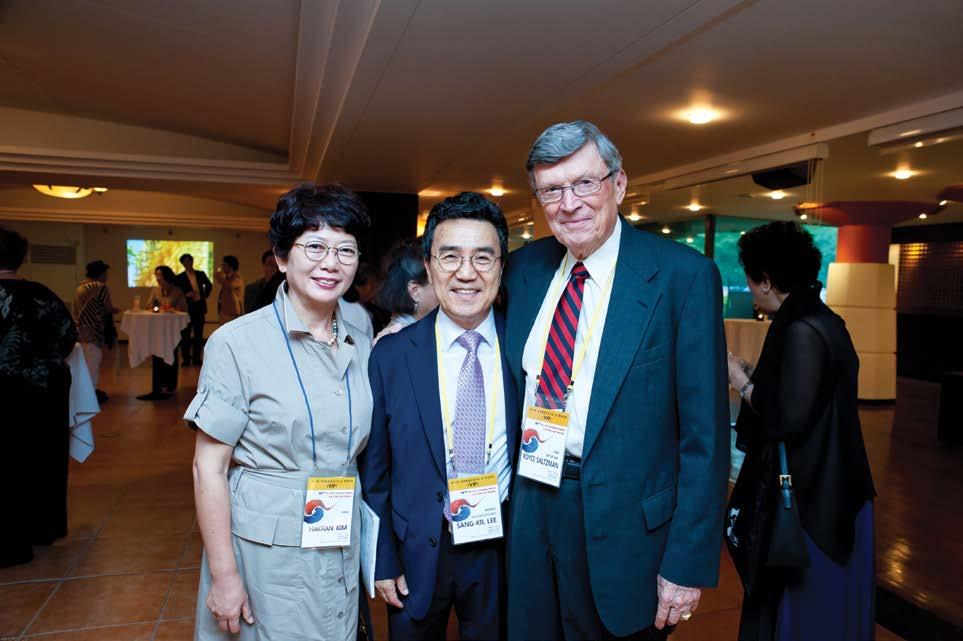
It was in 1984, at the start of IFCM’s second year of existence, that I met Royce. I had been invited to moderate a plenary session of ISME’s international conference on musical education in his home town of Eugene, Oregon. I met up with him again on the other side of the world, at the side of Claude Tagger, who had introduced me to the IFMC at its creation. In addition to the support of the first National Committee of Zaire, both men were hoping for the arrival of choirs from countries with non-Western cultures. Royce continued to edify me through his strong convictions and by encouragement, for example, in promoting African Choral News, a member newsletter that I’d founded. In
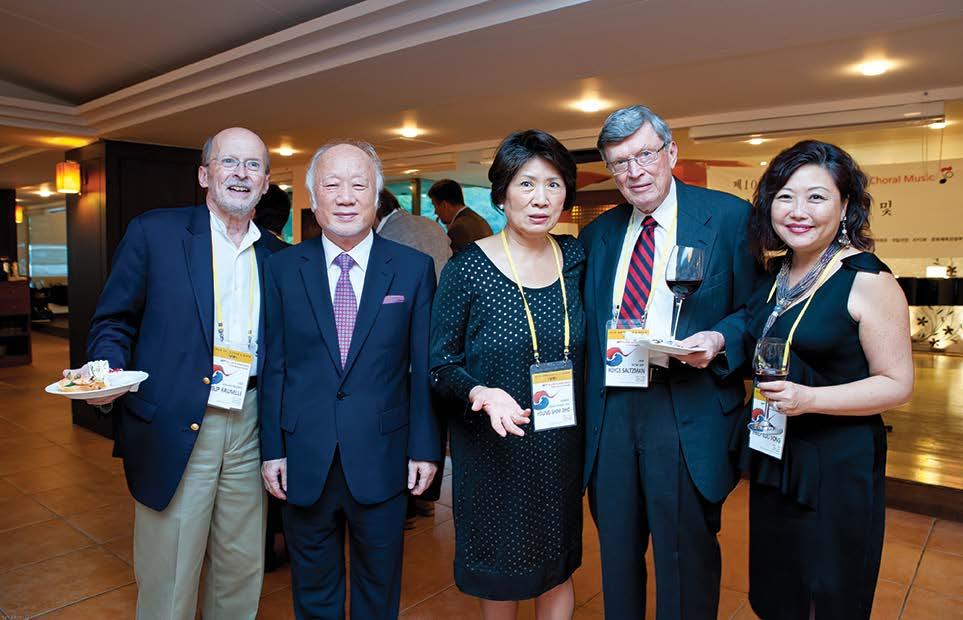
38 IFCM NEWS
From left to right: Philip Brunelle, Prof. Hak Won Yoon, Madam Dho, Royce and Emily Kuo Vong, WSCM 2014, Seoul.
Royce with Sang-Kil Lee and his wife, WSCM 2014, Seoul
fact, he considered diversity to be a sign of vitality and a mark of the universality of the international federation. This was a profession of faith he never stopped proclaiming. For the good of our House, let us hope it will remain, as the supreme guarantee of his identity and mission.
Maputo, Mozambique; April 24, 2023
Lupwishi Mbuyamba
Edited and translated from French by Anita Shaperd, USA
I bow my head in memory of our dear Royce Saltzman, who influenced many musicians in his humble way. I met him at a choir competition in Israel, where he served as a jurist, and was honored by his invitation to come to the Bach Festival in Oregon. I was also honored to meet Maestro Helmuth Rilling and to participate in the conductors' course.
Royce not only opened the gate to the professional world for me but also the door to his home. I met his dear wife Phyllis and even came to know a wonderful musician named Kathy.

Along with the Moran Singers Ensemble and the composer Menachem Weisenberg, we later sang at the Israeli Poetry Festival, a program that created a bridge between composers and cultures.
Phyllis and Royce's picture has always held a certain place on my piano. Their good, calm and straightforward look has accompanied me for many years.

I know Royce influenced many musicians in his humble and loving way. We will all miss him. In blessed memory.
Naomi Faran, founder and conductor of the Moran Choir, Israel
Edited
by Joel Hageman, USA
39
Royce and his beautiful wife Phyllis on their 70th Anniversary @ Josh Rose of Josh Rose Photography
WORLD CHORAL DAY 2023
“BE STRONG, HAVE COURAGE. NOBODY WALKS ALONE.”
On the 10th of December 2023, the second Sunday of December this year, we will again be celebrating World Choral Day. In 2022, Chris Artley from New Zealand wrote this wonderful anthem to celebrate the World Choral Day, On the Road of Life. We wish to invite everyone to send us a video recording of your group singing this song using the common accompaniment track found via this link (https://bit.ly/AnthemWCD22-23) so that we can put together a collage of videos from all over the world.
You may send your recorded materials to Irvinne Redor, IFCM Communication Manager & WCD Project Manager, at communication@ifcm.net by 31 October 2023.

O n t he R o a d o f L i f e
M u s i c : C hr i s A r t l e y
Ly r i c s : M i c he l a n n e F o r s t e r
L i f e i s a jo u r n e y
S o m e t i m e s yo u ' re a l o n e
A l o n e i n t he d a r k
F a r, f a r f ro m ho m e .
K i a k a h a , h a v e c o u r a ge
K i a k a h a , s t a y s t ro n g
K i a k a h a , h o l d fa s t
K n o w yo u b e l o n g
We w a l k t o g e t he r o n t he ro a d o f l i f e
We s t a n d t o g e t he r o n t he ro a d o f l i f e
H o l d f a s t o n t he ro a d o f l i f e
N o bo d y w a l k s a l o n e
K i a k a h a , h a v e c o u r a ge . . .
We d a n c e t o g e t he r o n t he ro a d o f li f e
K a n i k a n i , d a n c e , o n t he ro a d o f l i f e S t a n d p ro u d , o n t he ro a d o f l i f e
N o bo d y w a l k s a l o n e
K i a k a h a , h a v e c o u r a ge . . .
S o s ha re yo u r s t o r y o n t he ro a d o f l i f e
A n d c a re f o r o t he r s o n t he ro a d o f l i f e S p e a k o u t , o n t he ro a d o f l i f e
N o bo d y w a l k s a l o n e
K i a k a h a , h a v e c o u r a ge
M ā o r i t e x t m e a n i n g a n d p ro n u n c i a t i o n :
K i a k a ha ( be s t ro n g ) K E E - a K A - ha
K a n i k a n i ( d a n c e ) K A - n e e - K A - n e e *
* C a p i t a l l e t t e r s d e n o t e s t ro ng s yl l a bl e s
40 IFCM NEWS
41 { ° ¢ { ° ¢ { ° ¢ S B P n o L i f e p i s a jo u r n e y - s o m e t i m e s - yo u ' re a L a rg o q = 6 6 p ° ° ° ° ° ° ° l o n e , A l o n e - i n t he d a r k , F a r, mp f a r f ro m ho m e . K i p a - k a ha , - ha v e 4 mp p ° ° ° ° ° ° ° ° c o u r a g e , - K i a - k a ha , - s t a y s t ro n g , K i a - k a ha , - ho l d f a s t , k n o w yo u be 7 ° ° ° ° ° ° ° ° ° 4 4 5 4 4 4 5 4 4 4 5 4 4 4 5 4 5 4 4 4 5 4 4 4 5 4 4 4 & #### ∑ s o l o i s t o r s m a l l g ro u p O n t he R o a d o f L i f e Lyr i c s : M i c he l a n n e F o r s t e r M u s i c : C hr i s A r t l e y Fo r h i gh a n d l o w v o i c e s a n d pi a n o D u r a t i o n c 2' 58 " ? #### ∑ ∑ ∑ & #### # ? #### & #### a l l u p p e r v o i c e s & #### n # ? #### & #### & #### n n # n ? #### ‰ Œ Ó ‰ œj œ œ œ œ œ œ œ œ ‰ Œ œ œ œ œ œ œ œ œ œ œ œ ˙ œ œ œ œ ˙ ‰ œj œ œ œ ˙ ˙˙ œ œ œœ œ œ œ œ œ œ œ ‰ Œ œ œ œ œ œ œ œ œ œ œ œ ˙ œ j œ œj œ œ œ œ ‰ œj œ œ œ ˙ œ œ œ ˙ ‰ œ œ œ œ œ œ œ œ œ ˙ ˙ ˙ ˙ ˙˙ ˙ ˙ ˙ œ ˙ ˙ œ œ ˙˙ ˙ œ œ ‰ œ œ œ œ œ œ œ œ œ œ œ œ œj œ œj œ œ œ œ œ œ œ œ œ œ œ œ œ œ œ œ œ ™ œ ‰ œ œ œ œ œ ˙ ‰ œ œ œ #œ œ œ œ œ ‰ œ œ œ œ œ œ œ ™ œ œ œ ™ œ œ œ œ œ # ‰ œ œ œ œ œ œ œ ˙ ˙ ˙ œ œ ‰ œ œ œ œ #œ œ œ œ œ œ œ œ œ œ n œ œ # ‰ œ œ œ œ œ œ œ œ œ œ œ œ œ œ œ œ œ œ œ œ œ n œ œ œ œ
42 IFCM NEWS { ° ¢ { ° ¢ { ° ¢ l o n g A 1 0 We mp w a l k t o g e - t he r - o n t he ro a d o f l i f e , We s t a n d t o mp ° ° ° ° ° ° ° ° ° ° ° g e t he r - o n mf t he ro a d o f l i f e , H o l d f a s t o n t he ro a d o f l i f e N o bo - d y - w a l k s a1 4 mf ° ° ° ° ° ° ° ° ° ° ° K i mp a - k a ha , - ha v e c o u r a g e , - K i a - k a ha , - s t a y s t ro n g , K i a - k a ha , - ho l d 1 8 l o n e K i mp a - k a ha , - ha v e c o u r a g e , - K i a - k a ha , - s t a y s t ro n g , K i a - k a ha , - ho l d mp ° ° ° ° ° ° ° ° ° & #### ∑ ∑ ∑ ? #### ∑ & #### # n ? #### ? ####& #### # ? #### & #### ? #### & #### # n n # ? #### ˙ Ó Ó ‰ œj œ œ œ œ œ œ œ œ œ œ ‰ œj œ œ œ œ œ œ œ œ œ œ œ œ ˙ œ œ œ œ œ œ ˙ œ œ œ œ œ ˙ ˙˙ œ œ œœ œ œ œ œ œ œ œ œ œ œ œ œ œ œ œœ œ œ œ œ œ œ œ œ œ œ œ œ œ œ œ œ ™ œ œ œ ˙ ˙ œ j œ œj œ œ œ œ œ œ œ œ œ œ œ œ œ œ œ ˙ ‰ œ J œ œ œ œ œ ˙ œ œ œ œ œ ™ œ J œ ˙ ˙ œ œ œ œ œ œ œ œ œ ˙˙ ˙ œ œ ‰ œj œ œ ˙ œ nœ œ œ ˙œ œ œ œ œ œ œ œ œ œ œ J œ œj œ J œ œ œ œ œ œ œ œ œ œ œ œ œ œ œ ˙ ˙ ˙ œ ™ ˙ œ J œ œ ˙ œ œ Ó ‰ œ œ œ œ œ œ œ ™ œ ‰ œ œ œ œ œ ˙ ‰ œ œ œ #œ œ ˙ ‰ œ œ œ œ œ œ œ ™ œ ‰ œ œ œ œ œ ˙ ‰ œ œ œ #œ œ ˙ ˙ œ ‰ œ œ œ œ œ œ œ œ ™ œ œ œ ™ œ œ œ œ œ # ‰ œ œ œ œ œ œ œ ˙˙ ˙ œ œ ‰ œ œ œ œ #œ œ ˙ œ œ œ œ œ œ œ œ œ œ ™ œ œ œ œ œ œ œ œ œ œ 3
f a s t , k n o w yo u be l o n g
mf d a n c e t o g e - t he r - o n t he ro a d o f
f a s t , k n o w yo u be l o n g
°
l i f e , K a n i - k a - n i , - d a n c e , o n 2 5
mf
& #### n # ? #### & ˙ œ j œ œj œ œ œ œ ‰ œ œ œ œ ˙ œ œ œ œ ˙ ‰ œj œ ˙ œ œ œ œ n˙ ‰ œ œ œ œ ˙ œ œ œ œ ˙ ‰ œ J #œ œ nœ œ œ ˙ œ œ œ œ œ œ œ œœ œ œ œ œ œ œ ˙ ˙ ˙ œ œ œ œ œ œ œ œ ˙˙ ˙ œ œ
& #### n # ? #### & #### ? #### & ####
? ####
l i f e , N o bo - d y - w a l k s a l o n e . - K i 2 9
mf a - k a ha , - ha v e c o u r a g e , - K i a - k a ha , - s t a y œ œ œ œ œ œ n œ ™ œ œ œ œ œ œ œ œ ™ œ œ œ œ œ œ ™ œ œ œ ˙
#
-
f t he ro a d o f l i f e , S t a n d p ro u d o n t he ro a d o f l i f e , f
n n
mf ° ° ° ° ° ° ° ° ° & #### ? ####
43 { ° ¢ { ° ¢ { ° ¢
We B 2 1
We ° ° ° ° ° ° ° ° °
mf d a n c e t o g e - t he r - o n t he ro a d o f
f t he ro a d o f l i f e , S t a n d p ro u d o n t he ro a d o f
l i f e , K a n i - k a - n i , - d a n c e , o n ° ° ° ° ° ° ° ° ° ° ° °
mf a - k a ha , - ha v e c o u r a g e , - K i a - k a ha , - s t a y
n o bo - d y - w a l k s a l o n e - K i œ œ œ ‰ œ œ œ œ œ ˙ Ó Ó ‰ œj œ œ œ œ œ œ œ œ œ œ œ ‰ œ œ œ œ œ ˙ Ó Ó ‰ œj œ œ œ œ œ œ #œ œ œ œ œ œ œ œ œ œ n œ œ # ‰ œ œ œ œ œ œ œ œ œ œ œ œ œ œ œ œ œ ˙ œ œ œ œ œ œ ˙ œ œ œ œ œ ˙ ˙˙ œ œ œœ œ œ œ
#### ‰ œj œ œ ˙ œ nœ œ œ ˙œ œ œ œ œ œ œ œ œ œ œ œ œ œ œ œ œ œ œ œ œ œ œ œ œ ˙ ˙ ˙ œ ™ œ J œ œ œ œ œ ™ œj ˙ ‰ œ œ œ œ œ œ œ ™ œ ‰ œ œ œ œ œ œ œ œ œ œ ™ œ J ˙ ‰ œ œ œ œ œ œ œ ™ œ ‰ œ œ œ œ œ œ œ œ œ œ œ œ ™ œ J œ œj ˙ œ J ˙ œ ‰ œ œ œ œ œ œ œ œ ™ œ œ œ ™ œ œ œ œ œ # ‰ œ œ œ œ œ œ œ ˙ œ œ ˙ œ œ
˙ œ œ œ œ œ œ œ œ œ œ ™ œ œ œ
? #### 4
C 3 6
s t ro n g , K i a - k a ha , - ho l d f a s t , k n o w yo u be -
s t ro n g , K i a - k a ha , - ho l d f a s t , k n o w yo u be -
f s ha re yo u r
l o n g . S o ° ° ° °
s t o r y - o n t he ro a d o f l i f e , A n d c a re f o r o t he r s - o n t he ro a d o f l i f e , S p e a k o u t ,
s t o r y - o n t he ro a d o f l i f e , A n d c a re f o r o t he r s - o n t he ro a d o f l i f e , S p e a k o u t ,
44 IFCM NEWS { ° ¢ { ° ¢ { ° ¢
3 2
° ° ° ° ° °
l o n g S o 3 4
f s ha re yo u r f
° ° ° ° ° ° ° ° ° ° ° ° ° & #### ? #### & #### # n ? #### & #### b ? #### b & #### nbnn n b ? #### b & b? b& b # n # ? b ˙ ‰ œ œ œ #œ œ œ œ œ ‰ œ œ œ œ œ ˙ ‰ œ œ œ #œ œ œ œ œ ‰ œ œ œ œ œ ˙˙ ˙ œ œ ‰ œ œ œ œ #œ œ œ œ œ œ œ œ œ œ n œ œ # ‰ œ œ œ œ œ œ œ œ œ œ œ œ œ œ œ œ n œ œ œ œ ˙ Ó Ó ‰ œ n j nœ nœ ˙ Ó Ó ‰ nœj nœ nœ œ œ œ œ œ œ œ œ œ œ œ œ œ œ œ œ œ œ œ œ œ œ œ œ œ n œ œ œ œ œ œ œ ™ œ œ œ œ œ œ œ œ ™ œ ˙ n n˙ œ œ œ œ œ œ œ œ ‰ œj œ œ œ œ œ œ œ œ ˙ ‰ œj œ œ œ œ œ œ # œ ˙ n ‰ œ J œ œ œ œ œ œ œ œ ˙ ‰ œ J œ # œ ˙ ˙˙ œ œ œœ œ œ œ œ œ œ œ œ œ œ œ œ œ œ œœ œ œ œ œ œ ˙ ˙ ˙ œ œ œ œ œ œ œ œ ˙˙ ˙ œ œ ‰ œj œ œ œ j œ œj œ œ œ œ œ œ œ œ œ œ œ œ œ œ œ œ œ œ œ œ œ œ œ œ 5
6
o n t he ro a d o f l i f e , N o bo - d y - w a l k s a l o n e . - K i a - k a ha , - ha v e
o n t he ro a d o f l i f e , n o bo - d y - w a l k s a l o n e - K i a - k a ha , - ha v e
b ˙ œ œ œ œ œ œ œ œ œ ™ œj ˙ ‰ œ œ œ œ œ œ œ n œ œ ˙ œ œ œ œ œ ™ œ J ˙ ‰ œ œ œ œ œ ˙ œ nœ œ œ ˙œ œ œ œ œ œ œ œ œ œ ™ œ J œ œj ˙ œ J ˙ œ ‰ œ œ œ œ œ œ ˙ ˙ ˙ œ ™ ˙ œ J œ œ ˙ œ œ
b ˙ œ œ œ œ œ œ œ œ œ œ œ ‰ œ œ œ œ œ ˙ ‰ œ œ œ #œ œ œ œ œ ‰ œ œ œ œ œ ˙ ‰ œ œ œ œ # œ œ œ œ œ œ ™ ™ œ œ œ œ œ n ‰ œ œ œ œ œ œ œ ˙˙ ˙ œ œ
c o u r a g e , - K i a - k a ha , - s t a y s t ro n g , K i a - k a ha , - ho l d
c o u r a g e , - K i a - k a ha , - s t a y s t ro n g , K i a - k a ha , - ho l d
r i t . a t e m p o
mp l o n g45
mf mp ° ° ° ° ° ° ° ° & b ? b & b # ? b &
b U u ? b U u
œ œ œ œ œ œ œ œ œ œ œ œ œ œ œ œ ˙ ˙ œ œ n œ ™ œ œ œ œ œ œ œ œ ™ œ œ œ œ œ œ œ œ œ ™ œ œ œ œ œ œ œ œ ˙œ œ œ
‰ œ œ œ œ #œ œ œ œ ™ œ œ œ œ œ œ œ œ œ œ œ œ œ ‰ œ œ œ œ œ ˙ ‰ œ œ œ œ œ ˙ Œ œ w œ œ œ ‰ œ œ œ œ œ ˙ ‰ œ œ œ œ œ ˙ Œ œ w œ œ œ œ œ œ œ œ n œ œ n ‰ œ œ œ œ œ œ œ œ œ œ œ œ œ œ œ œ œ œ œ œ œ œ
b U u
mf yo u be l o n g , be
45 { ° ¢ { ° ¢ { ° ¢
40
°
° ° ° ° ° ° °
43
°
° ° ° ° °
f a s t , k n o w yo u be l o n g k n o w
?
&
f a s t , k n o w yo u be l o n g . k n o w n
mf yo u be l o n g , be # ? b & b U U ? b U U & b b
mp l o n g .U u
CHORAL WORLD NEWS
SOARING NEW HEIGHTS: TRANSITIONING CHORAL PERFORMANCE FROM SCREEN TO STAGE

46
CHORAL WORLD NEWS
Maria Theresa Vizconde-Roldan
Panda van Proosdij (Netherlands) at her session "From Voice & Physique to Choireography" © WSCM 2023
SOARING NEW HEIGHTS: TRANSITIONING CHORAL PERFORMANCE FROM SCREEN TO STAGE
DR. MARIA THERESA VIZCONDE-ROLDAN President, Treble Choir Association of the Philippines, Vice-President for Projects, Philippine Choral Directors Association
THE CHORAL COMMUNITY HAS HAD TO ATTUNE TO A CONSTANT EBB AND FLOW OVER THE PAST TWO YEARS. WE HAD TO RESORT TO A PURELY VIRTUAL MEANS OF SUSTAINING REHEARSALS AND PERFORMANCES BUT, WITH RECENT DEVELOPMENTS, MOST CHOIRS HAVE GRADUALLY BEEN ABLE TO TRANSITION BACK FROM SCREEN TO STAGE.
This new beginning is accompanied by its own set of challenges as well as opportunities for us as a community of musicians. We must welcome every new encounter with open arms, minds and hearts.
Amidst these changes, the Treble Choir Association of the Philippines (TCAP) launched two annual main events: Lux Spei: Light of Hope and Sing as One. While the themes may differ each year, their overarching goal has always been to serve as an avenue for choirs to collaborate locally and internationally.
When the pandemic was at its peak, our ability to carry out these events was unfortunately restricted. Though technology allowed us to hold these on the virtual stage, I, along with musicians all over the world, could not help but long for the chance to physically gather together again and be able to hear our choirs harmonize beyond a recording.
Thankfully, we began to adapt resiliently. Our choirs were able to return to in-person rehearsals and to sing monthly for the Eucharistic Mass We then took the next step and organized our first face-to-face event after two years.

On 27 November 2022, the Young Voices of the Philippines Festival Choir (YVPFC) gathered to sing together live in celebration of TCAP’s third annual choral festival, Lux Spei: Light of Hope. This festival choir featured over 200 young choristers from around the Philippines. What a wonderful coincidence that the first candle lit on the Advent wreath symbolizes hope and that the event was held on the first Sunday of Advent. Moments of serendipity like this empower us to continue our mission to bring hope and inspiration to the lives of others through music
The Advent wreath represents newness and continuity of life−signifying that we ourselves push through to this post-pandemic era. Likewise, the festival represented a new start for our choral community, where we could convene again in a Eucharistic celebration through the highest form of praise.
The sound of the children of YVPFC singing all together resonated throughout the entire cathedral. Finally hearing dozens of voices harmonize to compositions and arrangements by TCAP reminded all of us that organizing this event was worth every second. With that, I would like to thank the
47
Artikel auf Deutsch Article en français Artículo en español
following choirs who participated in the YVPFC for singing the “Mass of Life: A Mass Setting for Children’’ composed by Prof. Jude B. Roldan:

• Balon Dagupan Children and Youth Choir − Ms. Virginia Llamas-Mendoza, Conductor
• Calasiao Children’s Chorus − Dr. Gilbert Allan N. Dispo, Conductor
• Caleruega Children’s Choir − Ms. Jelyn Matalog, Conductor
• Himig Roseña − Ms. Jarzihna Ines, Conductor
• Kilyawan Consortium of Voices
Children’s Choir − Mr. Leonard Cleofas, Assistant Conductor
• Quezon City Performing Arts
Children’s Choir − Mr. Nicanor Infante, Conductor
• St. Paul College Pasig High School Chorale − Mrs. Sheila
Marie B. Fetalvero, Conductor
• St. Jerome Youth Choir − Ms. Abigail de Leon, Conductor
• Woodrose Chorale − Ms. Myrene Bagayaua-Carballo, Conductor
• Kantabella
• Young Voices of the Philippines
− Prof. Jude B. Roldan, Music Director
In addition, on 3 January 2023, TCAP released another virtual performance under our annual Sing as One project featuring the Young Voices of the World (YVW)
Eleven choirs from across eight countries sang “We Rise and Sing,” an original piece composed by Prof. Jude B. Roldan with lyrics by Marian Abio.
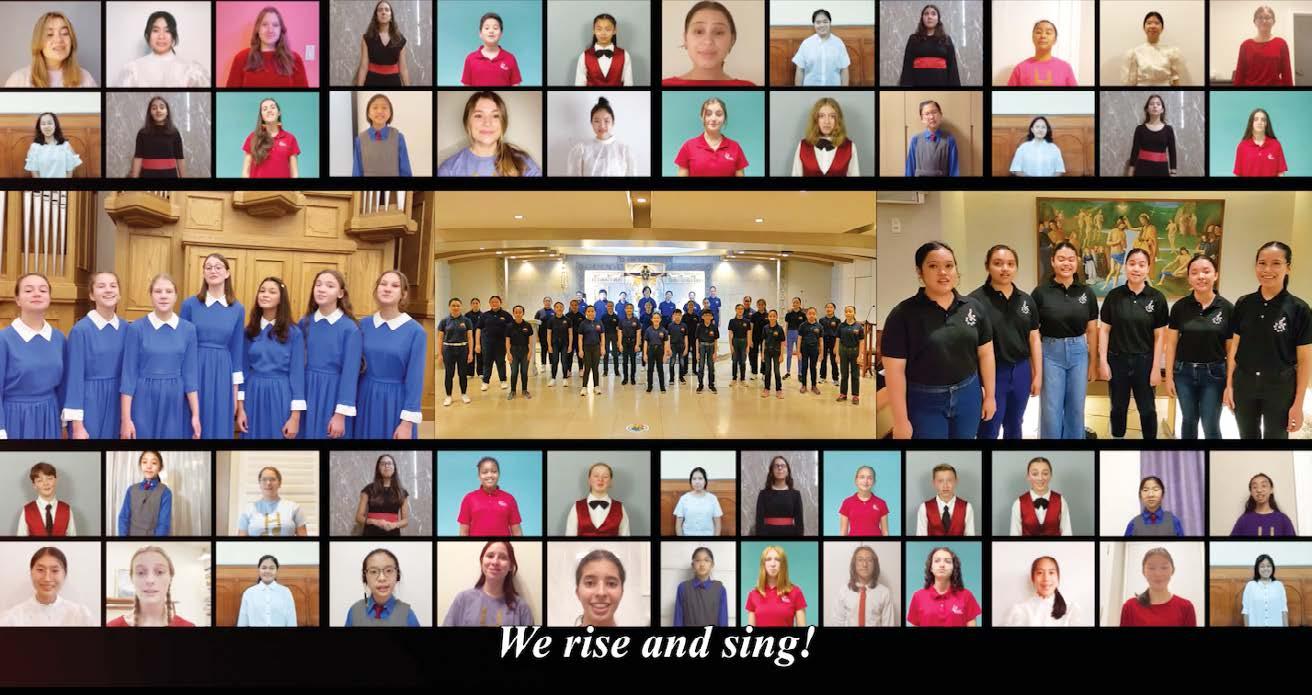
Through this song, we wanted to spread a message of hope, unity and peace as we brought together an international collaboration of renowned children’s choirs from all around the globe. YVW performed this song in solidarity with the less fortunate standing united for peace despite our differences. It was truly heartwarming to receive such an enthusiastic willingness from the participating choirs. Once again, we have succeeded in defying physical limitations with our dedication to music-making. I would like to thank the following choirs for participating in our most recent Sing as One performance:
• Children’s Chorus of Washington
− Margaret Nomura Clark, Conductor
• Coro Juvenil do Instituto Gregoriano de Lisboa − Filipa Palhares, Conductor
• Diocesan Girls’ Junior School Choir − Kelvin Lau, Conductor
• Hamilton Children’s Choir − Melanie Tellez, Conductor
• Shenandoah Valley Children’s Choir − Janet Hostetter, Conductor
• Saint Angela Choir − Roni Sugiarto, Conductor
• Toronto Children’s Chorus − Zimfira Poloz, Conductor
• Ponomaryov Vesna Children’s Choir − Nadezhda Averina, Conductor
• Wattana Girls’ Chorus − Sathit Sukchongchaipruk, Conductor
• Kantabella
• Young Voices Of The Philippines
− Prof. Jude B. Roldan, Music Director
Here is the link:
https://youtu.be/CbylccawAx0
Emboldened by the success of Lux Spei, we grew excited for the rest of TCAP’s plans to take the next step forward now that a world of possibilities has opened up for us. It has long been a distant dream for us to ultimately organize and experience Sing as One as a faceto-face event. Now, for the first time ever since its inception, we are delighted to announce that Sing as One will take place in-person on 7 July 2023, where the Young Voices of the Philippines (YVP) will be performing at the prestigious Carnegie Hall in New York City along with St Genevieve Valiant Voices directed by Mr. Cristopher Avendano, Virginia Children’s
48
CHORAL WORLD NEWS
YVPFC with His Excellency Most Reverend Honesto Ongtioco, DD Bishop of Cubao
Chorus with Corbin Thomas Pinto, Toronto Children’s Chorus with Zimfira Poloz and Matthew Otto, Children’s Chorus of Washington with Margaret Nomura Clark, and the Shenandoah Valley Children’s Choir with Dr. Janet Hostetter to premiere Prof. Jude B. Roldan’s “Missa Virtutum.”
Aside from these notable achievements, YVP has achieved many milestones. They were recently inducted as the newest and youngest artist of the Jesuit Music Ministry, a local producer and publisher of widely used liturgical music. I extend my deepest gratitude to both the Jesuit Music Ministry and the Jesuit Communications Foundation the media arm of the Philippine Province of the Society of Jesus − for giving YVP the opportunity to contribute to the ever-growing body of Philippine liturgical music. They also took part in celebrating the International Federation for Choral Music’s (IFCM) World Choral Day and were recently featured as the headline choir of the 2022 National Convention of the Philippine Choral Directors Association.
That said, this year holds much in store for us, with many events to look forward to. From 1 to 3 July we will be representing the Philippines in the Voices Together: An International Youth Choral Symposium During this 3-day event, we will be showcasing Philippine music and presenting our choral curriculum at the University of Maryland along with a performance at the Clarice Smith Performing Arts Center in College Park, MD.
We could not be more thankful for every opportunity that has been presented to us and we appreciate all the support we have received thus far. We are very much looking forward to everything that is to come for our organization and our choirs. Venturing into a new world after the pandemic, TCAP is dedicated now more than ever to weathering new heights and braving new beginnings with inspired and grateful hearts.
Dr. MARIA THERESA VIZCONDE-ROLDAN

graduated Summa Cum Laude with a Doctorate of Musical Arts at Saint Paul University Manila. She finished her Bachelor of Music in Music Education Cum Laude and a Master's degree in Conducting from the University of Santo Tomas Conservatory of Music, where she is also part of the faculty. She is known for her choral method, "GESTAPHOR" and Groundwork for Part-Singing. In line with their advocacy, Theresa and her husband, Jude, write choral music for children's choirs and arrange Philippine folksongs. Hal Leonard and Pavane in the USA published some of their works. In partnership with Muziksea, a digital choral music publisher in Singapore, they produced the Maria Theresa VizcondeRoldan Choral Adventures Series. Theresa is also the artistic director of Young Voices of the World, Young Voices of Asia, and the Young Voices of the Philippines Festival Choir. She conducts the two scholar choirs of the Treble Choir Association of the Philippines, the Young Voices of the Philippines, and Kantabella. She is also the founding conductor of the first-ever Children's Choir of the World winner at the Llangollen International Musical Eisteddfod and Choir Olympic Champion at the World Choir Games in Germany. mtvizconderoldan@yahoo.com
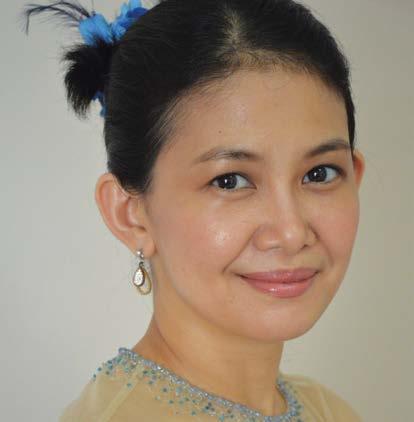
Might this work until your Music Folder arrives?









Iadmit that the Sticky Notes Flip Score is no substitute for a genuine folder from MUSICFOLDER.com. And I apologize for the fact that current supply-chain issues, factory upgrades and high demand are putting some of our folders on back-order. The good news? You can order online now to get instantly slotted into our production run and receive your new folder(s) as soon as possible. Thanks for your patience! They’re worth the wait.

49
www.colbertcreative.com (604) 681-5386
Premium folders in many sizes and con gurations. MUSICFOLDER.com
Ian Bullen, President
~ The Sticky Notes Flip Score ~
COMPOSER'S CORNER
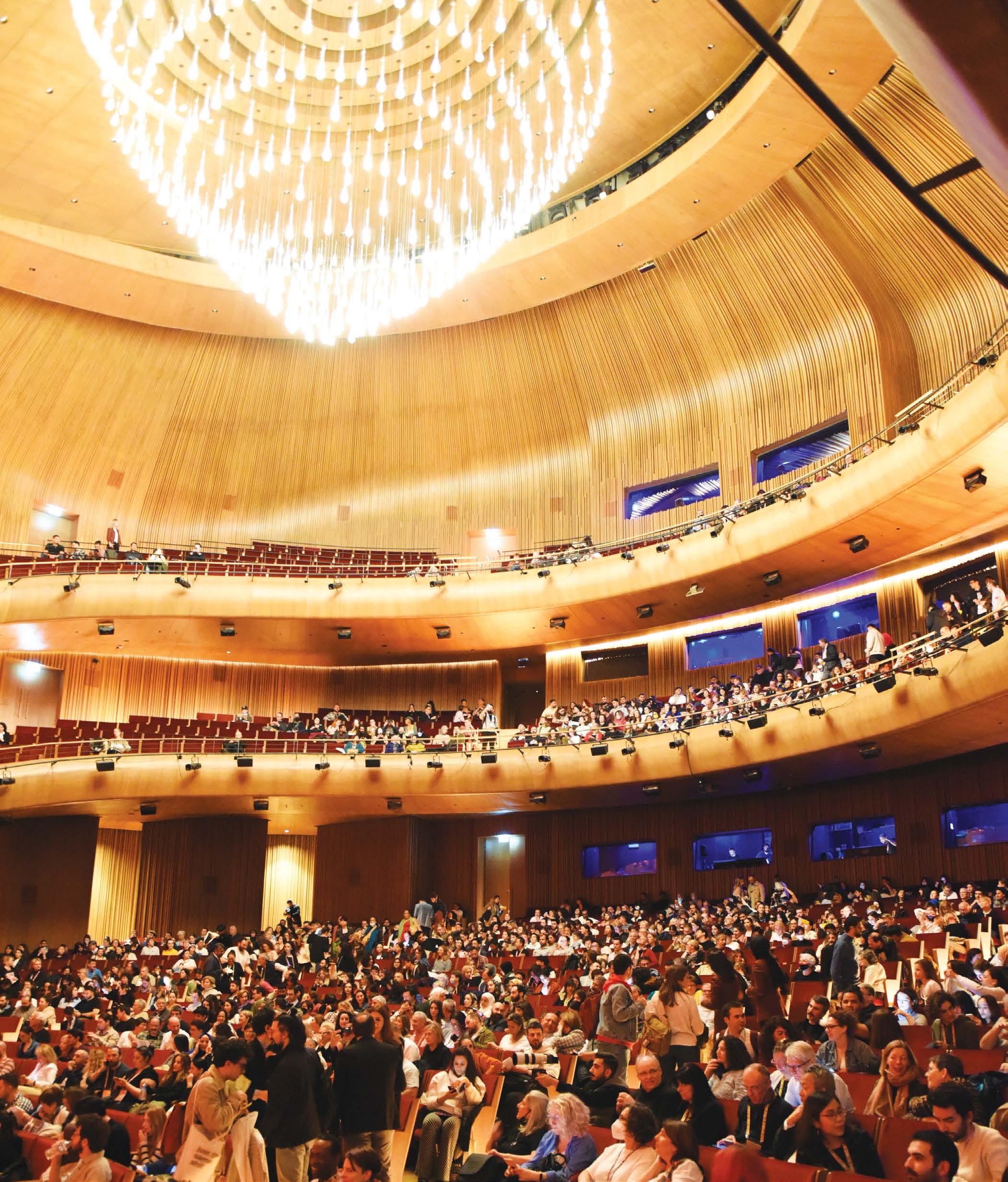
INTERVIEW WITH TAKATOMI NOBUNAGA
by Isabelle Métrope
50
COMPOSER'S
CORNER
WSCM 2023 Opening
at
Center
©
Gala
Atattürk Cultural
Opera Hall
WSCM 2023
INTERVIEW WITH TAKATOMI NOBUNAGA
BY ISABELLE MÉTROPE
Dear Mr. Nobunaga: which region/city do you come from, and to which extent do your roots influence your work as a composer?
I was born in Tokyo. My parents are from the Hiroshima Prefecture, and my mother was a victim of the atomic bomb, so I grew up listening to her stories of the horrors of the A-bomb. This has influenced me to write many choral works to texts with prayer for peace.
Why did you become a composer and how did you get into professional (=intensive) music-making and writing?
I have loved looking at music scores since I was a child. Before I knew it, I was writing notes myself. My music teacher at my primary school had a strong passion for teaching choral music, and the encounter with him was also a major reason for me falling in love with music. Becoming a professional composer was not my intention when I was a student, so I did not go to a school specialising in music. No one ever taught me piano or composition. I was purely self-taught. After graduating from University, I worked for a local government for three years, but I kept writing music in the meantime. I gradually became a professional composer after winning awards in several composition competitions.
Do you compose only for voices, or do you also compose for instruments, and what makes composing for choirs so unique (apart from the fact that you can add lyrics)?
The majority of my work is choral, but I also compose for instruments. Some bigger-scale works include Marimba Concerto (http://tiny.cc/yp96vz) and a piece for a wind orchestra (https://youtu.be/icVPgXyk8Uc). I also compose choral works accompanied by orchestra. What makes choral music special is that human voices have broad expressions of emotion that instruments cannot match. I think that is the biggest strength. Plus, children, youth, and adults have different voice colours, respectively, that can only be expressed at their life stage, which also makes choral music fascinating.
Do you sing yourself?
I used to sing in a choir when I was young, but I don’t have opportunities to sing these days. Occasionally, I have opportunities to conduct choirs.
What are your favourite topics for composing choir music, and why?
It is a difficult question because I am interested in various composing techniques. I temporarily preferred soundscape-like techniques. From there, my area of interest expanded to techniques that create artificial echo as well as heterophony.
On the other hand, I also have a strong interest in presenting the beauty of melody lines simply, and writing melody lines matching the texts.
What music, composer, musician or period in music history represent your musical homeland?
I don’t think I have a particular “core” as such. My top interest is what the composers of our time think and communicate, and is not limited to choral music. Among Japanese composers, I was influenced by Akira Miyoshi.
What does choral singing mean for you?
It is my life itself.
What do you wish for the future of the choral world?
I don’t know much about the choral world other than that in Japan, so I can only comment on Japan. Choral music is a genre “to enjoy participating” rather than “to enjoy listening.” As a result, it is not easy to entice people who are not choral singers to concert halls. I think choral conductors, choral singers, and composers all need to think about how to bring people with different backgrounds to chorus concerts, like orchestra or opera concerts. I believe it would lead to the choral community becoming more popular. Secondly, for enhancing the culture of choral music, we need to create a lot of opportunities for children and the youth so they can recognise the joys of choral music and to participate in choirs. To achieve this, we may need a movement to change government policies. I believe it is important for people involved in choral music to have views for society, not just having fun on their own.
51
Artikel auf Deutsch Article en français Artículo en español
COMPOSER’S CORNER
What are your current projects?
An opera, “Mountains and Seagulls” which premiered in Matsumoto City, Nagano in January 2022, will be performed again in Matsumoto City on 23 and 24 December 2023. I also have plans to compose some more Choral Opera and Grand Opera in the future. While composing choral works passionately as I have done so far, I want to do what I can in broader areas of stage arts.
Edited by Charlotte Sullivan, UK
Born in Japan in 1971, TAKATOMI NOBUNAGA graduated from Sophia University, Faculty of Humanities in 1994. Among the Awards he received: The Asahi Award for Composition (choral music), 1994, 1995 and 1999; 1st Prize in the Sogakudo Japanese Song Competition (composition department), 1998: Finalist of the New Composer Award held by the Japan Society for Contemporary Music, 2000: 2nd Prize in the Japan Music Competition (chamber music section), 2001. His major works are Cantos Nuevos for mixed chorus (or male chorus) and piano, Fragments – Notes of the War-Dead from Tokkotai Special Attack Units – for solo vocal (or male chorus) and piano, Marimba Concerto “The Crossed Sonar of Dolphins”, Opera “Mountains and Seagulls”
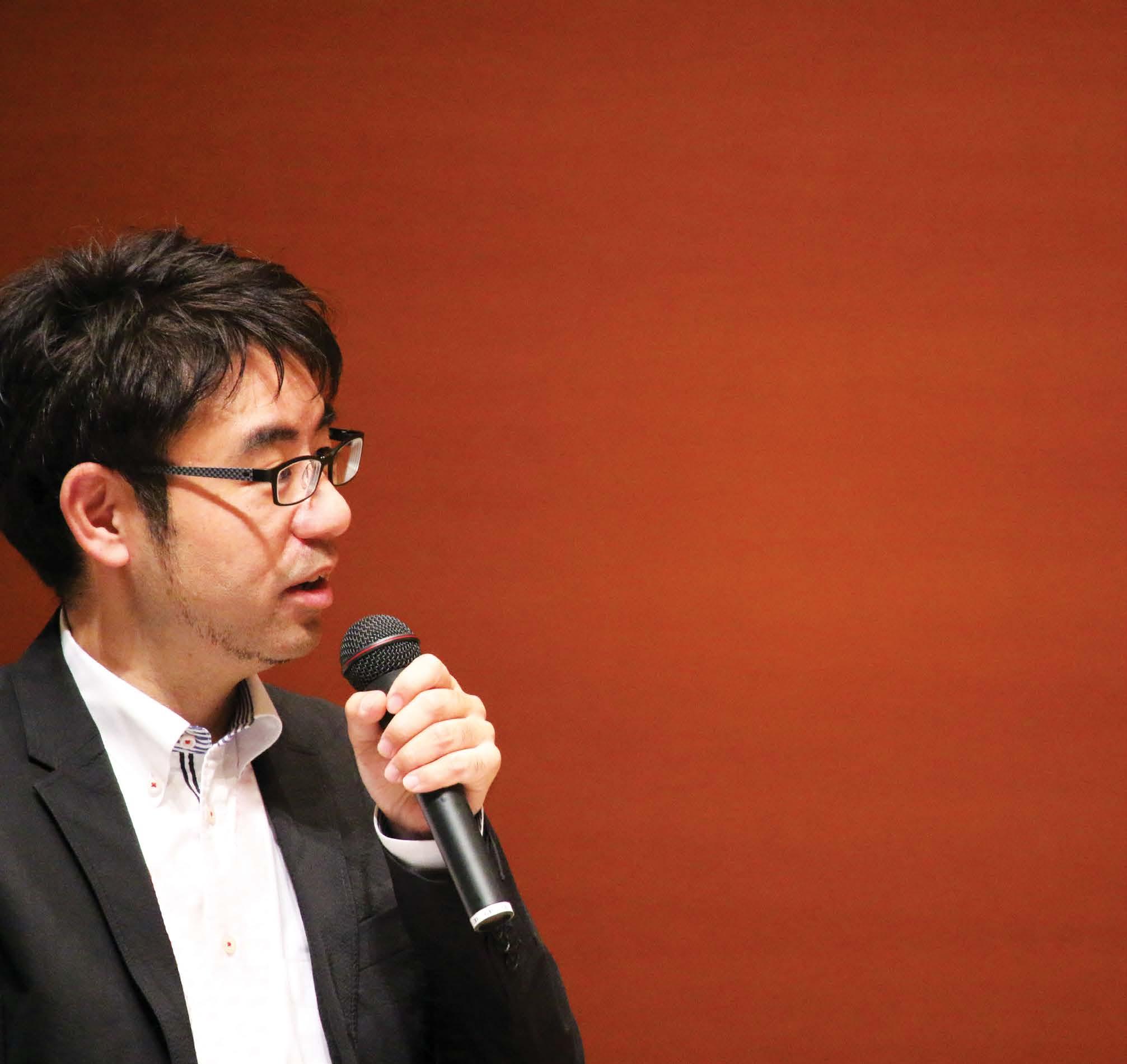
52
SOME PIECES FOR CHOIR
BY TAKATOMI NOBUNAGA
Endlessly Flowing (Chapter 1, “From the Ruins” for mixed chorus a cappella)
Performance video:
https://youtu.be/zF7DUPSiJ38
Score info:
https://www.panamusica.co.jp/en/ product/11744/

Shunshu-Sanshu (Three Poems of Spring Sorrow) for mixed chorus a cappella
Performance video, 1st piece: https://youtu.be/HUGDDYI5Qio
Performance video, 2nd piece: https://youtu.be/HgJeS-G_Ccg
Performance video, 3rd piece:
https://youtu.be/j_dUKmNe4JE
Score info:
https://www.panamusica.co.jp/en/ product/18258/


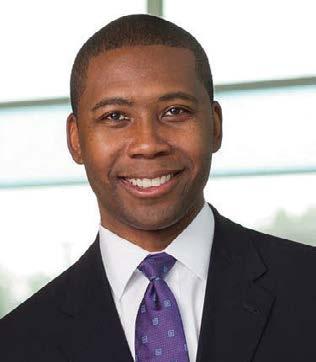
Kan Kan Kakurembo (Nursery Rhymes of Wakayama) for children’s or female chorus without accompaniment
Performance video:
https://youtu.be/6FjtoDz70Tk
Score info:
https://www.panamusica.co.jp/en/product/8392/




Hab’ ein Lied auf den Lippen
Performance video (Orchestra version): https://youtu.be/XBzC3c65XuI
Performance video (Piano version): https://youtu.be/gFMJv_9CD48
Score info:
https://www.panamusica.co.jp/en/ product/11759/

Gloria on the Horizon over the Sea (from “Two Glorias in Resonance” for mixed chorus and piano)



Performance video: https://youtu.be/suZ8q1MTGv4
Score info:
https://www.panamusica.co.jp/en/ product/26989/
Pana Musica, Japanese distributor of choral sheet music, has created a list of Mr Nobunaga’s published choral works: https://www.panamusica.co.jp/en/appeal/ takatomi_nobunaga/

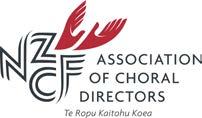

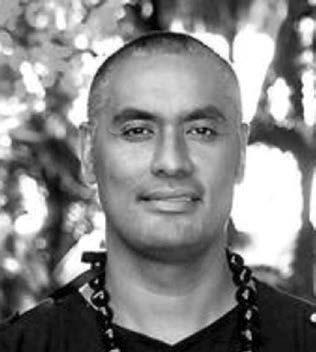
King’s College · Auckland, New Zealand 27-29 September 2023



Then
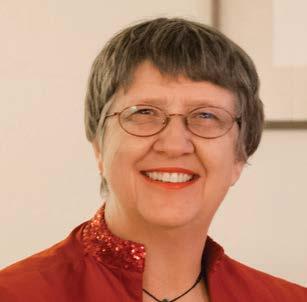
53
’23 Aotearoa 2023
stay on for singing and workshops at New Zealand’s premier choral festival:
Dr Karen Grylls NZ Dr Rollo Dilworth USA Elise Bradley NZ
with colleagues in New Zealand for three inspiring days of practical training for conductors: Due Drop Events Centre Auckland, New Zealand 29 September - 1 October 2023 choralconnect@nzcf.org.nz www.nzcf.org.nz events@nzcf.org.nz
Dr Igelese Ete NZ/Samoa Jono Palmer NZ Tim Wayne-Wright NZ/UK
Join
CHORAL TECHNIQUE
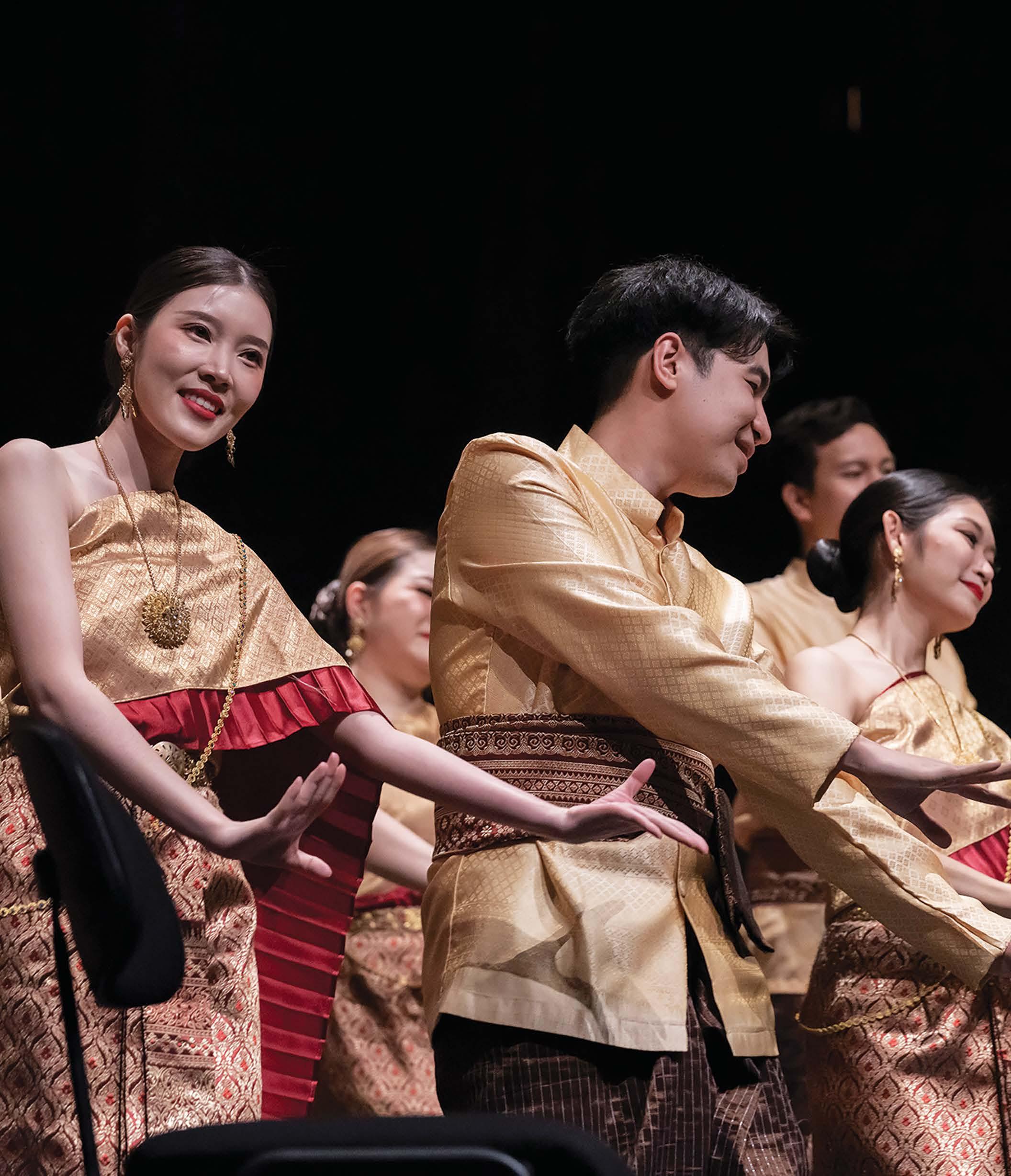
FROM THE THREE DIFFERENT MAJOR SECONDS TO THE HAND-SIGNS
FOCUS ON PURE INTONATION Ildikó Ferencziné Ács
54
CHORAL TECHNIQUE
Suanplu Chorus, dir. Ramon Molina Lijauco Jr. (Thailand), one of the participating choirs in the WSCM 2023 Extended Program © Gülcan Acar
FROM THE THREE DIFFERENT MAJOR SECONDS TO THE HAND-SIGNS FOCUS ON PURE INTONATION
ILDIKÓ FERENCZINÉ ÁCS, HUNGARY
As a result of technological progress, MIDI recordings and digital choral parts are available to choir leaders to facilitate the rehearsal and learning process. However, what on the one hand seems modern and innovative (digital pianos, audio and video recordings, streaming, virtual choirs) can have a negative impact on the other. The following chapters will point out why reading music with a relative system of solfa is beneficial, and why learning to sing a part or a choral work with the help of piano is less supported.
THE ROLE OF THE PIANO IN THE LEARNING PROCESS
The piano or the digital or virtual keyboard instruments are basically tempered.1 This means a sort of equal temperament, where the 12 semitones of the octave are exactly at the same distance from each other. Alexander John Ellis, a 19th-century English mathematician and linguist, developed a new system and unit of measurement for comparing the different temperaments and the pitches they could produce. Using the cent system, he transformed the 2:1 ratio of the octave into a linear
1 Andreas Werkmeister, a 17th-century organist, composer and theorist, who developed the technique of temperament, divided the pure octave into 12 equally spaced parts.
scale of 1200 degrees, where intervals can be described by arithmetical differences. The semitone as the smallest pitch interval was defined as = 100 cents (the cent is the hundredth of a tempered semitone), while whole tones correspond to 200 cents. In fully equal tuning, all keys are of equal value (Ferencziné, 2015).
Related to the question of how to achieve pure singing and to the use of instruments it needs to be observed that “it is well known that any kind of temperament […] is alien to the pure intonation of the choir.” One can use a piano to play a starting and a control note, as a kind of reference point, i.e., only playing notes that are the same (perhaps in the same octave). “The part sung by the choir should never be struck on the piano. [...] The instrument is only for the purpose of constantly relating the sound to its starting point” (Kardos, 1969: 29). The human singing voice is interpreted only in an acoustic context.
PROPERTIES OF THE ACOUSTIC OVERTONE SERIES

The human voice, the singing voice as a sound source, can be interpreted as an acoustic signal. When, for example, a string or a vocal cord vibrates, not only the fundamental is heard, but also its frequencies multiplied by whole numbers: its harmonic overtones. The frequency relationships are represented by the successive notes of the overtone series:

55
Figure 2. Overtones (Source: https://www.soundsnap.com/blog/glossary/overtone/)
Artikel auf Deutsch Article en français Artículo en español
The following figure shows a series of overtones projected onto the great C/C2 (overtones 7 and 11 are deeper than the notes used in the diatonic framework), with the frequency values and ratios associated with the notes below. Colours are used to denote octaves built upon each other.

On the basis of Figure 3, examining the thirds in the overtone series and the role and behaviour of the notes in the diatonic scale, we can depict the structure of the major triads as follows:
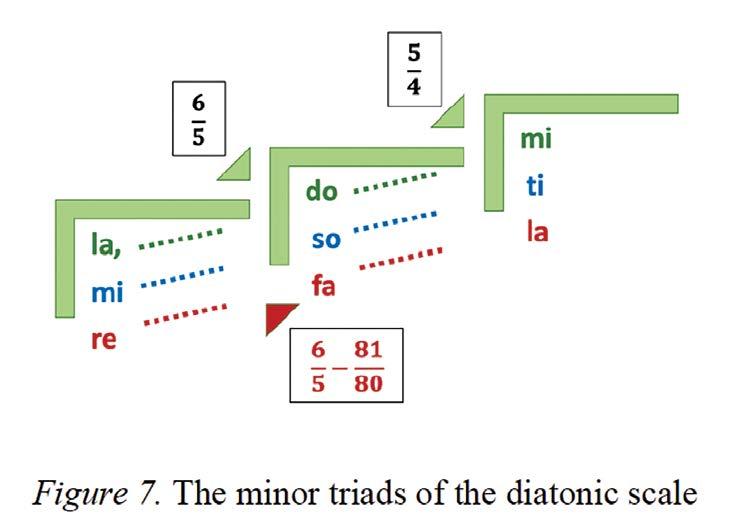

In the score of the overtone series, major seconds can be seen between overtones 8 and 10. Playing these on the piano means two whole tones of the same size. However, it is clear from the proportions below the intervals that the first interval, 9/8, is wider than the second one, which is 10/9. To distinguish between the two types of major second, we use the terms 9/8 “large whole step” and 10/9 “small whole step.” The frequency ratio of the two whole notes is 81/80, corresponding to ≈ 22 cents. Comparing the three types of whole tones (major second), the differences in size become apparent.
All the chords have a pure major third and minor third structure. It is no coincidence that these have become the most stable and strongest triads of the major key, the major triads, the carriers of the main functions.

All but one of the minor chords of the diatonic system also sound clear. Only in the minor triad with a re root is the semitone forming the minor third paired with the 10/9 small whole step, i.e., the minor third is narrower in this case by a ratio of 81/80
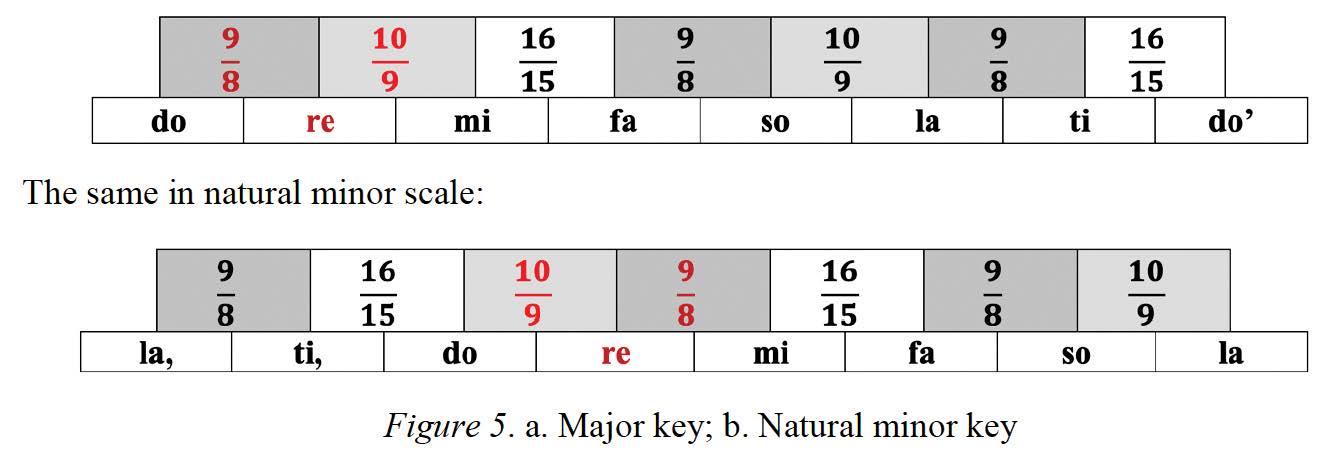
The difference between large and small whole steps arising from the difference in acoustic frames is also clearly visible. In the major key, the seconds follow each other in the following order:
It is therefore clear that the re note is in a sensitive place, depending on its position and tonal location. The position of a note in a given tonality, its role, the stability of the pure intonation of different intervals and harmonies, can be developed through practice. A learning process is effective if “constant” elements occur frequently among the ones to be learned. The more variables there are, the more unstable the memorisation of the
56
CHORAL TECHNIQUE
turn to be learnt becomes, and the longer the process of deepening takes. Of the two types of solfa systems, absolute and relative ones (also known as “fixed do” and “movable do”), only one is capable of satisfying the above learning process, and that is the relative system.
THE ROLE OF RELATIVE SOLFA IN THE DEVELOPMENT OF CLEAR INTONATION
The learning of tonal music pieces and the clear intonation of melodies and harmonies are ensured by relative solfa. The name of a melody’s notes, the distance between two notes with the same name, and their role in the tonality are constant. For example, in a major key, a so-re-mi turn always has a descending perfect fourth and an ascending major second, whatever the key we are in. With absolute solmization, however, the width of the intervals can vary, even with the same name.

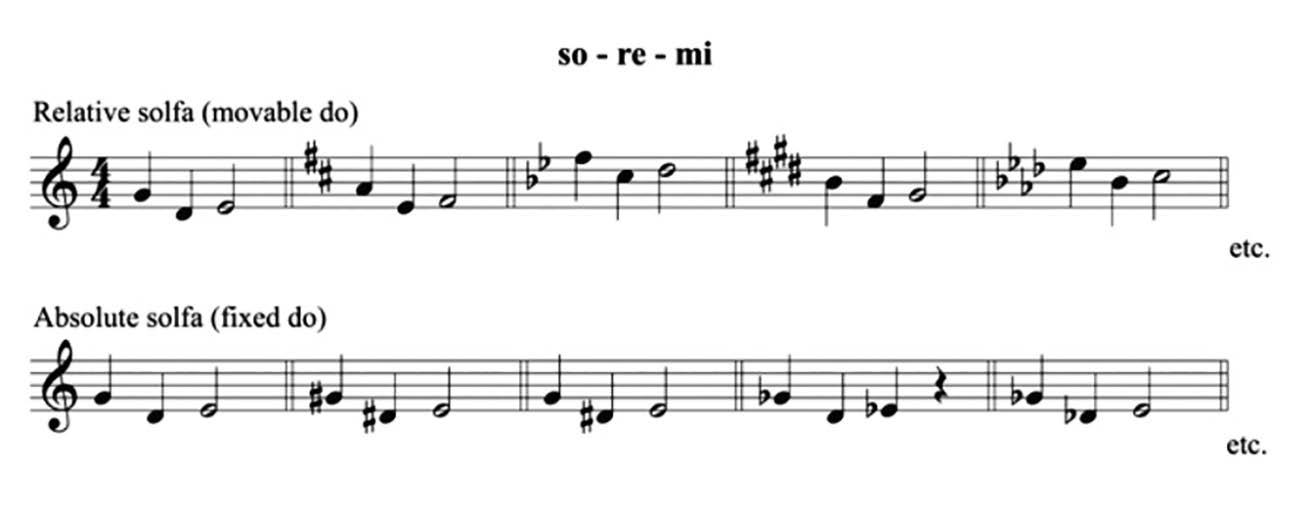
In a tonal musical context, the most suitable method for achieving and practising pure intonation is therefore the use of relative solfa. Automatic use requires a lot of practice, and one of the tools of this is the use of hand signs. Due to their spatial positioning, they offer an excellent opportunity to specify pitches in the right direction and to show the sensitivity of the notes.

57
Figure 8. Relative solfa – absolute solfa
Figure 9. Hand-signs
MONOPHONIC EXAMPLES
Pure singing can only be achieved through the interaction of monophony and simultaneous voicing, the foundations of which must be laid in monophony. When pointing out the difference in width between the large whole step and small whole step, let us make others aware that in both major keys and natural minor keys, whole steps occur between the following degrees of the scale:
1-2.

4-5.
6-7.
From an intonation point of view, therefore, particular attention should be paid to intoning and sustaining the 2nd, 5th and 7th degrees high (Kardos, 2007):
do-fa-so; so,-do-re; mi-la-ti; la,-re-mi where the ascending second in a fifth ambitus should be intoned high, or the small whole step turns:
do’-la-so; la-so-mi; re-do-la,; so-mi-re in which the descending seconds should be intoned high in a fourth ambitus.
Particular attention should be paid to the intonation of the two kinds of re This can be practiced in a tune example as shown in the following chart:
Although we have used the term “low re” in the minor key, in practice we feel that the do and the mi are higher, more tense, and the re is deeper in comparison.
The two kinds of seconds can be illustrated by different colours in the following sheet music example:
Figure 10. Alleluia (Source: https://gregobase.selapa.net/chant.php?id=1341)


POLYPHONIC EXAMPLES
In his booklet Let us Sing Correctly (1941), Zoltán Kodály proceeds in the order of the acoustic overtone sequence, voicing the octave and fifth
58 CHORAL TECHNIQUE
intervals, and then in fourths to the sounding of the thirds.
11. Overtones
However, this sound order cannot be generalised to all choir types and age groups. The perfect fifth and the perfect octave can indeed be defined as the starting point for teaching pure intonation in male choirs, but for female and children’s choirs, due to the relative scarcity of overtones resulting from the higher pitch of the fundamental, it is not advisable to start from these intervals. In the case of female and children’s choirs, the two kinds of thirds are the most suitable intervals for the beginning, especially the so-mi and then the mi-do relation (Kardos, 1969). It is therefore no coincidence that the introduction of the tonic major and, almost in parallel, the minor triad is practised first, especially for mixed choirs. After practising the intervals that make up the triad, it is recommended to intone the perfect fourth below the root (lower so). This is followed by conscious practice of the seconds.

Examples:
12. Major triads
The example above shows one possible way of combining the three major triads illustrated above in three parts. After the root note is voiced as a solid, firm base, the soft fifth should be played, followed by an even more mellow third. The voice leading is then carried on in second steps, where attention must be paid to the high intonation of the notes la and re
So-related high re:
An example shown using hand signs (according to position in the chorus: soprano on the left, alto on the right):

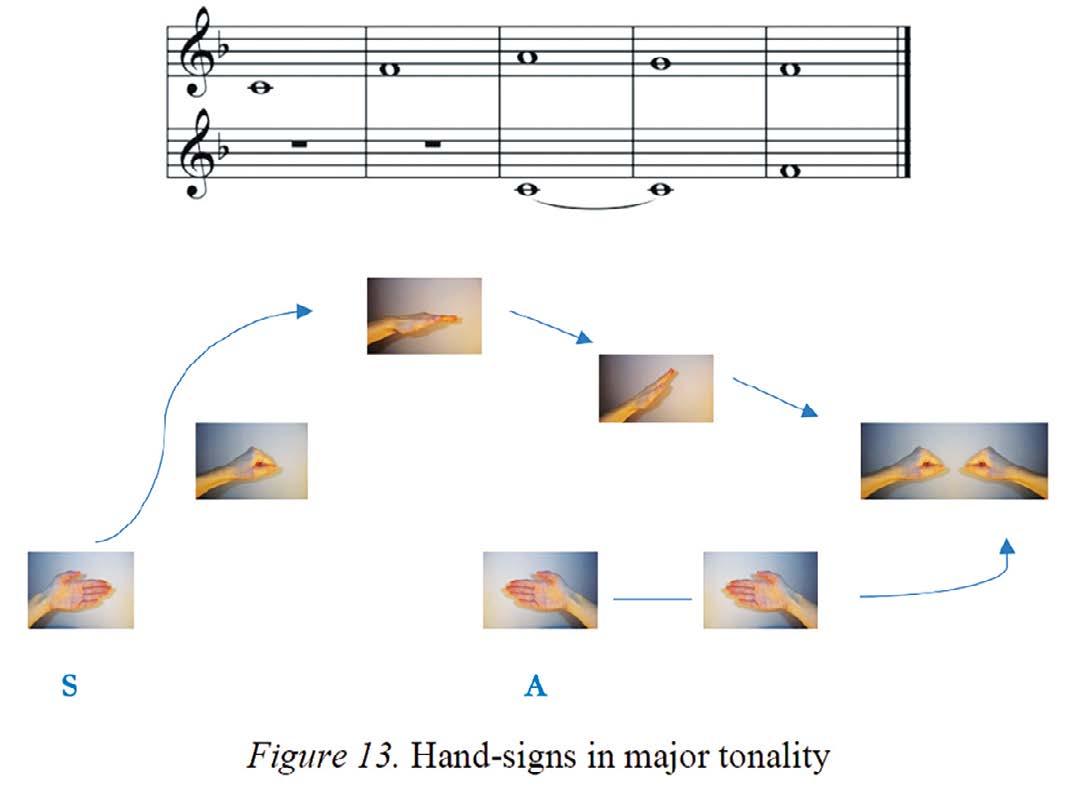

59
Figure
Figure
Schubert’s Mailied clearly shows the behaviour of the re in major: above the lower so, the re is to be intoned high:
La-related deep re:
An excellent way to practice is when the other part is matched to a sustained note. This offers a chance to relate intervals to a constantly fixed point. The exercise below demonstrates this in minor tonality, using hand signs:



In the case of a low re with a relation to la, the most important thing to pay attention to is the pitch of the following tone. E.g., la,-mi-re-do or la,-do-remi. That is, in the first example it is important to achieve a narrower second, in the second one, to achieve a wider second.
The role of the re in the tonality and the proximity of the notes la or so and the effect of these latter sounds often render it difficult to make a theoretical decision. The frequent changes are influenced by the musical context, the leading of the part and harmonic thinking together.
SUMMARY
For clear singing, it is best if the melodic elements can always be voiced

60 CHORAL TECHNIQUE
Figure 14. Schubert: Mailied (Source: https://imslp.org/wiki/Mailied,_D.199_(Schubert,_ Franz))
Figure 15. Hand-signs in minor tonality
Figure 16. Lassus: Ipsa te cogat - excerpt
with the same names and syllables, regardless of the key, according to their role in the tonality. The same distance, step or jump can only be given the same name in the relative solfa system. Within the framework of a given tonality, the intonation of the intervals becomes stable and well controllable (Ferencziné, 2015).
WORKS CITED
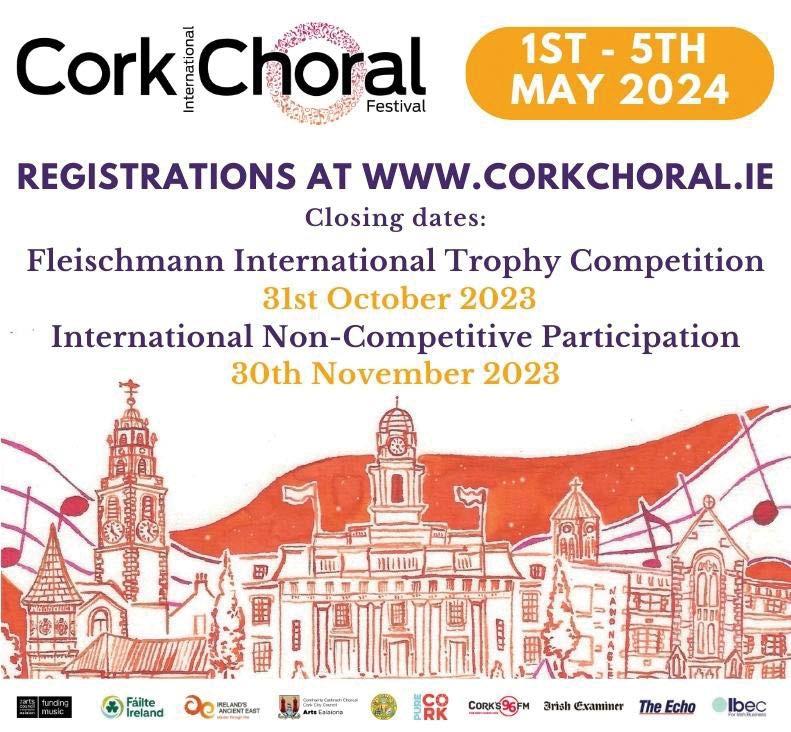
• Kardos Pál (1969): Kórusnevelés, kórushangzás. Zeneműkiadó. Budapest.
• Kardos Pál (2007): Egyszólamúság az énekkari nevelésben. Kardos Pál Alapítvány, Szeged.
• Kodály Zoltán (1941): Énekeljünk tisztán. Magyar Kórus Művek. Budapest.
• Ferencziné Ács Ildikó (2015): Intonáció – szolmizáció. In.: Ferencziné Ács Ildikó – Pintér-Keresztes Ildikó: Pótvonalak. SZAKTÁRNET. Nyíregyházi
Főiskola. pp. 37-47.
• Fiala Péter (2015): A hangszerek fizikája. Jegyzet. BME, Budapest.
 Edited by Taylor Ffitch, USA
Edited by Taylor Ffitch, USA
ILDIKÓ FERENCZINÉ ÁCS, DLA, dr. habil. (b. 1966) is professor and head of the Institute of Music at the University of Nyíregyháza. She obtained degrees as Classroom Music Teacher, Teacher of Music Theory, Choir Conductor, and Teacher of Classical Singing. She studied Choir Conducting and received her DLA degree and received her training at the Franz Liszt Academy of Music in Budapest. She graduated as a singer from the Debrecen Conservatory of Franz Liszt Academy of Music. She has been teaching at the University of Nyíregyháza since 1989. She was the conductor of Gaudemus Choir of the University from 1993 until 2010. She worked as vice-dean of the Faculty of Humanities and Arts from September 2007, and as dean between May 2008 and September 2013. She carried out the functions of the vice-rector for education at the University of Nyíregyháza between January 2017 and June 2019.
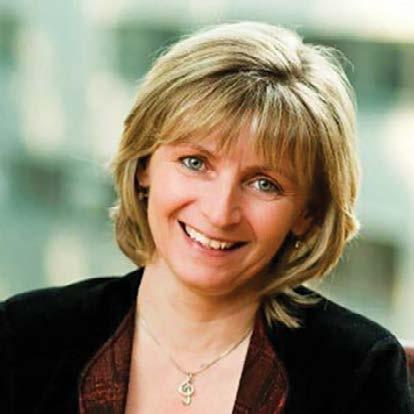
61
SCORE REVIEW

MARTÍN PALMERI: NISI DOMINUS (PSALM 127)
Reviewed by Reijo Kekkonen
62
REVIEWS
Avip
(Indonesia) at the WSCM
Batavia Madrigal Singers, dir.
Priatna
2023, Istanbul, Türkiye © Gülcan Acar
MARTÍN PALMERI: NISI DOMINUS (PSALM 127)
 REIJO KEKKONEN Singer and publisher, Helsinki, Finland
REIJO KEKKONEN Singer and publisher, Helsinki, Finland
ARGENTINA AND URUGUAY ARE RENOWNED AS THE HOMELANDS OF TANGO. PEOPLE IN MANY COUNTRIES AROUND THE WORLD DANCE TANGO, BUT WHILE THE TEMPO AND THE INTERPRETATION MAY VARY, THE LOVE AND PASSION IN THE MUSIC ARE COMMON TO ALL. FOR INSTANCE, IN FINLAND THERE IS AN ANNUAL TANGO FESTIVAL WITH A SINGING COMPETITION TO ELECT THE TANGO-QUEEN AND TANGO-KING OF THE YEAR.
Argentinian composer Martín Palmeri made his breakthrough with his Misa a Buenos Aires (1996), which is also known as Misatango. His Misa a Buenos Aires created a whole new genre: nueva tango. It combines the Roman Catholic Mass with tango music. His newest work in the same style was commissioned by the German music publisher Carus-Verlag for their 50th anniversary in 2022. It is written to the text of Psalm 127, Nisi Dominus. It was premiered in June 2022 in Nürnberg at the Musikfest ION by Vokalensemble St. Lorenz and ensemble KONTRASTE with Matthias Ank conducting.
The Nisi Dominus, like its predecessors, is written for a choir and a typical tango orchestra. In this work, as in Misatango, there is also a soprano soloist. For a performance, it is important to know that the special tango effects are performed by the orchestra, and as the composer himself says, the choir should not make any extra efforts to “sound like tango”. These effects, played especially with piano, bandoneon and double bass, include the so-called arrastres (drags), syncopations, marcati etc. The orchestral parts also include a part for accordion, which may replace bandoneon if needed. However, bandoneon as a “tango instrument” is so emblematic that one could say it is not replaceable. As for the string parts, the composer writes that it is also possible to use a string quintet, in which case the upper parts of the divisi should be prioritised.
The tempo markings are also interesting. The composer has written metronome markings in the score, but according to him they are the maximum: the tempi may be slower, but they should never be faster. That really is an important thing to know as in many countries tango is performed in quite rapid tempo. In slower tempo you have more space for the passion and love.
The score is published by its commissioner, Carus-Verlag. The cover is bright yellow with colourful letters, which somehow reminds me of La Boca in Buenos Aires. The text of the work is in Latin, and it runs to about 18 minutes. As for its level of difficulty, the publisher classifies Nisi Dominus as a 3 on its scale of 1-5, so it is easily approachable for many choirs. The composition is in three movements, performed attacca. The chorus feels the benefit of classical composing techniques familiar to choirs, who are
especially accustomed to singing church music of the romantic era. The role of the orchestra is, as mentioned above, to take care of the tango.
The ambitus of the choir parts is from G of the basses to G2 of the sopranos. The soprano solo goes up to A2. The texture stays mainly on the stave for each part. The intervals are not complicated: there
63
Artikel auf Deutsch Article en français Artículo en español
are a few tritones, but if you have sung Bach they are not too difficult to learn. The bass part is presumably written for baritone voices. I feel the absence of any real bass effects, which might have gone well with, for example, the piano and double bass parts, or an a cappella passage with sensitive “tango feeling”.

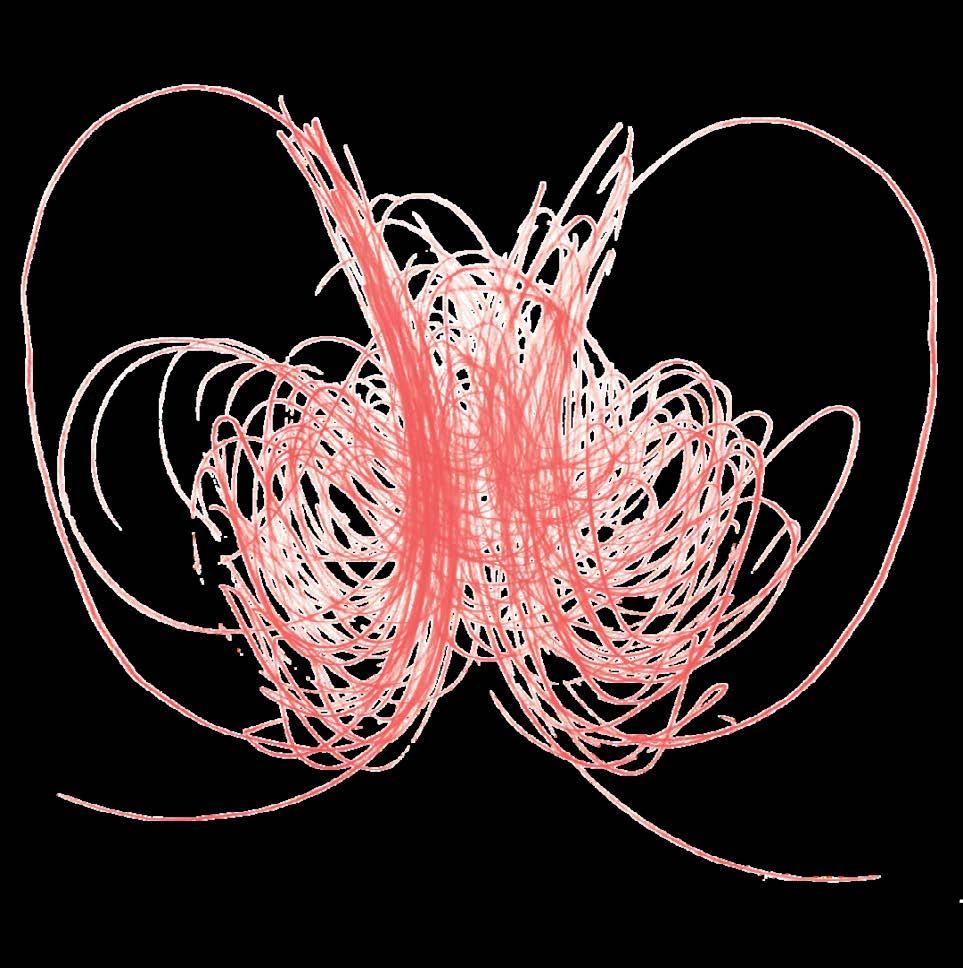

The balancing of the choir with the orchestra works fine. Of course, if you are performing the work with only a string quintet and not with a string orchestra, you may have to work harder to achieve balance and bring out the sensitivity of the singers. Principally the scoring is professional and not only colla parte.

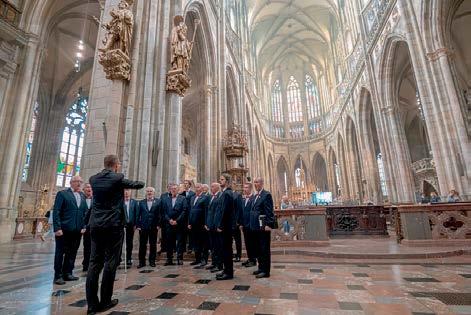
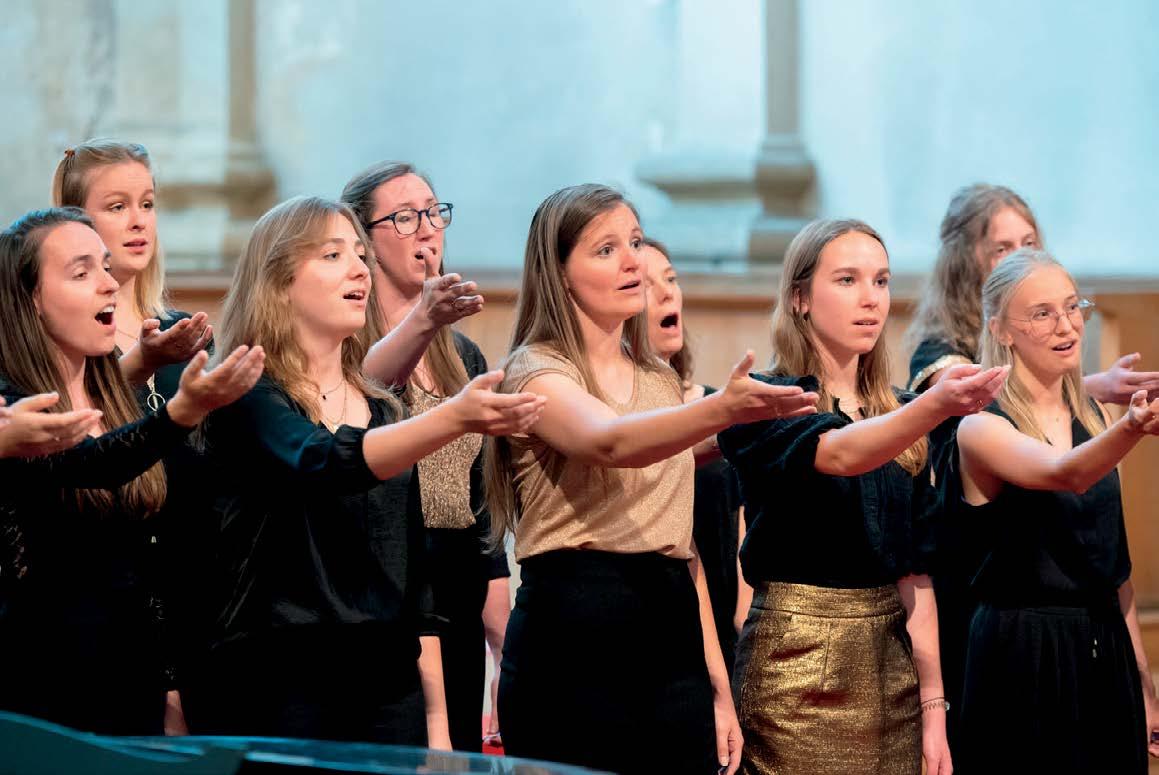
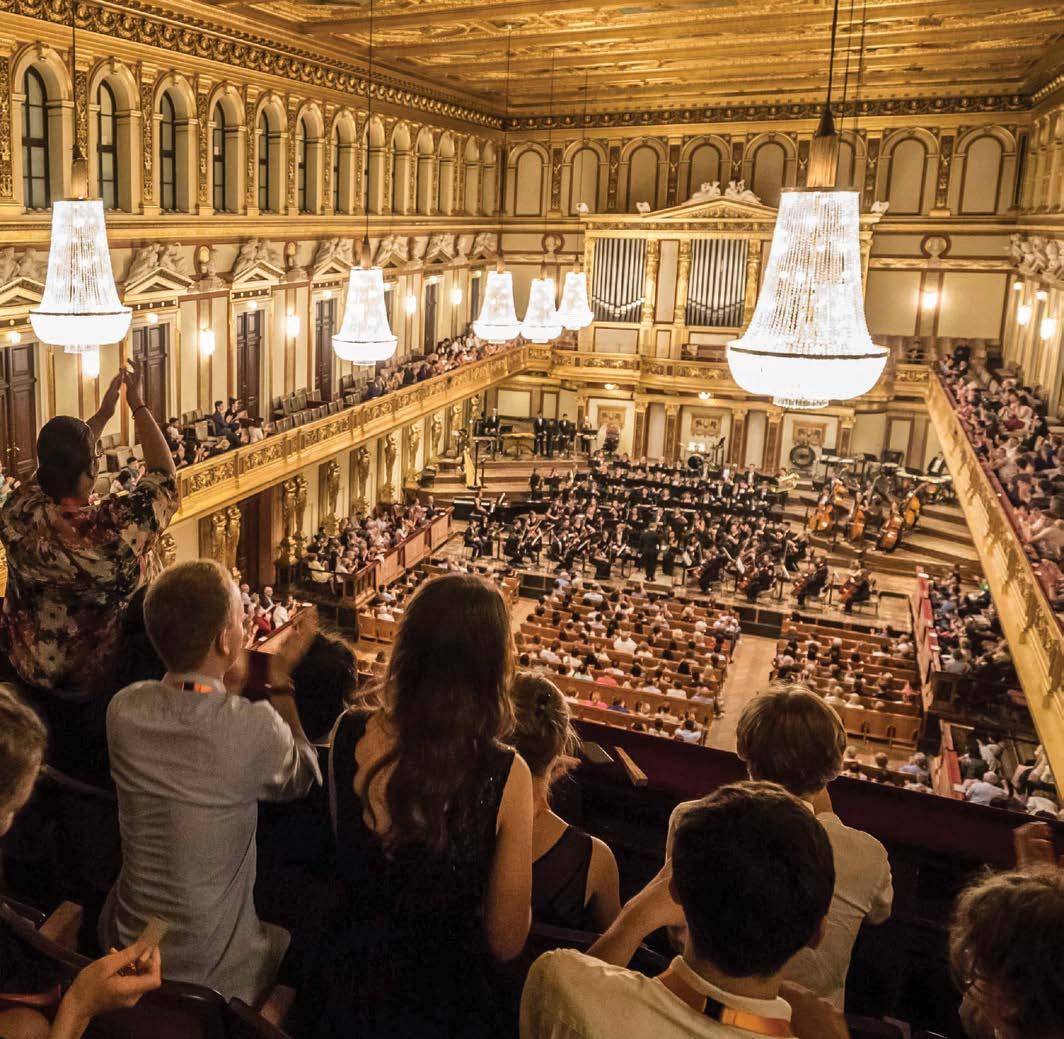
The full score and vocal score are available for sale at Carus-Verlag and well-equipped music stores. The orchestral materials are available from the publisher for hire only.


 Edited by Karen Bradberry, Australia
Edited by Karen Bradberry, Australia
REIJO KEKKONEN (*1961) has been working as a director of publishing at Sulasol music publishers since 1988. He graduated from the Sibelius Academy in 1991 with a Master of Music (music education, violin, singing, piano, oboe), with special studies in composition (Vladimir Agopov, Tapani Länsiö) and studies in choral conducting (Matti Hyökki, Erkki Pullinen). He has played with various orchestras and bands and has also worked as a professional singer (2nd bass) in, for example, the Finnish Radio Chamber Choir, Sibelius Academy Vocal Ensemble and Cetus Noster. Kekkonen has adjudicated choral competitions, composition competitions and arrangement competitions worldwide. He has held several positions of trust, both in Finland and elsewhere, at organisations, festivals and competitions. reijo.kekkonen@sulasol.fi


64
+420 721 644 472 info@musicaorbis com www musicaorbisfestivals com MUSICA ORBIS PRAGUE FESTIVAL 29 JUNE - 3 JULY 2023
COMPETITION 29 JUNE - 3 JULY 2023 th rd for non-professional choirs Competitive and non-competitive categories Feedback from renowned jury CONCERTS Opening concert Festival concerts
ACTIVITIES Workshops Mass participation in St Vitus's Cathedral Dinner Cruise Sightseeing activities and much more... rd th 27 JUNE - 1 JULY 2024 th st GLORIA 3 - 5 NOVEMBER 2023 rd th
MUSICA ORBIS PRAGUE FESTIVAL
OTHER
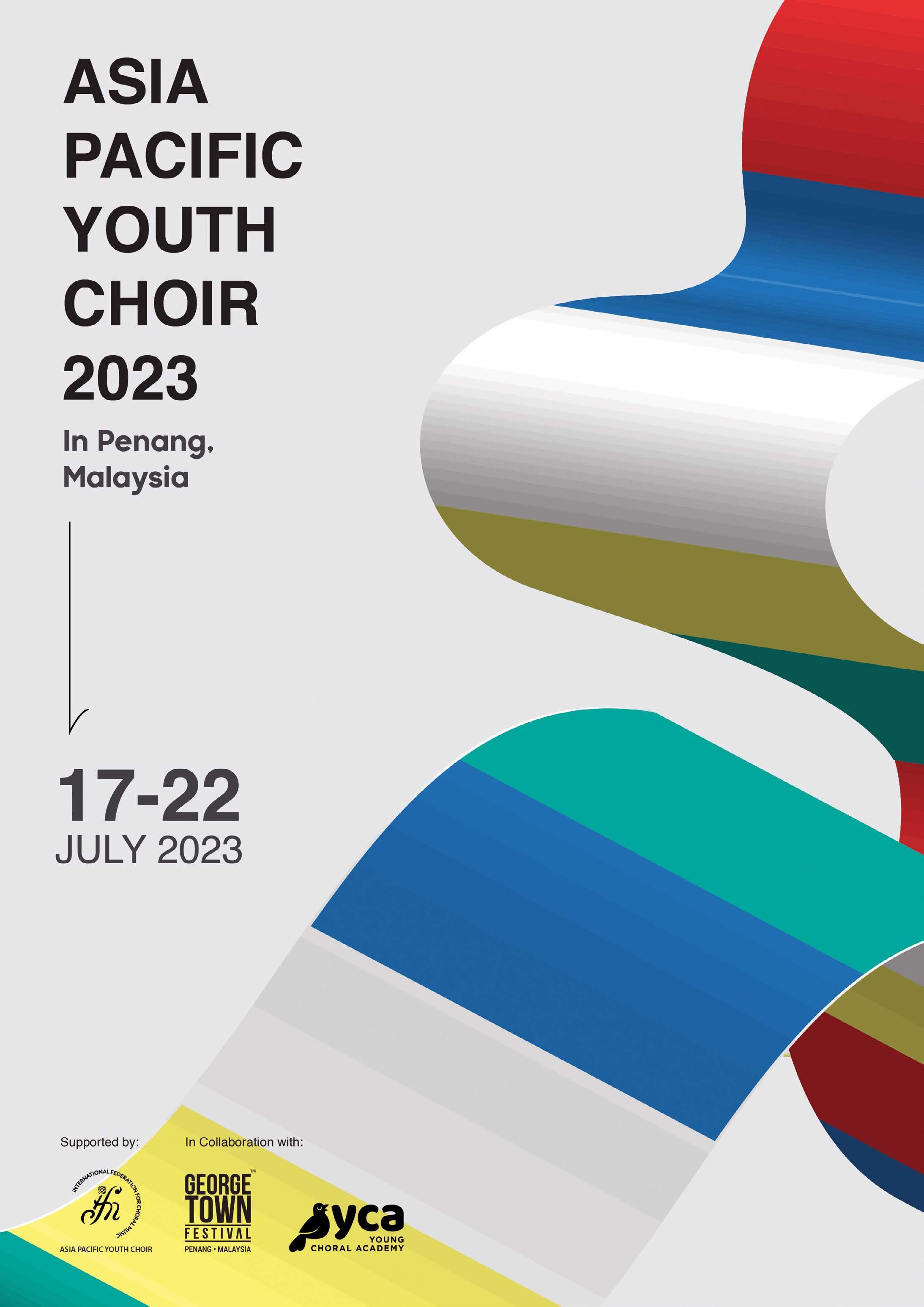
65
REPERTOIRE
CHORAL TREATMENT: 7 CHORAL WORKS FROM CORDILLERA, PHILIPPINES TO INCLUDE IN YOUR NEXT PROGRAMME

66
REPERTOIRE
Leioa Kantika Korala, dir. Basilio Astúlez (Basque Country, Spain), at the WSCM 2023, Istanbul, Türkiye © Gülcan Acar
Arjay Viray
CHORAL TREATMENT:
7 choral works from Cordillera, Philippines to include in your next programme
ARJAY VIRAY Choral conductor and researcher, the Philippines
The intricate play of rhythm, the fast-slow-fast structure, the use of open fifths to reimagine the organic space, the quartal harmonies and occasional dissonances to reproduce the overtones, the tonal and timbral emulating of elderly chanters, the textual permutations that contribute to the percussive properties of the arrangements, as well as the improvised inclusion of an ethnic drum, various bamboo instruments, and even body percussions – these are just some of the appealing qualities that make arrangements and even compositions based on Cordilleran materials very interesting. Here’s hoping that the next time you prepare a world music segment for one of your concerts, these are some pieces from the Cordillera region worth including in your programme.
7. Dumbele – Originally written for female voices by the late Rodolfo Delarmente, he eventually transcribed it into SATB and has since became a staple piece among Filipino choirs. It was based on an Itneg/Tinguian rain chant as documented in fieldwork by Ramon Obusan (National Artist for Dance) to accompany his suite of animist and pagan ritualistic dances. Delarmente’s rich visualisation through polychoral layering and exceptional command of contrapuntal and countermelodic writing became his trademark style, as evidenced by his other works such as Ilay Gandangan (Worship of the Sun) from the southern Philippines and his Ama Namin (Our Father). The text of the entire piece is based on two very simple and short phrases: Dumbele sekatemaya, Dumbele malateka – making it text-friendly even for non-speakers of the language. Dumbele was published by Carus Verlag.
6. Salidummay – There are several existing choral versions of this famous Cordilleran phrase and tune. Although there are similarities like the presence of rhythm and syncopation, each version offers a distinct flavour. One factor is that the Salidummay’s melody, tempo, and even texts vary depending on the context in which it is sung. In addition, each of the six provinces of the Cordillera region have their own variants of the Salidummay. A relatively recent version by Normita “Bing” Pablico featured a male soloist to start the piece
and generally chose a more prayerful mood (for the solo and the solemn legato parts in the middle), with the more festive and rhythmic parts depicting their ritual of thanksgiving. Bienvenido Constantino’s arrangement, on the other hand, uses a simpler motif but pushes the limits of range and even includes changing meters through constant motific augmentation and diminution as each segment progresses.
Vocal jazz pioneer Moy Ortiz’s arrangement in the mid90s explored complementary rhythms between simpletriple and compound-duple meter, long before modern composers utilised them in choral writing. The score was unpublished but was recorded by the Ateneo Glee Club under Dr. Joel Navarro as part of their 1995 album aptly titled ‘Lahi: The Filipino Sings from the Heart’.

67
Professor Andrea Veneracion (Philippine Madrigal Singers)
Artikel auf Deutsch Article en français Artículo en español
An earlier arrangement of the Salidummay was written by Reynaldo Paguio of the University of the Philippines Concert Chorus. Paguio’s version was actually based on a recording from ethnomusicological fieldwork in the Cordilleras. The field recordings featured a Tongali (bamboo nose flute) that was played by a virtuoso master flautist. Paguio opted to use a western flute to replicate the articulation. This was part of the Mga Awiting Bayan collection of folk songs published by the Philippine Madrigal Singers and edited by Professor Andrea Veneracion (National Artist for Music).
5. Orde-e – Originating from the Madukayan tribe of Mountain Province, this Lester Delgado arrangement was one of the winning pieces included in Mga Awiting Bayan para sa Korong Pilipino published by the National Commission for Culture and the Arts. Another musical painting of the Cordilleran landscape, Delgado’s Orde-e features a male and female soloist. Generally tranquil in character, with punctuations of rhythmic activity in the development section before returning home to a state of calmness. Maria Theresa Vizconde-Roldan wrote an accompanied SSAA version of Orde-e which was published by Hal Leonard.
4. Iddemdem Malida – For quite some time, this was classified as an Itneg/Tinguian war song from the province of Abra. However, it was later suggested that it might not really be a song of war, but of victory. This small detail carries very important information affecting both how the song should be sung and how its choral arrangements should be interpreted – festive and celebratory, but not necessarily aggressive. There have been different choral arrangements of this tune; the earliest version was by the late Elmo Makil, arranged for SATB and published by Alfred Music. Still based on Makil’s chant was a more recent arrangement by Jonaf Del Fierro, this time for TTBB and published by Pavane Publishing. A slightly modernist upgrade, Del Fierro’s work also clearly defined the segments, creating a more cohesive structural narrative.
Ryan Cayabyab (National Artist for Music) wrote a larger concert arrangement of this same folk tune which featured a trio of soloists, a double choir, a rhythm section, and various Philippine indigenous instruments.
3. Chua-Ay – Traditionally, this Igorot folk tune from Benguet is sung while pounding rice grains using a huge mortar after the grains have been shredded from their stems. It is already quite obvious that the pounding makes for natural percussive rhythms that are easy to sing along to. A closer examination presents the opposite – it is the rhythm and the singing that makes the pounding easier and faster.
The earliest choral version known to Philippine choirs was that of Fabian Obispo. Years later, Prof. Fidel Calalang
included Chua-ay as part of his choral suite Ayug ti Amianan (Scenes from the North). Although the sections are entirely independent of one another, Calalang’s arrangement provided the complete picturesque narrative. Nevertheless, both versions embodied the rhythmic and percussive properties of the song’s original function.
Obispo’s work was published by Carus Verlag, included in the Philippine Madrigal Singers’ Mga Awiting Bayan and has an unpublished TTBB version transcribed by Emmanuel Laureola. Calalang’s arrangement, on the other hand, was published by Earth Songs and has an SSAA version transcribed by Jude Roldan and published under Muziksea.
2. Vochong – Depicts the Cordilleran tradition of forging peace pacts between rival groups or clans. Vochong, Bochong, or Bodong literally translates to peace pact. This folk tune from Kalinga was arranged by Dyzon Pesquera for mixed voices, gongs, and bamboo instruments. Pesquera’s ability to use unexpected transitions is one of the many high spots of this arrangement. It is a masterclass in textural development achieved through fragmentations of the theme to smoothly shift from unison to canon, slowly building up to its high point characterised by a contrapuntal exchange among voice sections.
1. Gapas – Topping our list is Gapas (Harvest) – a composition by Eudenice Palaruan based on a biblical text about reaping a harvest in the vernacular language. Palaruan, whose roots are from Lamut, Ifugao is one of today’s leading composers, arrangers, and advocates for Philippine and Asian choral literature. Written for SSAATTBB with sub-divisions, Gapas is a vocally demanding work which requires a larger number of singers with highly advanced technical and musical skills. Part of the genius of this composition is Palaruan’s exploration of using an interesting motif (E – D# - A – G) horizontally (melodic) and vertically (harmonic) in moto perpetuo. The clusters emulate the partials (harmonic overtones) produced by Cordilleran gong playing while the hemitonic pentatone can actually be heard with Cordilleran melodic instruments such as the Tongali (nose flute), Paldong (lipvalley flute), or the Kolitong (bamboo zither). As someone who actually comes from the Cordillera region, Palaruan has written several choral works in which he used Ibaloi, Ifugao, and Kankana-ey text, contributing to his very own heritage, such as his composition Ehikier 37 (Ezekiel 37) and arrangements of the Tinguian Oggayam, and the Kankana-ey melody Pundayaw hi Apu Infaag.
For inquiries regarding the music listed above, you may contact the Philippine Choral Directors Association via www.mypcda.com
Edited by Lydia de Montfort, UK
68
REPERTOIRE
RENEW YOUR SUPPORT IN 2023
SPONSORS SPONSORS INDEX
The International Federation for Choral Music (IFCM) very much values the support and commitment of the membership to bring choral music of the world together. Join us again in 2023 for another outstanding year of great programs and choral music developement.


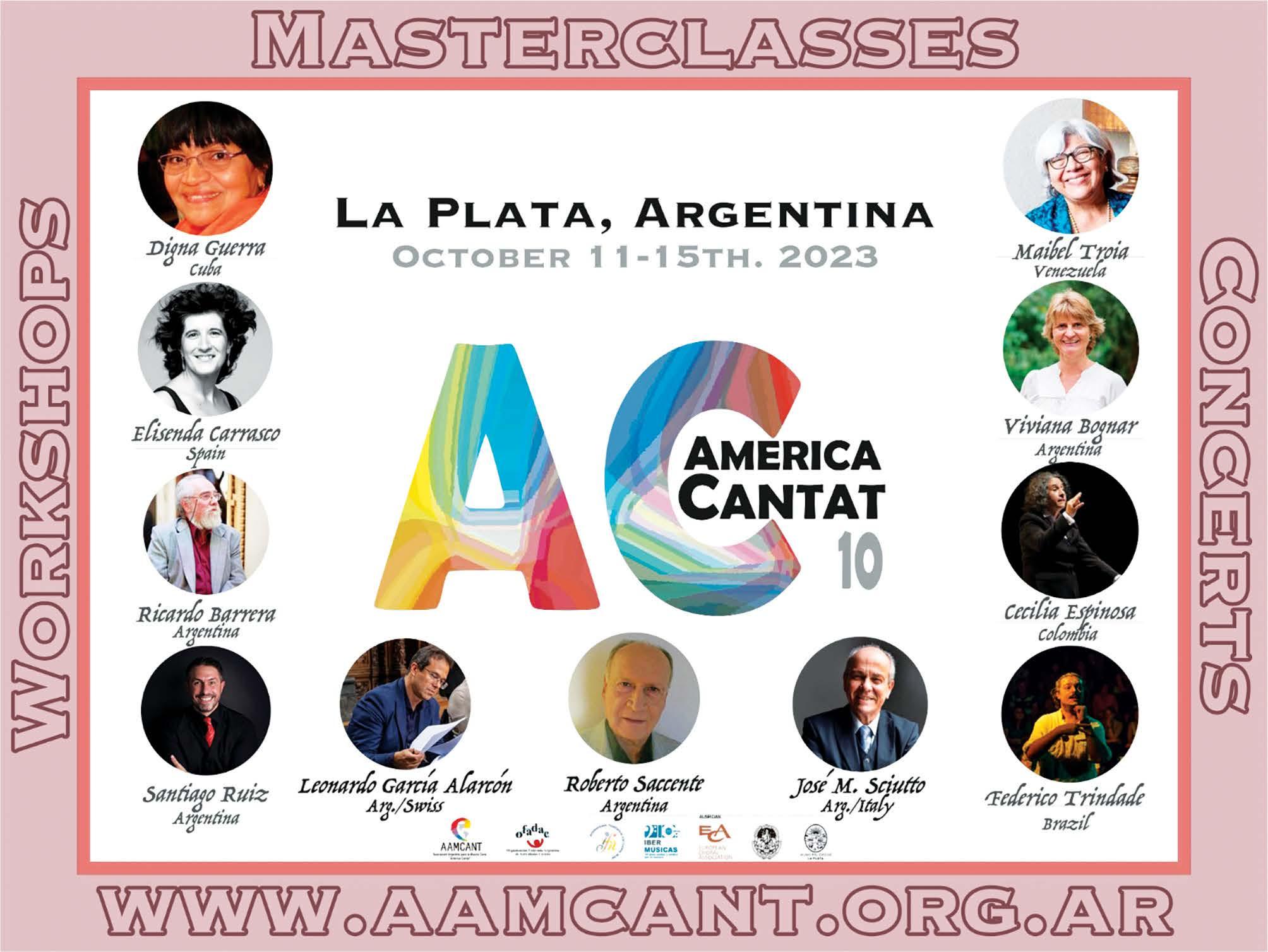

IFCM, a whole world of opportunities waiting for you!
https://www.ifcm.net/membership/membership-renewal

Next Event
10 December 2023
OUTSIDE BACK COVER European Choral Association
69
America
Asia
2023
Concerts-Austria/Columbus
MUSICFOLDER.com
Musica
23 u Africa Cantat 69 u
Cantat 65 u
Pacific Youth Choir
64 u
Reisen 61 u Cork International Choral Festival 49 u
64 u
Orbis Prague Festival 53 u New Zealand Choral Federation
email:
International Federation for Choral Music IFCM
Volunteers connecting our choral WORLD website: www.ifcm.net
office@ifcm.net
World Choral Day
CHORAL CALENDAR
FESTIVALS, COMPETITIONS, CONFERENCES, WORKSHOPS& MASTERCLASSES, AND MORE...
Compiled by Nadine Robin

70
CALENDAR
CHORAL
WSCM 2023
ready to welcome the
Volunteers
participants at the Atatürk Cultural Centre, Istanbul, Türkiye © WSCM 2023
CHORAL CALENDAR
Africa Cantat, Yaounde, Cameroon, 1-6 Aug 2023
Contact: , Email: info@africacantat.org - Website: https://www.africacantat.org/
Singing & Teaching Singing Summer Course, Dublin, Ireland, 10-14 Aug 2023. Contact: Irish Institute of Music and Song, Email: info@iims.ieWebsite: https://www.irishinstituteofmusic.com/
San Juan Canta International Festival, Argentina, 11-15 Aug 2023. Contact: María Elina Mayorga, Email: sanjuancoral@gmail.com - Website: http:// sanjuancanta.com.ar
European Academy for Choral Conductors, Fano, Italy, 27 Aug-3 Sep 2023. Contact: FENIARCO, Email: info@feniarco.it - Website: www.feniarco.it
Paris Music Festival 2023, France, 23-27 Aug 2023
Contact: MusikReisenFaszination Music Festivals, Email: info@mrf-musicfestivals.com - Website: www. mrf-musicfestivals.com
Josquin des Prez dans son époque, Gourdon en Quercy, France, 27 Aug-1 Sep 2023. Contact: Lacock Courses, Andrew van der Beek, Email: lucy@lacock. org - Website: www.lacock.org
Al Sole della Sardegna International Choral Festival, Sant’Antioco, Italy, 28 Aug-6 Sep 2023. Contact: Prof. Giuliano Rinaldi, Email: info@ festivalalsoledellasardegna.eu - Website: www. festivalalsoledellasardegna.eu
Together We Sing International Choir and Music Festival, Loutraki Corinth, Greece, 29 Aug-2 Sep 2023. Contact: Diavlos Culture Groups & Festivals, Email: diavlosc@yahoo.gr - Website: www.diavloslink. gr
13th Praha Music Festival 2023, Prague, Czech Republic, 30 Aug-3 Sep 2023. Contact: MusikReisenFaszination Music Festivals, Email: info@mrf-musicfestivals.com - Website: www.mrfmusicfestivals.com
20th EUROTREFF, Wolfenbüttel, Germany, 6-10 Sep 2023. Contact: Arbeitskreis Musik in der Jugend AMJ, Email: info@amj-musik.de - Website: http://www. eurotreff.amj-musik.de
(Inter)national Congress for Choral Conductors, Puteaux, France, 8-10 Sep 2023. Contact: A Coeur Joie France, Email: secretariat@choralies.orgWebsite: https://www.congreschefsdechoeur.com/
Trogir Music Week, Croatia, 11-17 Sep 2023
Contact: Lacock Courses, Andrew van der Beek, Email: avdb@lacock.org - Website: www.lacock.org
International Choir Festival Corearte, Manizales, Colombia, 11-17 Sep 2023. Contact: Festival Internacional de Coros Corearte Barcelona, Email: info@corearte.es - Website: https://www.corearte. com.es/en/choir-festival/colombia/
1st International Baltic Sea Choir Competition, Riga, Latvia, 22-24 Sep 2023. Contact: International Baltic Sea Choir Competition, Email: info@balticchoir. com - Website: http://www.balticchoir.com
14th Cracovia Music Festival 2023, Cracow, Poland, 27 Sep-1 Oct 2023. Contact: MusikReisenFaszination Music Festivals, Email: info@mrf-musicfestivals.comWebsite: www.mrf-musicfestivals.com
4th Voices for Peace 2023, Perugia, Assisi, Italy, 27 Sep-1 Oct 2023. Contact: Förderverein Interkultur, Email: mail@interkultur.com - Website: https://www. interkultur.com/
Sing Aotearoa, Auckland, New Zealand, 29 Sep-1 Oct 2023. Contact: New Zealand Choral Federation, Email: office@nzcf.org.nz - Website: www.nzcf.org.nz
America Cantat 10, La Plata, Argentina, 11-15 Oct 2023. Contact: America Cantat, Email: wecretaria@ aamcant.org.ar - Website: https://www.aamcant.org.ar/ aamcant2/america-cantat-10/
Claudio Monteverdi Choral Festival and Competition, Venice, Italy, 12-15 Oct 2023. Contact: Claudio Monteverdi Choral Competition, Email: office@venicechoralcompetition.it - Website: www. venicechoralcompetition.it
71
In Canto sul Garda International Choir Competition, Riva del Garda & Arco, Italy, 13-17 Oct 2023. Contact: Meeting Music, Email: info@meetingmusic.com - Website: www.meeting-music.com
International Choir Festival Larisa, Greece, 15-18 Oct 2023. Contact: Diavlos Culture Groups & Festivals, Email: diavlosc@yahoo.gr - Website: www.diavloslink. gr
Lago di Garda Music Festival, Italy, 19-23 Oct 2023
Contact: MusikReisenFaszination Music Festivals, Email: info@mrf-musicfestivals.com - Website: www. mrf-musicfestivals.com
Choral Workshops with Mozart’s Coronation Mass, Riva del Garda, Italy, 19-22 Oct 2023. Contact: MusikReisenFaszination Music Festivals, Email: info@mrf-musicfestivals.com - Website: http://choralworkshops.com
4th Agrinio International Choral Festival, Thessaloniki, Greece, 19-22 Oct 2023. Contact: Diavlos Culture Groups & Festivals, Email: diavlosc@ yahoo.gr - Website: www.diavloslink.gr
12th Choral Festival Songs to Mary, Kozieglowy and Czestochowa, Poland, 21-22 Oct 2023. Contact: Polonia Cantat & Melody, Email: info@poloniacantat. pl - Website: http://www.poloniacantat.pl
Dartmouth Music Week, United Kingdom, 22-27 Oct 2023. Contact: Lacock Courses, Andrew van der Beek, Email: avdb@lacock.org - Website: www.lacock. org
Misatango Choir Festival, Vienna, Austria, 24-28 Oct 2023. Contact: CONCERTS-AUSTRIA/COLUMBUS
Reisen GmbH & Co KG, Email: info@misatango.comWebsite: www.misatango.com
Relaxsing Costa Barcelona, Santa Susanna, Spain, 26-30 Oct 2023. Contact: European Choral Association – Europa Cantat - Website: info@relaxsing. org
Adriatic Pearl International Choir Festival & Competition, Dubrovnik, Croatia, 27-31 Oct 2023
Contact: Meeting Music, Email: info@meeting-music. com - Website: www.meeting-music.com
Wien Music Festival 2023, Austria, 2-6 Nov 2023
Contact: MusikReisenFaszination Music Festivals, Email: info@mrf-musicfestivals.com - Website: https:// www.mrf-musicfestivals.com/international-festival-ofchoirs-and-orchestras-in-paris-france.phtml
4th Juozas Naujalis International Competition for Choral Conductors, Kaunas, Lithuania, 3-5 Nov 2023. Contact: Lituania Cantat, Email: info@lchs.ltWebsite: http://www.lituaniacantat.lt/
Musica Orbis Gloria, Prague, Czech Republic, 3-5 Nov 2023. Contact: Musica Orbis, Email: info@ musicaorbis.com - Website: https://www.musicaorbis. com
1st International Choral Cruise in the Mediterranean, Genova/Protfino, Italy, 4-9 Nov 2023. Contact: Prof. Giuliano Rinaldi, Email: info@ gentesviaggi.it - Website: www.gentesviaggi.it
International Bandung Choral Festival, Indonesia, 8-11 Nov 2023. Contact: Bandung Choral Society, Tommyanto Kandisaputra, Email: mailbcsevents@ gmail.com - Website: https://www.bandungchoral.com/ ibcf2023
Young Prague Festival, Prague, Czech Republic, 1620 Nov 2023. Contact: Music Contact International, Email: travel@music-contact.com - Website: www. music-contact.com
16th International Warsaw Choir Festival Varsovia Cantat, Poland, 17-19 Nov 2023. Contact: MELODY & Polonia Cantat, Email: info@varsoviacantat.plWebsite: www.varsoviacantat.pl
Vienna Advent Sing, Austria, 23-27 Nov, 30 Nov-4 Dec, 7-11 Dec, 14-18 Dec, 21-25 2023. Contact: Music Contact International, Email: travel@music-contact. com - Website: www.music-contact.com
Romano Gandolfi International Competition for Choral Conductors, Parma, Italy, 23-26 Nov 2023 Contact: Claudio Monteverdi Choral Competition, Email: aercobologna@gmail.com - Website: www. choralconductorcompetition.eu
12th Krakow Advent and Christmas Choir Festival, Poland, 1-3 Dec 2023. Contact: Polonia Cantat & Melody, Email: krakow@christmasfestival.pl - Website: http://krakow.christmasfestival.pl
Badenia Advent Music Festival 2023, Austria, 7-10 Dec 2023. Contact: MusikReisenFaszination Music Festivals, Email: info@mrf-musicfestivals.com - Website: https://Www.mrf-Musicfestivals.com/ChoirOrchestra-Festival-In-Baden-Germany/
72
CALENDAR
CHORAL
Allmänna Sången & Anders Wall Composition Award 2024, Uppsala, Sweden, 31 Dec 2023
Contact: Allmänna Sangen and Anders Wall, project manager Simon Arlasjö, Email: award@ allmannasangen.se - Website: https://www. allmannasangen.se/asawca
Walter Strauss Choral Conducting Masterclass, Ankara, Türkiye, 22-28 Jan 2024. Contact: European Choral Association. Email: cokseslikoro@gmail.comWebsite: https://cokseslikoro.gov.tr/masterclass/
2024 ACDA Northwestern Regional Conference, Spokane, Washington, USA, 24-27 Jan 2024
Contact: ACDA Northwestern Division, Email: smcgill@ acda.org - Website: https://www.nwacda.org
2024 ACDA Midwestern Regional Conference, Omaha, Nebraska, USA, 7-2 Feb 2024. Contact: ACDA Midwestern Division - Website: https:// midwesternacda.org
2024 ACDA Southern Regional Conference, Louisville, Kentucky, USA, 21-24 Feb 2024
Contact: ACDA Southern Division, Email: president@ acdasouthern.org - Website: https://www. acdasouthern.org
2024 ACDA Southwestern Regional Conference, Denver, Colorado, USA, 27 Feb-2 Mar 2024. Contact: ACDA Southwestern Division, Email: jeffreym@uark. edu - Website: https://www.swacda.org
2024 ACDA Eastern Regional Conference, Providence, Rhode Island, USA, 28 Feb-2 Mar 2024
Contact: ACDA Eastern Division, Email: christopher. kiver@acdaeast.org - Website: https://acdaeast.org
2024 ACDA Western Regional Conference, Pasadena, California, USA, 6-9 Mar 2024
Contact: ACDA Western Division, Email: president@ acdawestern.org - Website: https://acdawestern.org
Fingal International Festival of Voices, Ireland, 7-11 Mar 2024. Contact: Music Contact International, Email: ireland@music-contact.com - Website: www. music-contact.com
Paris International Choir Festival, France, 14-18 Mar 2024. Contact: Music Contact International, Email: info@musiccontact.com - Website: www. musiccontact.com
Cherry Blossom Washington D.C. International Choral Festival, USA, 14-17 Mar, 21-24 Mar, 2831 Mar, 4-7 Apr 2024. Contact: Music Contact International, Email: travel@music-contact.comWebsite: www.music-contact.com
Discover Puerto Rico and its Choral Music, Ponce, Puerto Rico, 15-18 Mar 2024. Contact: Music Contact International, Email: travel@music-contact.comWebsite: www.music-contact.com
Young Prague Festival, Prague, Czech Republic, 20-24 Mar 2024. Contact: Music Contact International, Email: travel@music-contact.com - Website: www. music-contact.com
Verona International Choral Competition, Verona, Italy, 3-7 Apr 2024. Contact: Music Contact International, Email: travel@music-contact.comWebsite: http://www.music-contact.com/
Festival di Primavera (Spring Festival), Montecatini Terme, Tuscany, Italy, 11-13 Apr (aged 6-13), 17-20 Apr 2023 (aged 16-28). Contact: FENIARCO (Italian Federation of Regional Choir Associations), Email: festivaldiprimavera@feniarco.it - Website: www. feniarco.it
16th International Choir Competition & Festival Bad Ischl, Austria, 27 Apr-1 May 2024. Contact: Interkultur Foundation e.V., Email: mail@interkultur. com - Website: https://www.interkultur.com/
Cork International Choral, Ireland, 1-5 May 2024 Contact: Cork International Choral Festival, Email: info@corkchoral.ie - Website: www.corkchoral.ie
International Children‘s and Youth Choir Festival, Hannover, Germany, 8-12 May 2024. Contact: Internationales Kinder- und ugendchorzentrum, Email: info@internationales-chorzentrum.de - Website: https:// www.internationales-chorzentrum.de/home-en.html
International Festival of Choral Singing Nancy Voix du Monde, Nancy, France, 8-12 May 2024. Contact: Festival International de Chant Choral de Nancy, Email: festival-choral@orange.fr - Website: www.chantchoral. org
2nd European Festival JVM (Jeunes Voix Mêlées), Thuir, France, 8-12 May 2024. Contact: A Coeur Joie France, Email: alix.bourrat@orange.fr - Website: https:// choralethuir.wixsite.com/chanterie-cantilene/copie-defestival-jvm-2024
73
International Choral Competition Ave Verum 2021, Baden, Austria, 9-12 May 2024. Contact: Wolfgang Ziegler, chairman, Email: aveverum.baden@gmail.comWebsite: www.aveverum.at
PODIUM 2024, Montréal, Québec, Canada, 16-19 May 2024. Contact: Choral Canada, Email: podium@ choralcanada.org - Website: https://www.podium2024. ca
Alta Pusteria International Choir Festival, Alto Adige-Südtirol, Italy/Austria, 12-16 June 2024
Contact: Alta Pusteria Festival Office, Email: info@ festivalpusteria.org - Website: www.festivalpusteria. org
Musica Orbis Prague Festival, Czech Republic, 27 June-1 July 2024. Contact: Musica Orbis Prague Festival, Email: info@musicaorbis.com - Website: https://www.musicaorbis.com/
HarbourVOICES International Festival, St. John's, Newfoundland & Labrador, Canada, 29 June-4 July 2024. Contact: HarbourVOICES, Email: info@ harbourvoices.ca - Website: http://harbourvoices.ca
Study Tour to the 100th Anniversary of the Lithuanian Song Celebration, Vilnius, Lithuania, 2-7 July 2024. Contact: European Choral Association – Europa Cantat, Email: lnkc@lnkc.lt - Website: http:// www.dainusvente.lt/
16th Summa Cum Laude International Youth Music Festival, Vienna, Austria, 5-10 July 2024. Contact: CONCERTS-AUSTRIA, Email: office@sclfestival.orgWebsite: www.sclfestival.org
59th Barcelona International Choir Festival, Spain, 8-14 July 2024. Contact: Federació Catalana d'Entitats Corales, Email: fcec@fcec.cat - Website: https://www.fcec.cat
14th International Youth Chamber Choir Meeting, Usedom Island (Baltic Sea), Germany, 12-21 Jul 2024. Contact: Arbeitskreis Musik in der Jugend AMJ, Email: info@amj-musik.de - Website: https://www. usedom.amj-musik.de/en/
European Seminar for Young Choral Composers, Aosta, Italy, 14-21 July 2024. Contact: FENIARCO (Italian Federation of Regional Choir Associations), Email: info@feniarco.it - Website: www.feniarco.it
Singing Bridges, Novi Sad, Serbia, 21-28 July 2024 Contact: Serbian Choral Association, Email: info@cxa. rs - Website: https://cxa.rs/
13th Bali International Choir Festival 2024, Kuta, Bali, Indonesia, 23-27 July 2024. Contact: Bandung Choral Society, Tommyanto Kandisaputra, Email: mailbcsevents@gmail.com - Website: https://www. bandungchoral.com/
Arctic Boys Choir Festival, Bodø, Norway, 7-11 Aug 2024. Contact: Ung kirkesang (Young choristers), Email: ungk@online.no - Website: www.sang.no/
World Youth Choir Session 2024, Germany & Italy, 18 Aug-8 Sep 2024. Contact: World Youth Choir Foundation, Email: manager@worldyouthchoir.orgWebsite: www.worldyouthchoir.org
(Inter)national Congress for Choral Conductors, Puteaux, France, 13-15 Sep 2024. Contact: A Coeur Joie France, Email: secretariat@choralies.org -
Website: https://www.congreschefsdechoeur.com/
Study Tour to Georgia, Tbilisi, Georgia, 14-20 Sep 2024 Contact: Tutarchela Youth Choir, Email: tutarchelayouthchoir@gmail.com
And/or
Study Tour Armenia, Yerevan, Armenia, 20-26 Sep 2024. Contact: International Association of the Armenian Culture, Email: contact@iaoac.org
Website: https://europeanchoralassociation.org/studytour-georgia-armenia/
17th International Choir Contest Flanders, Genk, Belgium, 4-5 oct 2024. Contact: International Choir Contest Flanders, Email: ikv.vlaanderen@gmail.com -
Website: https://www.ikv-genk.be
Fosco Corti International Competition for conductors 2024, Turin, Italy, 25-27 Oct 2024
Contact: FENIARCO (Italian Federation of Regional Choir Associations). Email: info@feniarco.it - Website: www.feniarco.it
14th European Festival of Youth Choirs, Basel, Switzerland, 28 May-1 June 2025. Contact: Europäisches Jugendchor Festival Basel, Kathrin Renggli, Email: info@ejcf.ch - Website: www.ejcf.ch
17th Summa Cum Laude International Youth Music Festival, Vienna, Austria, 4-9 July 2025. Contact: CONCERTS-AUSTRIA, Email: office@sclfestival.orgWebsite: www.sclfestival.org
African Asia Pacific World Choir Games, Port Louis, Mauritius, 27 Sep-5 Oct 2025. Contact: Interkultur Foundation, Email: mail@interkultur.com - Website: https://www.interkultur.com/events/
74 CHORAL CALENDAR
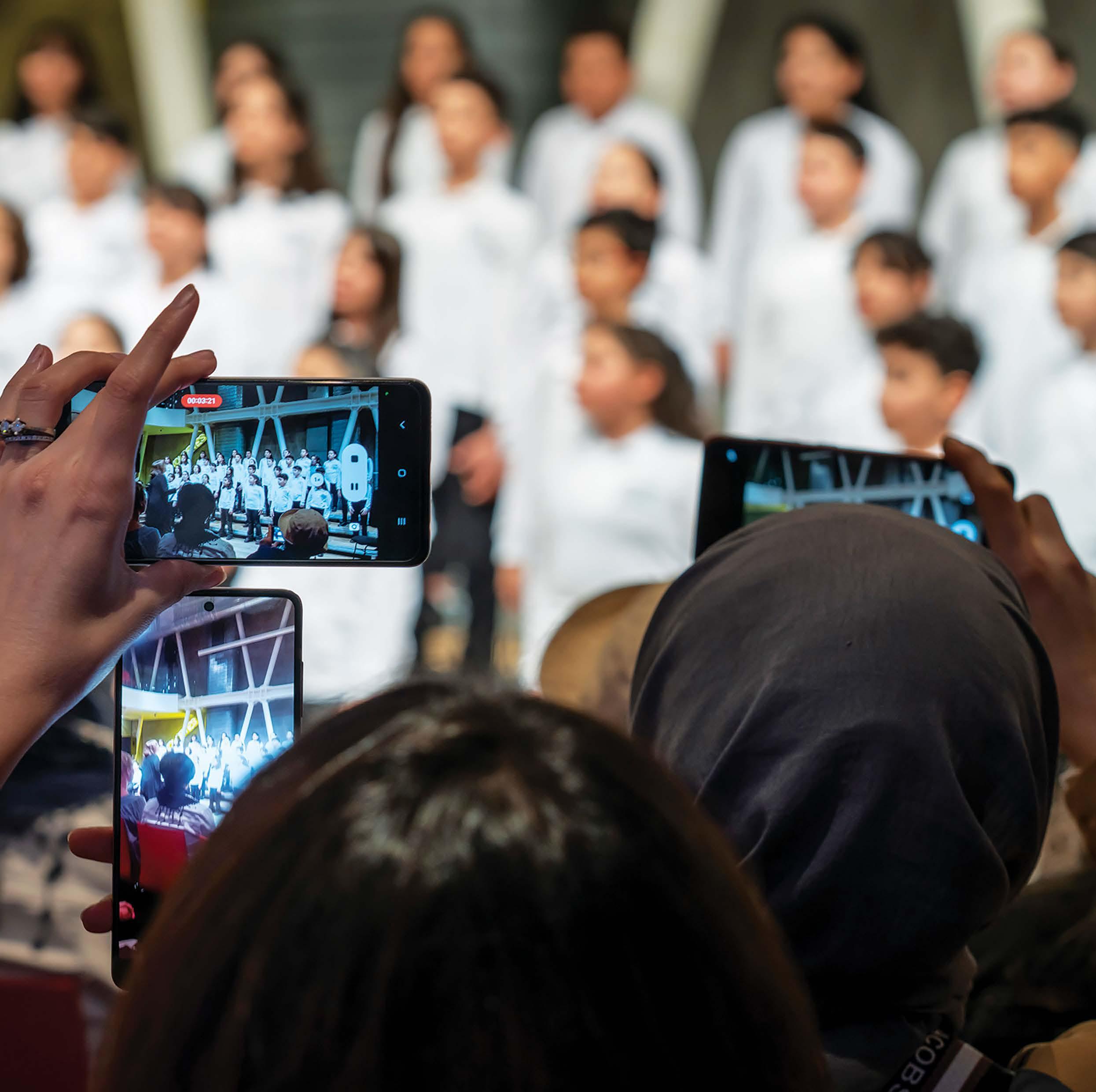
75
Borusan Çocuk Korosu at the WSCM 2023, Istanbul, Türkiye © Gülcan Acar


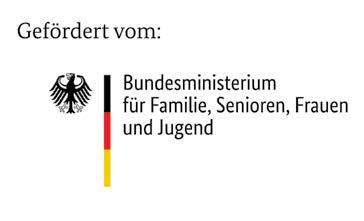

76 2024 CHORAL ACTIVITIES FESTIVALS TRAINING COURSES AND MORE EVENTS www.EuropeanChoralAssociation.org Calendar 2024 Cooperation Events of ECA Events Under ECA Label European Choral Association c/o Haus der Kultur Weberstr. 59a, 53113 Bonn, Germany Tel: +492289125663 www.EuropeanChoralAssociation.org @EuropeanChoralAssociation @ECA_EC @europeanchoralassociation @eca-ec @EuropeanChoralAssociation January 22-28/01/2024 Walter Strauss Chhoral Conducting Masterclass Ankara (TR) April 11-13 /04/2024 17-20/04/2024 Festival di Primavera Montecatini Terme (IT) July dates to be announced EuroChoir Varna (BG) 2-7/07/2024 Study Tour to the 100th Anniversary of the Lithuanian Song Celebration Vilnius (LT) 8-14/07/2024 International Choral Festival Barcelona Barcelona (ES) 14-21/07/2024 European Seminar for Composers Aosta (IT) 21-28/07/2024 Singing Bridges Novi Sad (RS) August 7-11/08/2024 Arctic Boys Choir Festival Bodø (NO) 18/088/09/2024 World Youth Choir summer session 2024 with the National Youth Orchestra of Germany Germany and Italy September 13-15/09/2024 (Inter)national Congress for Choral Conductors Puteaux (FR) 14-20/09/2024 Study Tour to Georgia and/or Tbilisi (GE) 20-26/09/2024 Study Tour to Armenia Yerevan (AM) October 25-27/10/2024 Fosco Corti International Competition for Choral Conductors Turin (IT) © 2022LeadingVoices. Ph: Anna van Kooij



















 Edited by Richard Kutner, USA
Edited by Richard Kutner, USA











































 Michael J Anderson, IFCM Former President
Michael J Anderson, IFCM Former President


 María Guinand IFCM Vice-President
María Guinand IFCM Vice-President





































































 REIJO KEKKONEN Singer and publisher, Helsinki, Finland
REIJO KEKKONEN Singer and publisher, Helsinki, Finland









 Edited by Karen Bradberry, Australia
Edited by Karen Bradberry, Australia















